Commemorative postage stamps Program
210 years since the birth of Petar II Petrović Njegoš
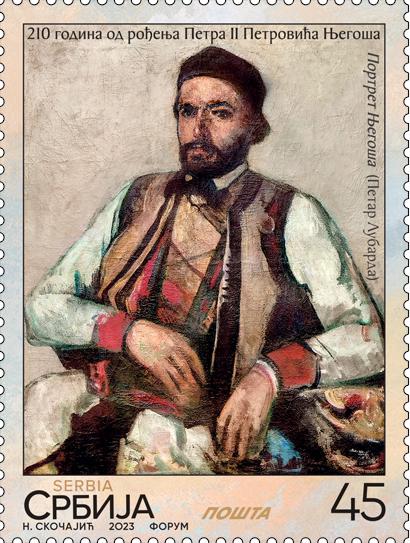
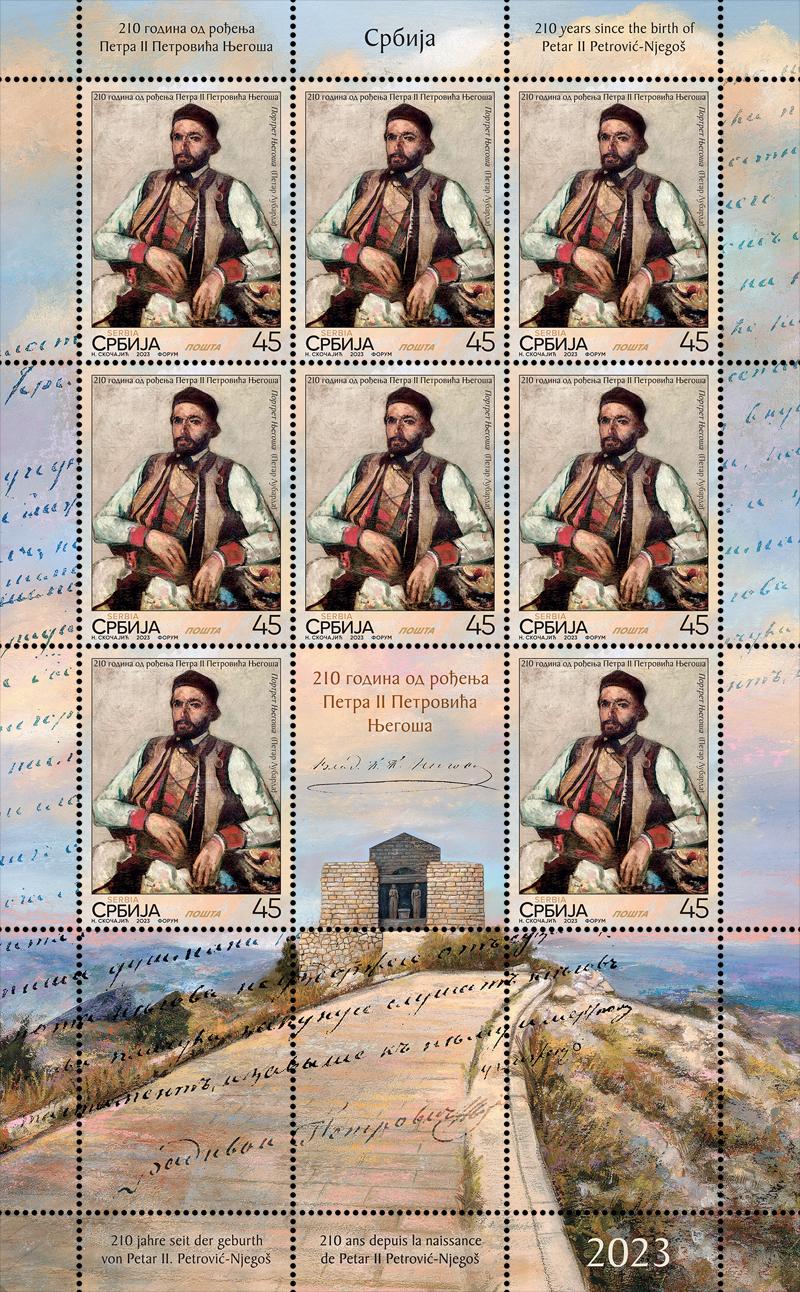
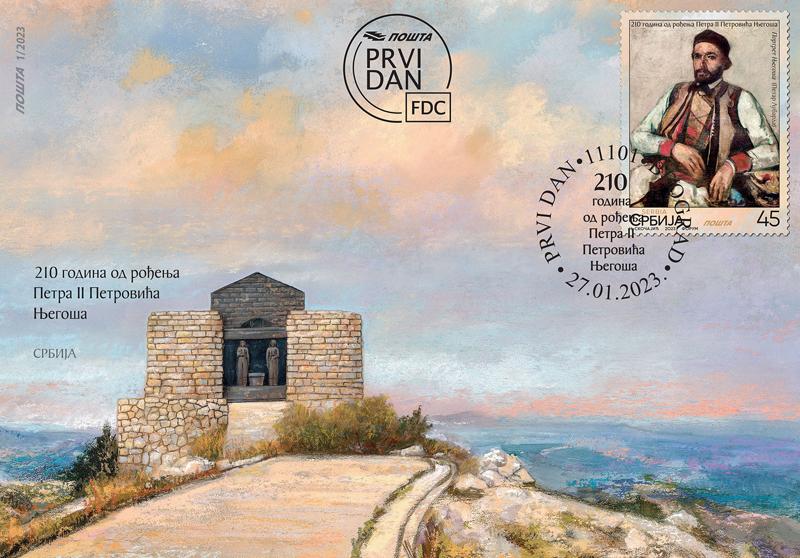
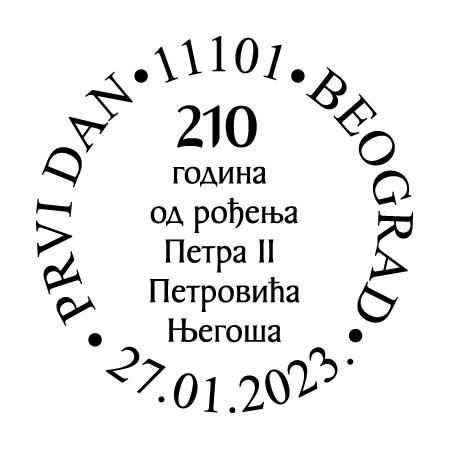
Petar II Petrović Njegoš (November 1, 1813 – October 19, 1851) was an Orthodox Montenegrin and Highland Prince-Bishop and head of Old Montenegro and Highland from 1830 to 1851. He was one of the greatest poets and philosophers of this region.
Njegoš was a charismatic and striking historical figure, but at the same time he was also a deeply enlightened and thought-provoking figure, which is evidenced primarily by his literary work. Respected as a ruler, he is best remembered as the author of the epic poem "The Mountain Wreath", which is considered one of the greatest masterpieces of European and world literature.
He was born in the village of Njeguši, near Cetinje, and after the death of his Uncle Petar I, he became the spiritual and secular leader of Montenegro.
He worked for the unification of Montenegrin tribes and the establishment of a centralized state. He introduced regular taxes, and his reign was marked by efforts to expand the territory of Montenegro.
He collected folk songs, which he published in the collection "The Serbian Mirror". A considerable number of his shorter poems, odes and epistles were published in the periodicals of that time. Although he had no formal schooling, through reading and reflection, Njegoš developed spiritually and shaped his artistic expression more deeply and completely, so in the last seven years of his life he created three of his most important pieces: "The Ray of the Microcosm", "The Mountain Wreath" and "False Tsar Šćepan the Little". His works have been translated into several languages, including Japanese.
Petar II Petrović Njegoš died in 1851. He was buried in Lovćen at the place where the Mausoleum designed by Ivan Meštrović is located today.
Stamp motif: Portrait of Njegoš, Petar Lubarda, 1940s, dimensions 96 x 80 cm, oil on canvas, private collection
Motif on the vignettes and on the envelope: Mausoleum of NJegoš on Lovćen designed by Ivan Meštrović , Miroslav Nikolić
Professional cooperation: Association of Writers of Serbia
Graphic realization of the issue: Nadežda Skočajić, academic graphic designer
Serbia – Germany: 140 years of the Trade Agreement and the Consular Convention
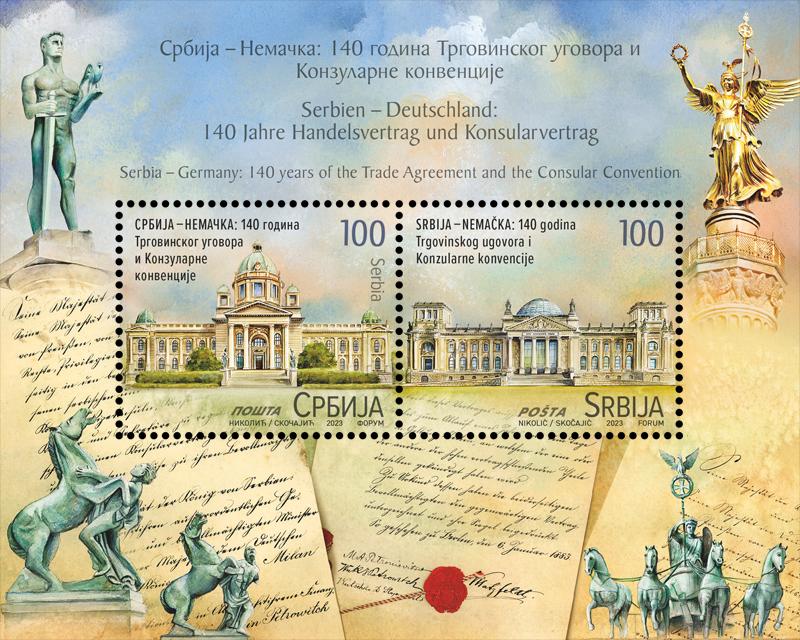


Serbia and Germany established official relations shortly after the Berlin Congress in 1871. The first agreements between the two countries were concluded in January 1883 – the Trade Agreement and the Consular Convention. After the conclusion of these agreements, the first investments of German capital in the Serbian economy began, primarily in mining and industry. Economic relations between the two countries, insignificant in the first decades, experienced expansion during the Customs War between Austria-Hungary and Serbia (1906–1912), when the German market became an alternative to the Austrian market for a large part of Serbian exports. By 1914, 10 agreements were concluded between Serbia and Germany, primarily with the aim of further improving trade and consular relations.
It is interesting that Serbia, even before signing the first official agreement with Germany in 1883, already had an agreement with one German state, Bavaria, with which Serbia concluded a Consular convention on August 25, 1870, even before gaining formal independence.
Expert collaboration: Embassy of the Republic of Serbia in Germany
Artistic realization of the issue: Miroslav Nikolić and Nadežda Skočajić, Academic Graphic Artist
150th Anniversary of the birth of Nadežda Petrović
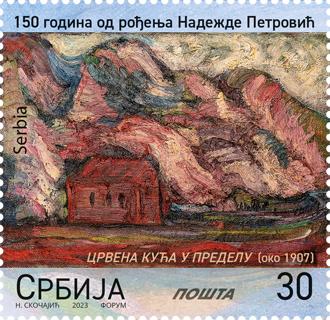
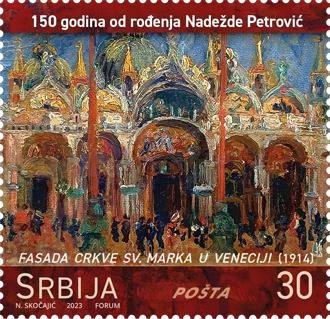



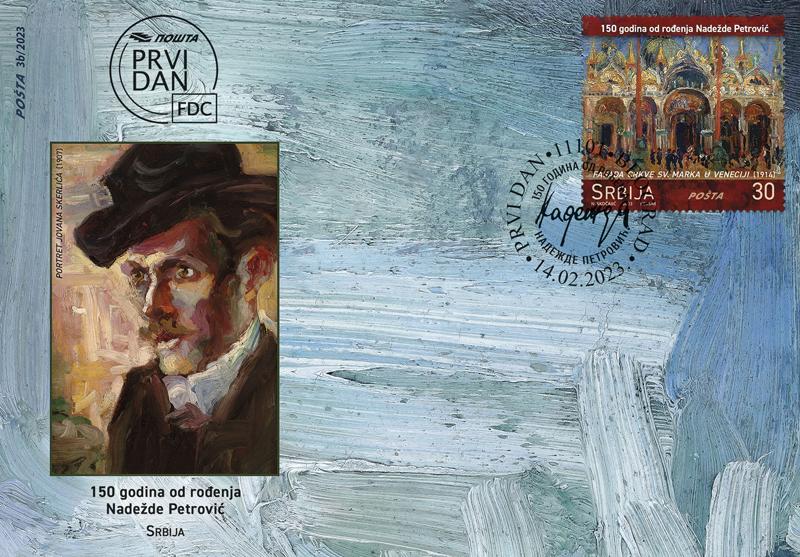


Nadežda Petrović (Čačak, October 11, 1873 – military hospital near Valjevo, April 3, 1915) comes from distinguished families important for Serbian history. Educated as a painter in Belgrade under Đorđe Krstić and Kiril Kutlik, and then in Munich under Anton Ažbe and Julius Exter, she was a pioneer of modern art, a drawing teacher at the Higher Women’s School in Belgrade, an art critic, the author of a theatre play, one of the founders of the Circle of Serbian Sisters, the Serbian Art Association and the Paris League for the National Rights of Oppressed Peoples, the first Serbian woman to be engaged in photography. She organized the work (1905) and exhibition (1907) of the Yugoslav Art Colony.
She stayed in Rome (1907) and Paris (1910-1912), followed the Venice Biennale and other prestigious art exhibitions in Europe. She exhibited independently and at joint art reviews in our country and around the world. She brought aid to peoples under Turkish occupation and led protests against the annexation of Bosnia and Herzegovina (1908). She spoke about the rights of Serbs and other enslaved Slavic peoples at meetings in our country and, thanks to her knowledge of French, German and Russian, abroad as well. She was a volunteer nurse in the Balkan Wars and the First World War. She reached the top in everything she passionately devoted herself to. Her works are the pride of our most prestigious museums, galleries and private collections. Her work belongs to the movements of Art Nouveau, Symbolism, Expressionism, Impressionism and Fauvism, and in a certain way Abstract Art. Educated and gifted, with clearly expressed views of an artist, intellectual and humanist, she managed to remain herself and belong to everyone.
To make our sorrow over the bad fate of Nadežda Petrović, an unsurpassed painter and unsurpassed patriot, i.e. over the fact that she died in the tension of her creative powers, even greater, and for the Serbian history of art an irreparable loss, this selection of paintings, with which the Post of Serbia marks the 150th anniversary of her birth, convincingly testifies to its artistic values. These are masterpieces in every respect, executed in an impressive drawing style, colourfully ringing, pictorially juicy, expressionistically strong and convincing, with strokes that, with their immediacy, freedom and freshness, confirm the artist who poured her soul into her work.
Motifs on stamps: Red house in the countryside (1907); The facade of the Church of St. Mark in Venice (1914); Red Peonies (1913). Motives on the vignettes: Prizren (1913); Anđa in the yard (1910–1911); Landscape (1907); Shepherd plays the fife (1906). Motifs on the envelopes: Cleaning caterpillars (1906); Portrait of Jovan Skerlić (1907); Sisters (1905).
Expert collaboration: Ljubica Miljković and Nikola Kusovac
Graphic realization of the issue: Nadežda Skočajić, academic graphic designer
100 years since the founding of the Novi Sad Fair
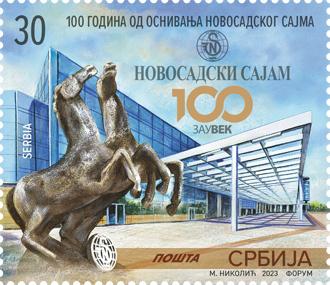


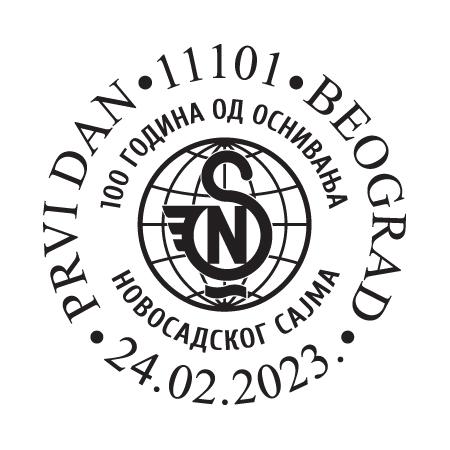
From August 11 to 26, 1923, the First Novi Sad Exhibition was held, which marked the beginning of organizing fair events in Novi Sad and is considered the first in the existence of the Novi Sad Fair.
Until 1939, exhibitions were held at the old Fairgrounds in Šumadijska street, and the jubilee, 10th fair and exhibition were opened in 1940, at a new location, in today´s Hajduk Veljkova Street, where the Fair is still located today.
After the end of the Second World War, with the aim of restoring agricultural production, in 1948 the First Agricultural Exhibition was held in Novi Sad, which very quickly became the trademark of the Novi Sad Fair.
Over the decades, the Agricultural Fair has gained exceptional fame and international reputation. With the construction of the ”Master“ Congress Centre, started in 2001 and opened in 2006, the Novi Sad Fair created the conditions for organizing modern fairs, with an emphasis on service business.
On an area of 226,000 square meters, of which 60,000 square meters are pavilions, with around 20 events and 500,000 visitors a year, the Novi Sad Fair has been the best representative of Novi Sad, Vojvodina and Serbia for a whole century, promoting the greatest achievements in agro-industry, hunting, energy, sports, tourism. The International Agricultural Fair has become the agribusiness event of the region, with the largest and longest fair tradition.
Expert collaboration: Novi Sad Fair
Artistic realization of the issue: Miroslav Nikolić
200 years since the arrival of Vuk Karadžić in Germany
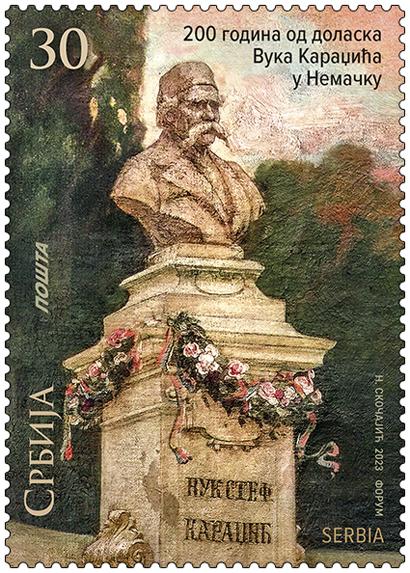
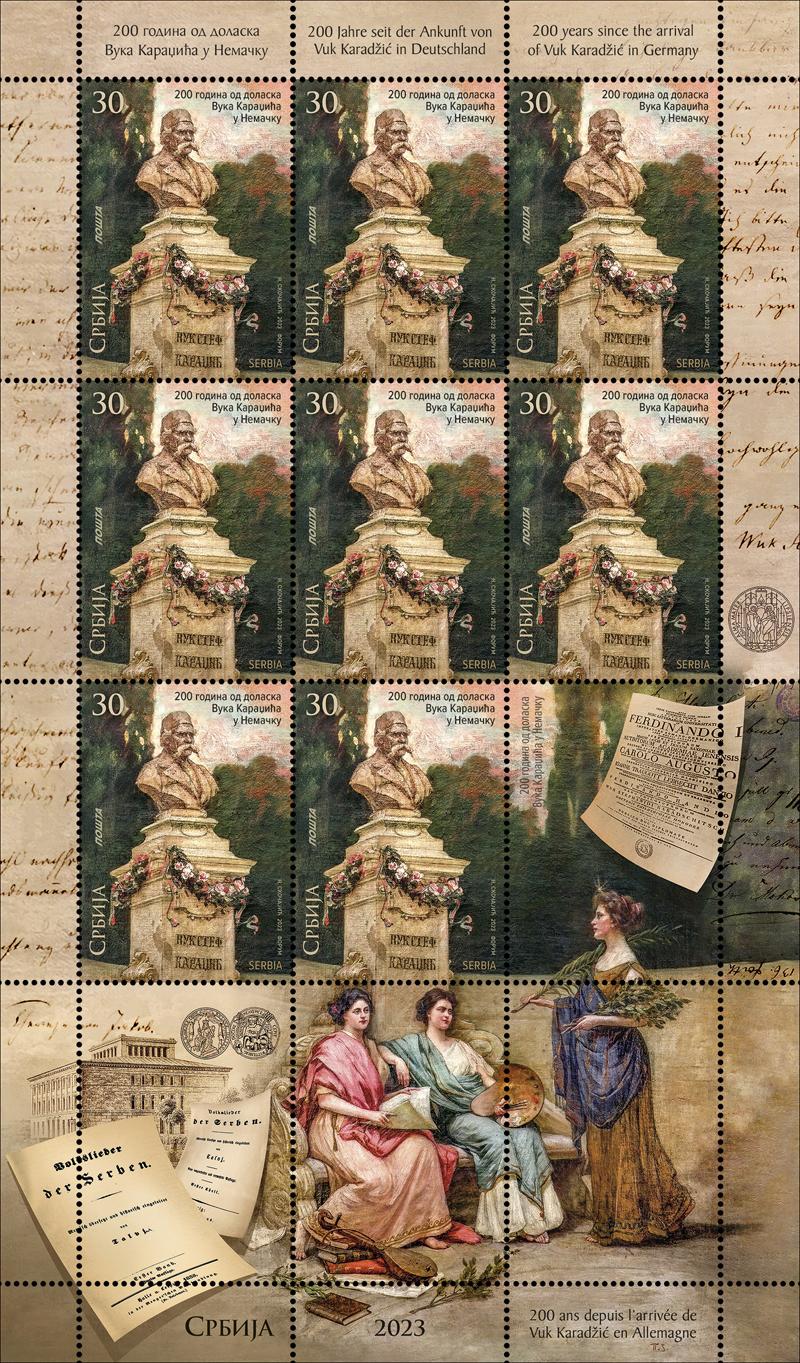


This year marks the 200th anniversary of the first arrival of Vuk Stefanović Karadžić in Germany. Apart from this significant jubilee, which marks one of the most important turning points in the cultural and social ties of modern Serbia with Europe, the issue also celebrates the concrete ties between Serbia and Germany and the Serbian and German people. By accepting Vuk, his language reforms and high appreciation of the Serbian folk art collected by Vuk, 200 years ago Germany became the first and most important ambassador and friend of Serbian culture and the Serbian people in Europe.
Vuk Karadžić, the creator of the modern Serbian language, philologist, writer and anthropologist, based his work on modernizing spelling and orthography on the orthographic principle of the German linguist Johann Christoph Adelung – "write as you speak, and read as it is written".
The support for Vuk's life's work provided by the poet Johann Wolfgang Goethe and the Grimm brothers testifies to the strong cultural and friendly ties between the two peoples in the era of the creation of modern European states, and the traditional great respect between the Serbian and German people, even through all the turbulent historical moments is a pledge for a new era of sincere friendly relations and exceptional cooperation in the 21st century.
Motif on the stamp and on the vignettes: "Apotheosis of Vuk Karadžić", Pavle Paja Jovanović, 1897, oil on canvas, private collection. Motifs on the vignettes and the sheets: The degree of Doctor of Philosophy that Vuk received from the University of Jena, the cover pages of "Serbian Folk Songs" translated by Therese von Jakob, printed in Halle and Leipzig in 1833 and 1853, the emblem of the University of Leipzig, the university building and double seal of "Martin Luther" University in Halle. In the background of the sheets: a letter from Therese von Jakob to Vuk Karadžić from Halle in 1824, in which she writes to him about her translations of Serbian folk songs, the prescriptions that Vuk received from German doctors in 1823, and a letter in which Vuk thanks the Royal Learned Society in Göttingen for the honour shown (SASA Archive, Belgrade). Motif on the envelope: the logo and the building of the University of Jena, in the background the Doctor of Philosophy degree that Vuk obtained from the University of Jena.
Professional cooperation: Association of Writers of Serbia
Graphic realization of the issue: Nadežda Skočajić, academic graphic designer
185 years of diplomatic relations between Serbia and Russia
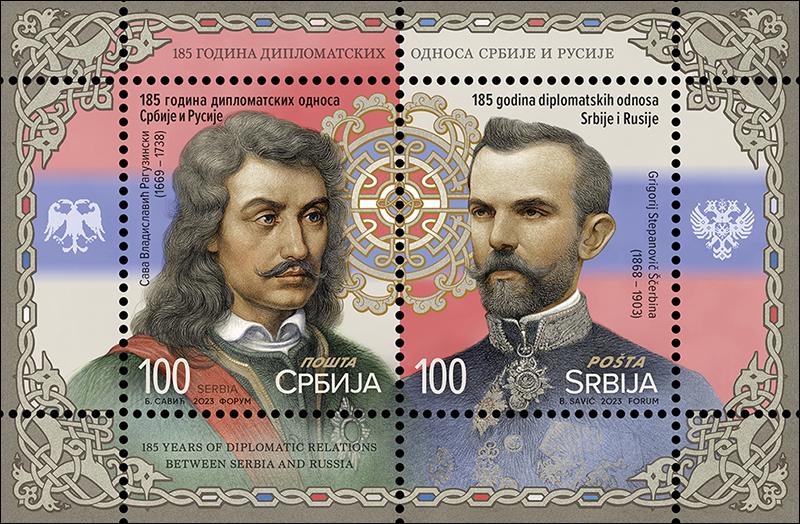
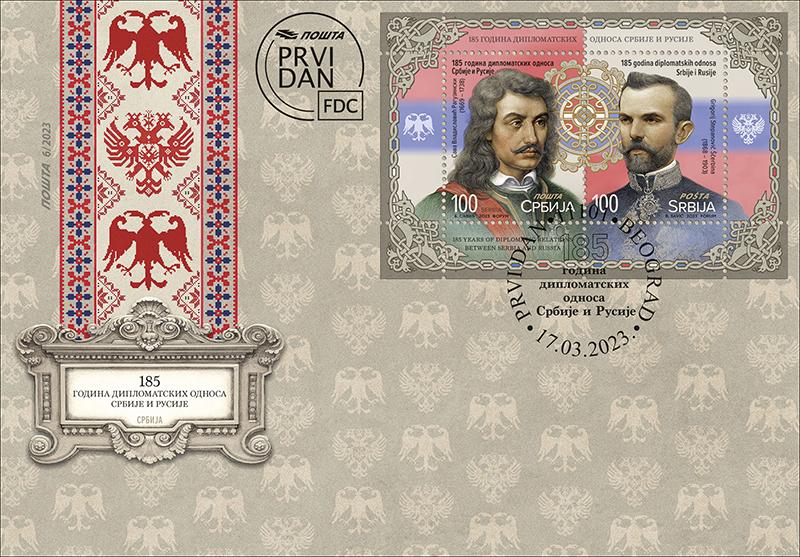
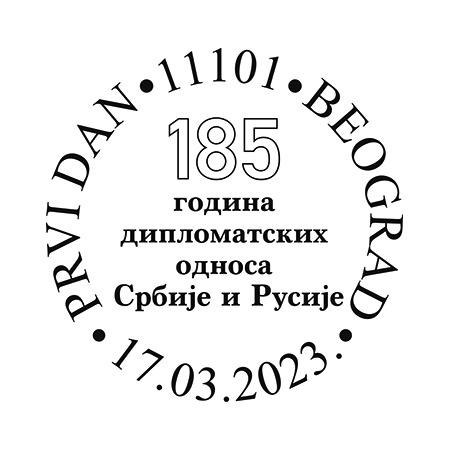
2023 marks the 185th anniversary of the establishment of diplomatic relations between Russia and Serbia. The opening of the Russian consulate in Serbia in 1838 is an important link in the history of relations between our countries, which over the centuries, despite episodes of strong cooperation, were limited by temporary missions.
One of such distinct pages of shared history is dedicated to the famous Serb from Herzegovina – Sava Vladislavić Raguzinski (1669–1738), counselor to Peter the Great, founder of the diplomatic service of the Russian Empire, a person who had a great influence on the further development of the foreign policy principles of the largest Orthodox monarchy in history, among whom the support of Slavic coreligionists in the Balkans always had a special place.
Among the Russian diplomats who worked in Serbia right after the establishment of diplomatic relations, the first consul in Kosovska Mitrovica, who should be highlighted, Grigoriy Shcherbina (1868–1903), earned great respect among the Serbs with his self-sacrificing work and tragically died as a result of an attack by an Albanian fanatic. In his will, the Russian consul pointed out: "Serbs in Kosovo should be protected, because Kosovo is Serbian."
Expert collaboration: The Russian House in Belgrade, Embassy of the Russian Federation in the Republic of Serbia
Artistic realization of the issue: Boban Savić MA, academic painter
Easter
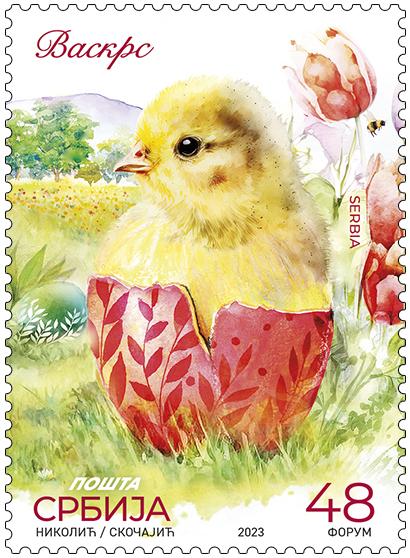
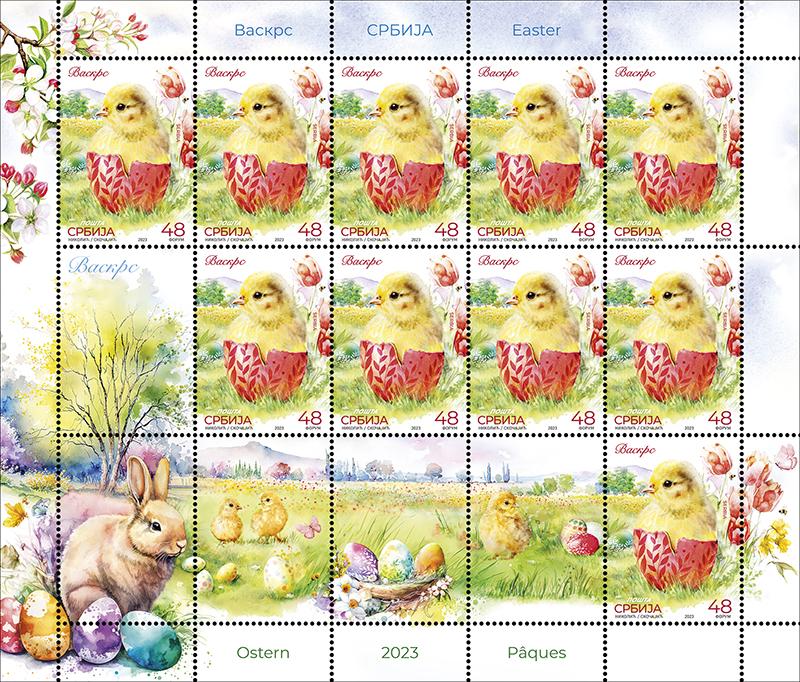
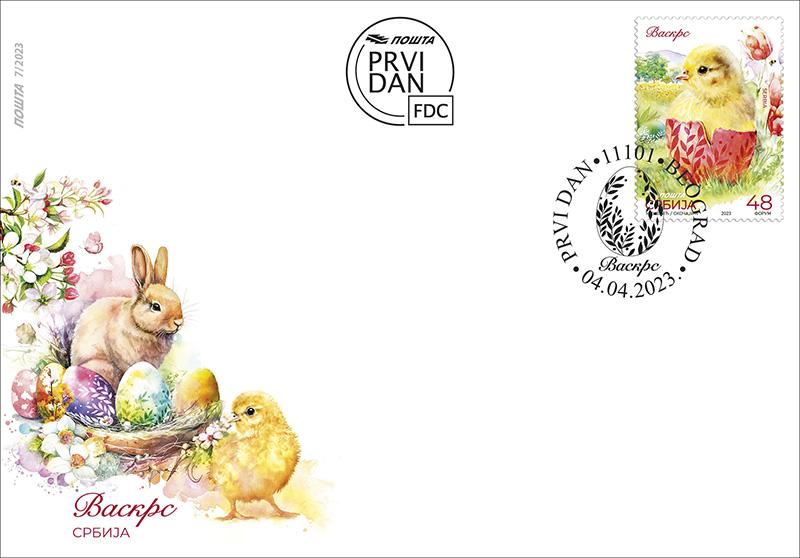
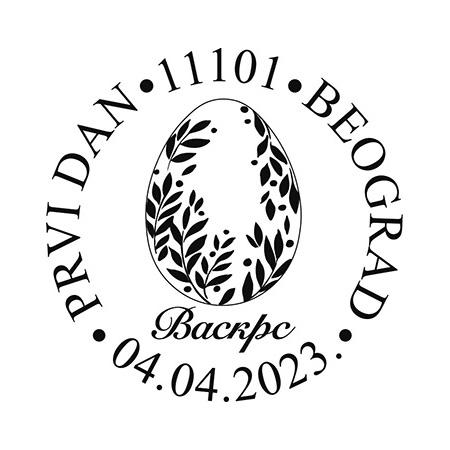
The most important and greatest Christian holiday – the day of eternal joy, the Resurrection of Christ, is celebrated in memory of the day when Christ, the Son of God, defeated death.
Easter is a moving holiday, it is always celebrated on a Sunday, and the date is calculated based on the date of the full moon that preceded Christ´s Resurrection in 30 BC and can fall between 4 April and 8 May according to the Gregorian calendar, or between 22 March and 25 April according to the old Julian calendar. The decision to celebrate the Resurrection of Christ was made at the first Ecumenical Council in Nicaea in 325. The Orthodox Church celebrates Easter according to the Julian calendar.
Easter is preceded by a seven-week fast, and the last week before Easter is called Great. Many folk customs are associated with this week, and the one that children love the most is colouring and giving eggs, which are actually a symbol of Resurrection. The first egg is dyed red and in many parts of our country this egg is called «guardian» and is kept all year, until the next Easter. The Day of Christ´s Resurrection is celebrated with a solemn liturgy in churches, and the believing people are greeted with the words: «Christ is Risen», «Truly He is Risen».
Artistic realization of the issue: MA Nadežda Skočajić, Academic Graphic Artist and Miroslav Nikolić
90 years since the foundation of the Russian House in Belgrade
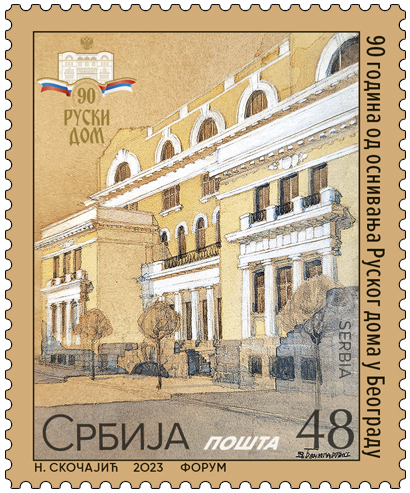
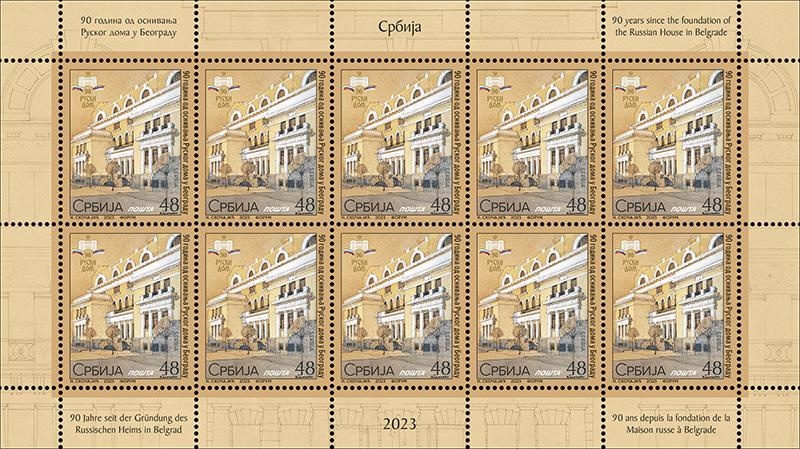
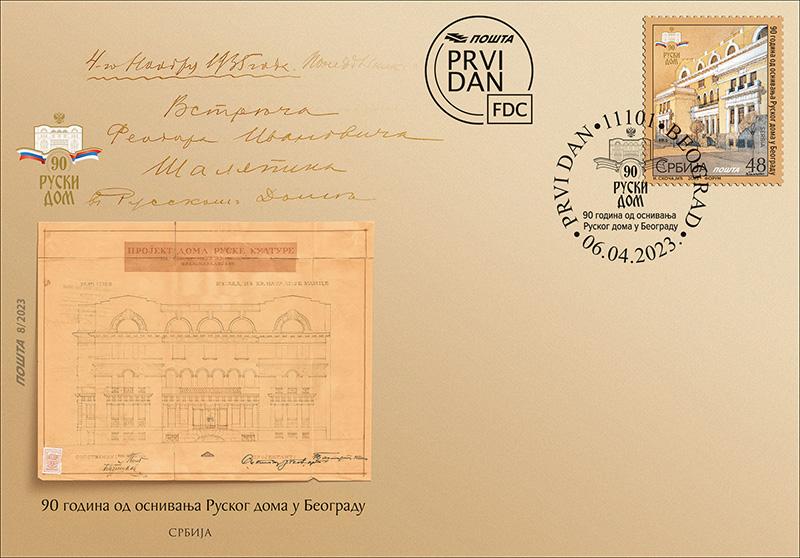
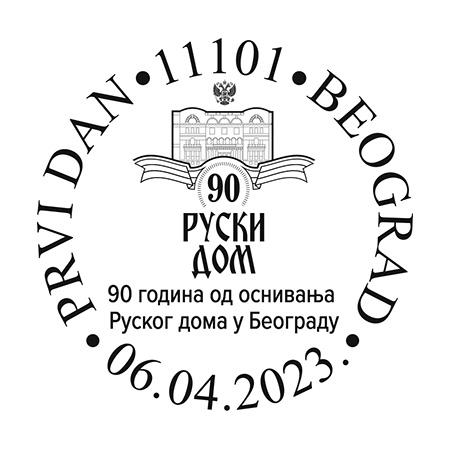
Exactly 90 years ago, on April 9, 1933, the oldest Russian Cultural Centre - the Russian House in Belgrade – was opened in the then capital of the Kingdom of Yugoslavia. The author of the project was the Russian architect and emigrant Vasily Fyodorovich von Baumgarten. From the moment of its establishment, the Russian House became not only an educational, cultural and scientific centre of the Russian Belgrade, but also a home, the doors of which are always open to the Serbian public.
Today, the representative office of Rossotrudnichestvo in Belgrade respects the famous tradition and actively promotes Russian culture by realizing various projects and extremely popular events among the Belgrade audience. Thus, in 2022 alone, over 300 events were held in the Russian House!
Expert coollaboration: The Russian House — Russian Centre of Science and Culture in Belgrade
Graphic realization of the issue: Nadežda Skočajić, academic graphic designer
Industrial heritage of Serbia
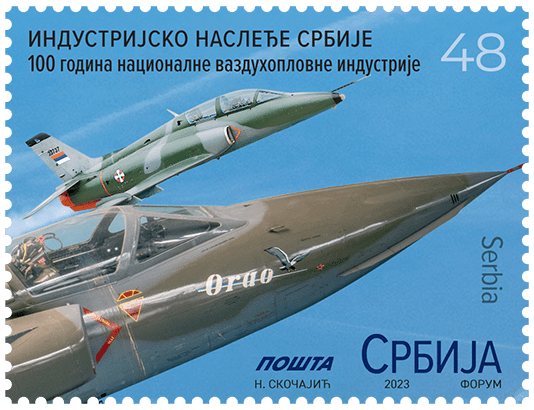
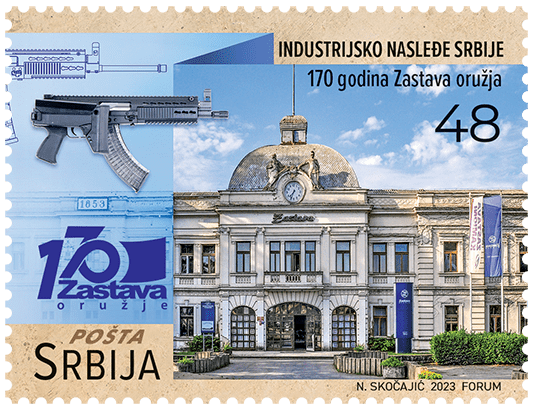
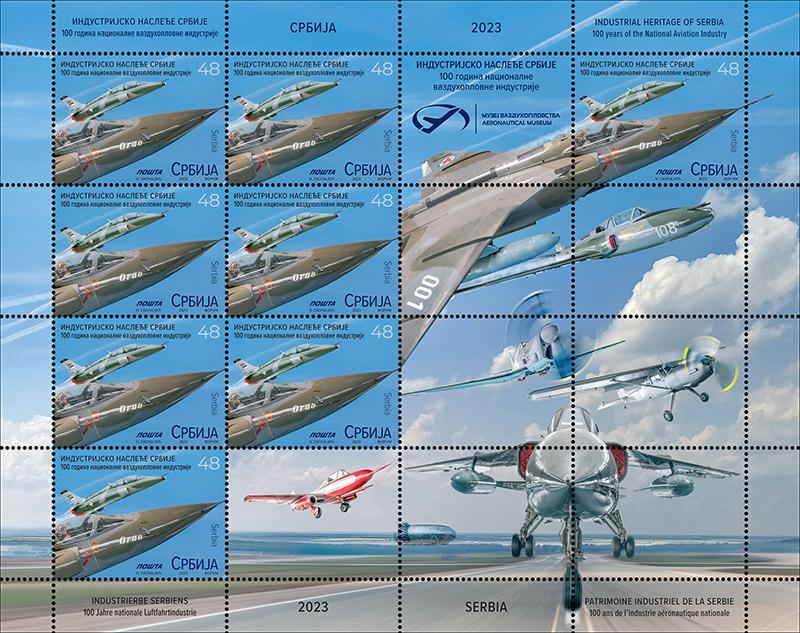
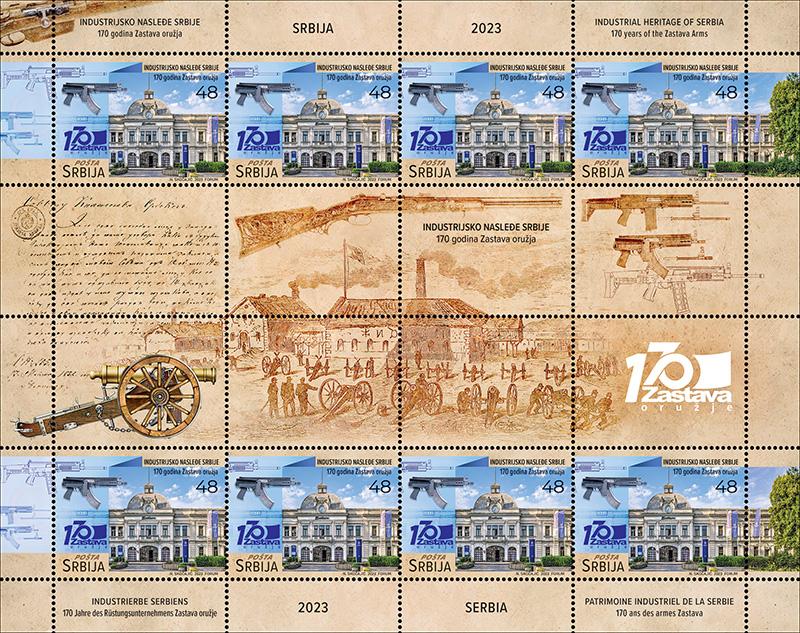
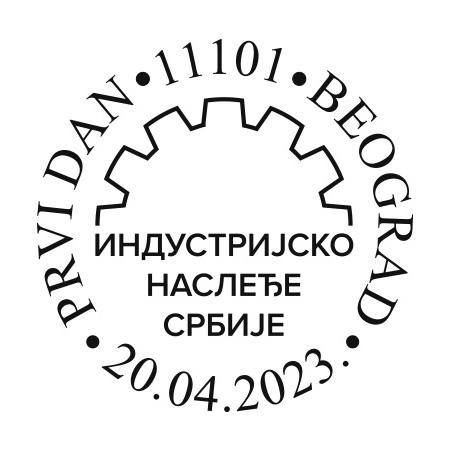

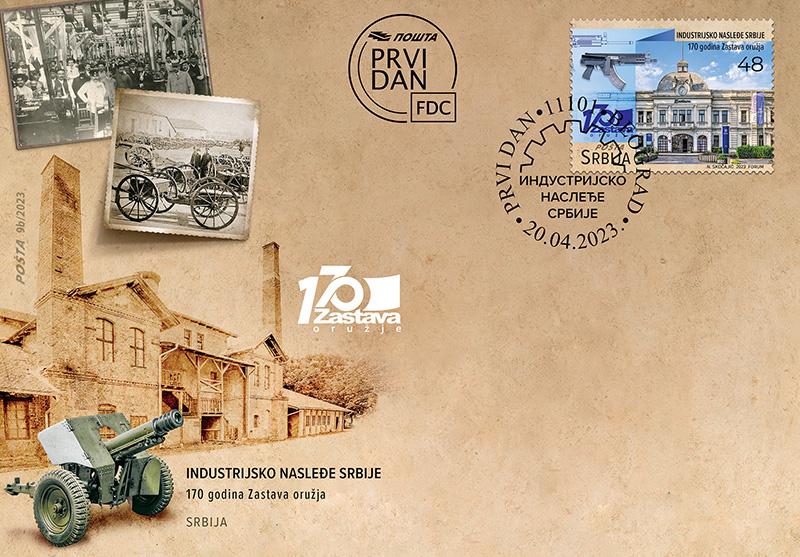
100 years of the national aviation industry
Industrial heritage is an important part of cultural heritage and refers to tangible and intangible heritage created in the period from the beginning of industrialization to the present day. Industrialization as the bearer of modernization at the end of the 19th and beginning of the 20th century in these areas marks the entry into the modern age, and therefore its legacy today represents an important part of the national identity.
In 2023, the Republic of Serbia is celebrating a significant jubilee that few countries can boast of – the century of the national aviation industry. From 1923 until the beginning of the Second World War, over 1,500 aircraft were produced in six aircraft factories and twenty aircraft component factories, which accounted for more than half of the aircraft in operational use in the Yugoslav kingdom.
The aviation industry was a significant factor in the development of a predominantly agrarian country and opened the way for the conquest of new technologies and their practical application. A special curiosity is the fact that airplanes were first produced in our country, and only then motor vehicles.
Highly educated professionals from the interwar period formed the basis for the continued development of the aviation industry after the war. In the changed social and political circumstances, airplanes, helicopters and supporting equipment were produced that formed the backbone of the Air Force, sports and commercial aviation, and there were no significant results on the international market.
Carried by a long tradition, aviation companies in Serbia preserve the continuity of aircraft production in this area and achieve significant results on the domestic and world markets.
Expert collaboration: Aeronautical Museum, Belgrade
170 years of the Zastava Arms
Industrial heritage is an important part of cultural heritage and refers to tangible and intangible heritage created in the period from the beginning of industrialization to the present day. Industrialization as the bearer of modernization at the end of the 19th and beginning of the 20th century in these areas marks the entry into the modern age, and therefore its legacy today represents an important part of the national identity.
In 2023, Serbia is celebrating a significant anniversary – 170 years of the existence of the arms industry, i.e. the existence of the Zastava Arms factory, which is its originator and historical bearer. On 27 October, 1853, the first Serbian cannons were cast in Kragujevac. Since then, the Serbian arms industry, specifically through the plants in Kragujevac, has been growing, developing and introducing numerous innovations: the first steam engines were used in Topolivnica (1851), the Military-Crafts School was established – the forerunner of dual education (1854); the first quality control was introduced (1856); the first industrial electric lighting was introduced (1884).
At the World Economic Exhibition in Paris (1889), the weapons factory from Kragujevac was awarded with several medals. The Mauser-Milovanović rifle, Kokinka, created in 1880, in its modified version M1880/1907, was declared the best rifle in the world in 1907. The modernå rifle and ammunition factory was officially put into operation on 27 October, 1928.
After the Second World War, the turning point in the development of the factory is the development of the family of automatic weapons M70 Kalashnikov system. Today, Zastava Arms produces state-of-the-art weapon systems and 95% is export-oriented.
The M19 modular automatic rifle and the M20 modular automatic rifle, in 7.62x39 mm and 6.5x39 mm Grendel calibers, were included in the armament of the Serbian Armed Forces in August 2020 and represent the future in the development of the Serbian arms industry.
Expert collaboration: Zastava Arms Marketing
Artistic realization of the issue: MA Nadežda Skočajić, Academic Graphic Artist
The City of Niš
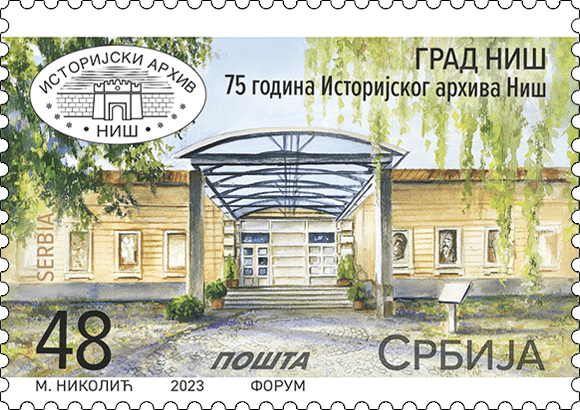
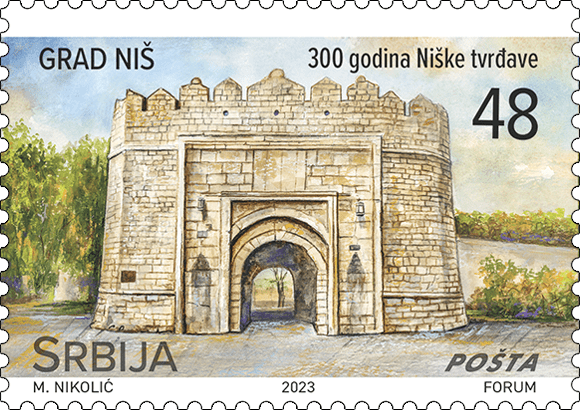
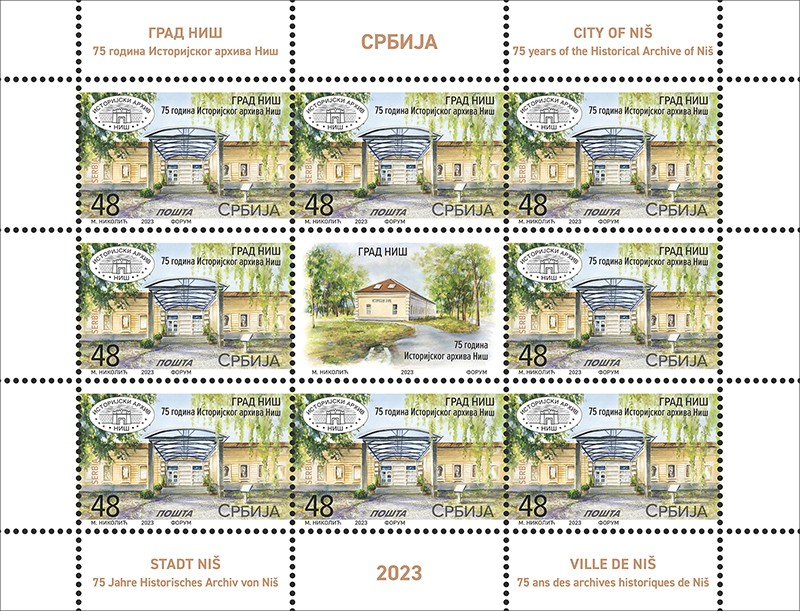
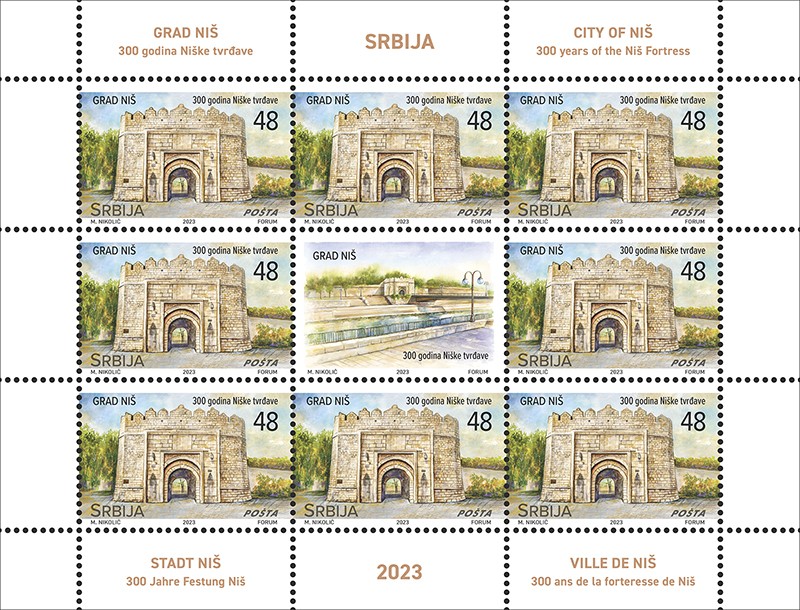
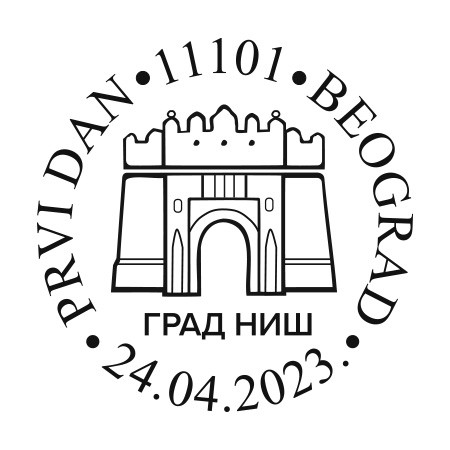

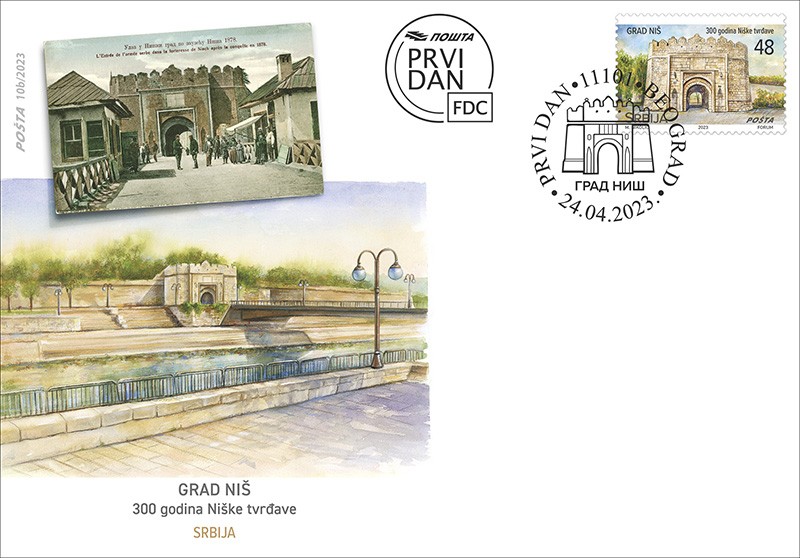
The city of Niš is the largest city in southeastern Serbia and the third city in terms of population in the Republic of Serbia. It is the seat of the Nišava administrative district and one of the most important economic, cultural and educational centers in the country. Throughout history, due to its geostrategic position, Niš has played an important role in the Balkans and in this part of Europe.
75 years of the Historical Archive of Niš
One of the most important cultural institutions of the city of Niš is the Historical Archive of Niš. This year marks the 75th anniversary of the Historical Archive of Niš, an institution that takes care of archival materials in the territory of the city of Niš and the municipalities of Aleksinac, Gadžin Han, Doljevac, Merošina, Ražanj, Svrljig and Sokobanja. The historical archive of Niš was founded on 24 April, 1948. In its depots, in over 800 funds and collections, more than 4,000 long metres of archival material created in the period from 1737 to the present day are kept. The archive has been engaged in publishing since 1982. The archive has so far published 16 monographs and 23 issues of the journal “Peščanik” for historiography, archives and humanities. In addition to taking care of archival materials and publishing, the Historical Archive of Niš also organizes lectures, promotions and exhibitions.
The Historical Archive of Niš has been awarded several times as a cultural institution, and a special place is the Golden Archive award from 2008, awarded by the Aleksandar Arnautović Foundation.
Motif on the stamp and vignette: Building of the Historical Archives of Niš
Motifs on the first day cover: Copper print – the oldest document in the Archive that describes how the Ottomans surrendered the city to the Austrians in 1737 and the Law on State Archives adopted at the session of the National Assembly of the Kingdom of Serbia in Niš in 1898.
300 years of the Niš Fortress
The most important building that Niš has is the fortress, whose cultural, historical and touristic importance is priceless. In 2023, the city of Niš will celebrate three centuries since the construction of the Niš Fortress. Located on the right bank of the Nišava River, it is a witness to the turbulent times of the first half of the 18th century. The construction was started by the Ottomans in 1719, and it was completed in 1723, when a plaque with an inscription was placed that adorns its main gate, Stambol Gate. The fortress, which covers 22 hectares, has a polygonal base with eight bastion terraces and four large gates. Within the fortress complex there are prehistoric, ancient and medieval settlements, important archaeological sites and monuments. Today, the Niš Fortress is a cultural monument of exceptional importance, where generations of Niš residents acquire basic knowledge from the stormy history of their city. During summertime, one of Niš residents’ favorite promenades and one of the city’s most visited tourist attractions turns into an important cultural centre where significant events such as Film Encounters and the “Nišville” International Jazz Festival take place.
Motif on the stamp, vignette and the first day cover: Istanbul Gate and view of the Niš Fortress
Expert collaboration: Historical Archive of Niš
Artistic realization of the issue: Miroslav Nikolić
EUROPA
Peace – The Highest Value of Humanity
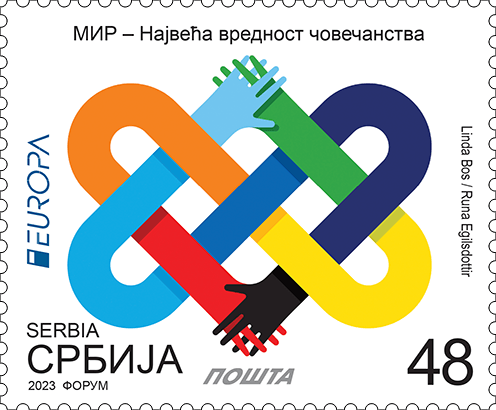
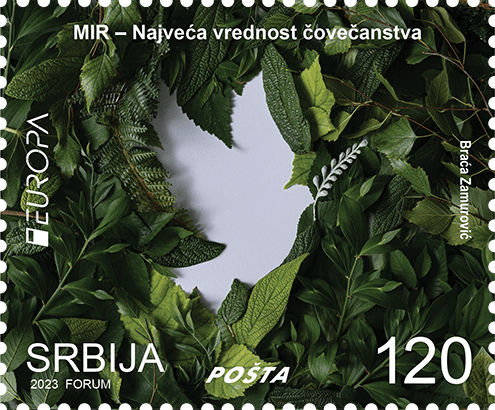
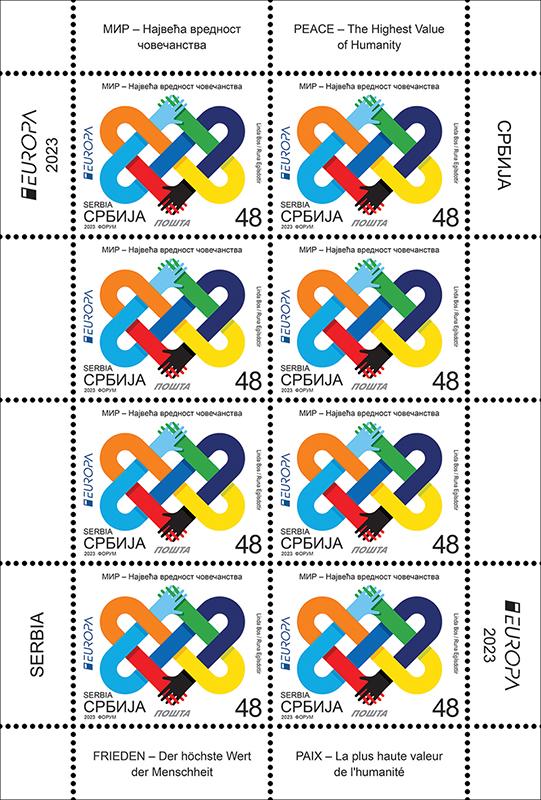

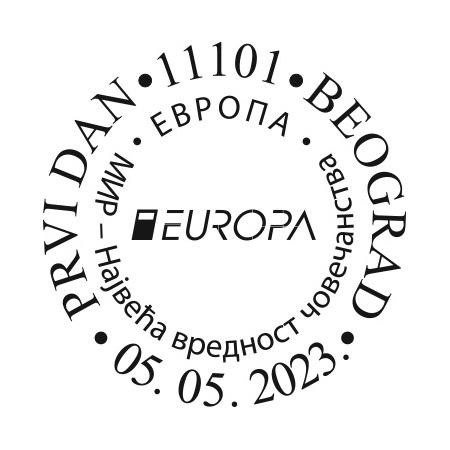
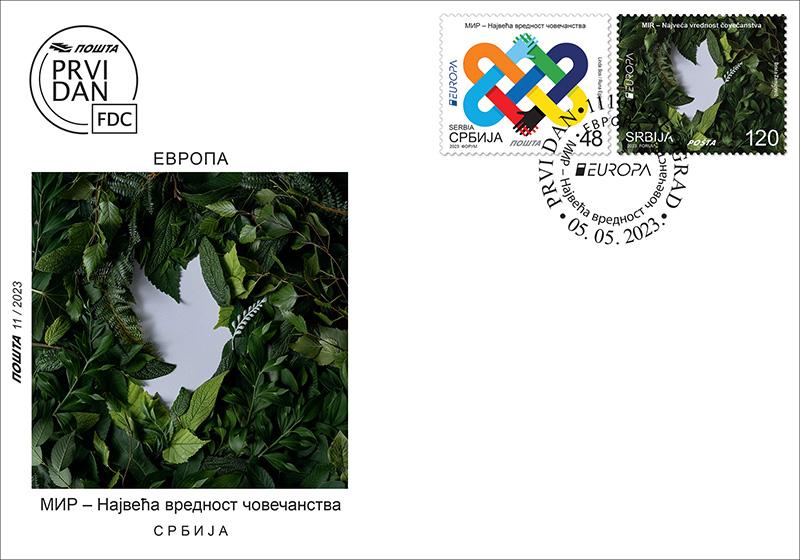
Life without fear of conflict, development of free society based on justice and freedom, mutual cooperation of people and nations of different cultures, customs and beliefs are not possible without global peace. Only in peace can societies based on the principles of justice, freedom and equality develop. That is why peace is the highest value of humanity and a common challenge for all people and nations and requires the cooperation and solidarity of all.
Bearing in mind the challenges of modern times and the current global circumstances, PostEurop, the association of postal operators of Europe, has decided that the motif of the traditional issue of commemorative postage stamps EUROPA in 2023 will be dedicated to peace as the highest value of humanity and will be shared by all members of the association. In a special competition in 2022, the jury of the PostEurop association chose the proposal for the motif of the Post of Luxembourg and it is the motif on the 48 dinars stamp of this issue. The motif was created by Linda Bos and Runa Egilsdóttir, and is a visual metaphor for a peaceful integrated society where people accept each other’s culture. It is inspired by the symbol of the Celtic love knot, with intertwined hearts, while the colour palette illustrates all the peoples of the world, and hands with intertwined fingers carry a message of mutual respect.
The motif on the second stamp of the issue is a vision of peace as the highest value of humanity, as an original artistic solution of every postal operator, so the motif on the 120 dinar stamp and the FDC envelope is the White dove of peace, an artistic solution by the world-famous artists from Serbia, the Zamurović brothers. The white dove is a universally recognizable symbol of peace that emerges with an olive branch from the dark forest, symbolizing all the security challenges of modern humanity, bringing hope that global peace, as a universal and highest human value, is still possible.
STAMP DAY
150 years of the first correspondence card of Serbia

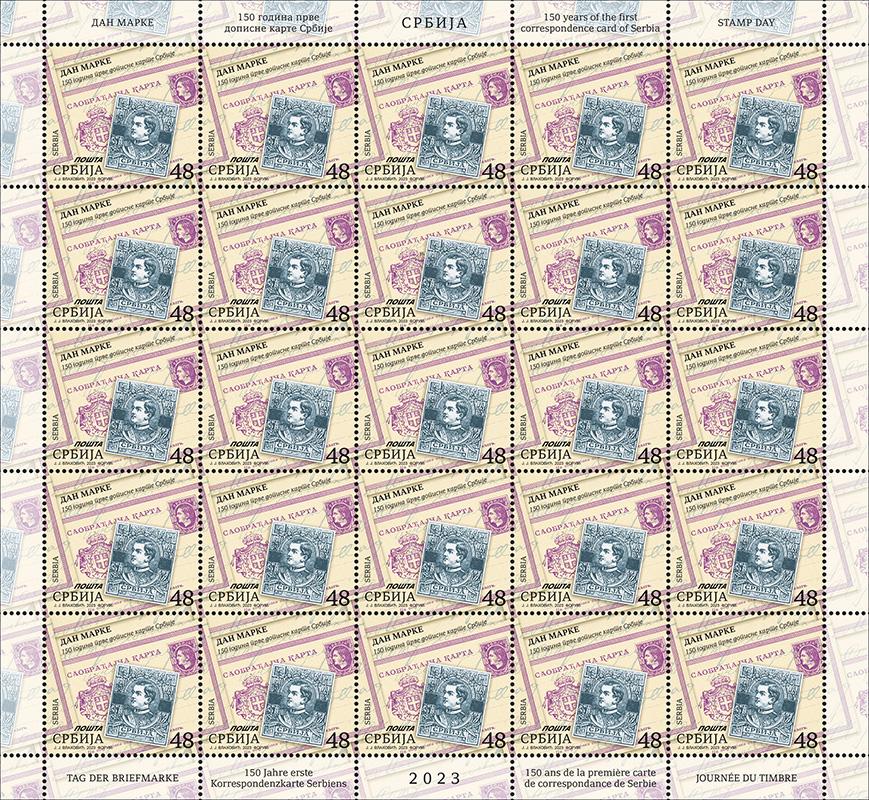

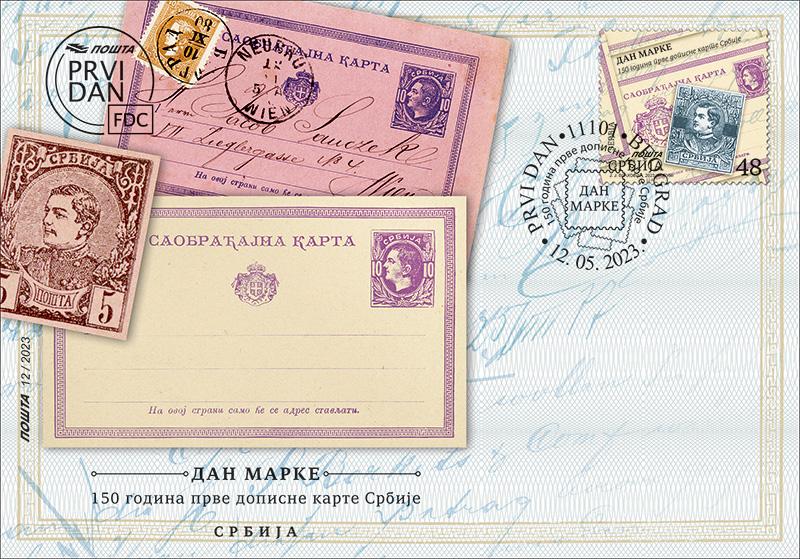
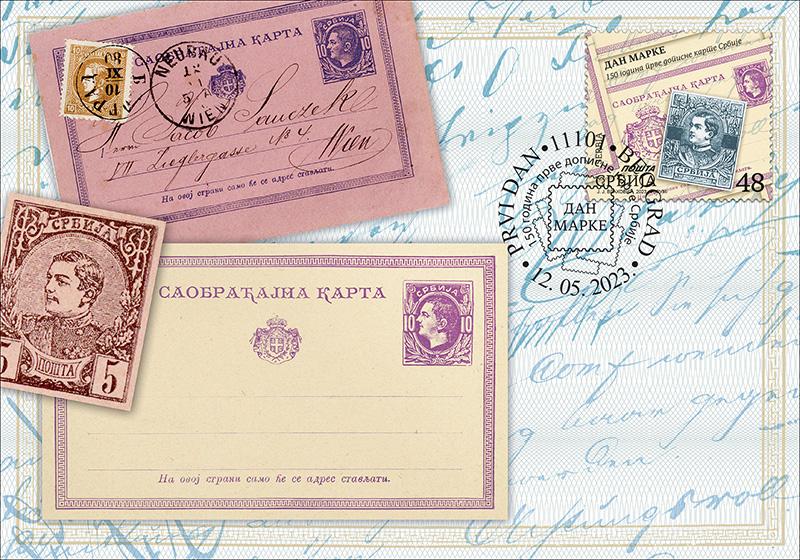
The first postal correspondence card in the world was put into circulation in Austria-Hungary on October 1, 1869, and for that time it represented an innovation in postal traffic. Recognizing the importance and need of correspondence cards, the Principality of Serbia decided to take this step less than four years later – in 1873. Previously, Prince Milan, by decree of October 23, 1871, authorized the Minister of the Interior to put into circulation traffic cards, i.e. correspondence cards, for domestic and international traffic, when he deems it necessary. The Ministry of the Interior was the first to put correspondence cards for domestic traffic into circulation, on July 13, 1873 (July 1 according to the old calendar.)
The first Serbian correspondence cards were printed in purple, on thin paper the size of 133x86 mm. The printed value mark is rectangular in shape and is the size of 18x22 mm, with a simple frame. In the centre is the head of Prince Milan in left profile on a coloured background in an oval frame, surrounded by laurel and oak branch. To the left and to the right of the oval frame are the marks of the value ”10”, and below it in the bow is the white inscription ”SRBIJA”. By the minister’s decision, two types of traffic cards were issued at the same time: simple cards and cards with a paid reply. The first correspondence cards of Serbia were printed at the State Printing Office in Belgrade.
Expert collaboration: Union of Philatelists of Serbia
Graphic realization of the issue: MA Jakša Vlahović, academic graphic artist
550 years since the birth of Nicolaus Copernicus

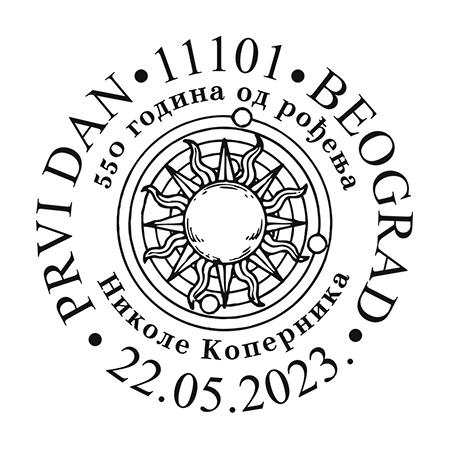
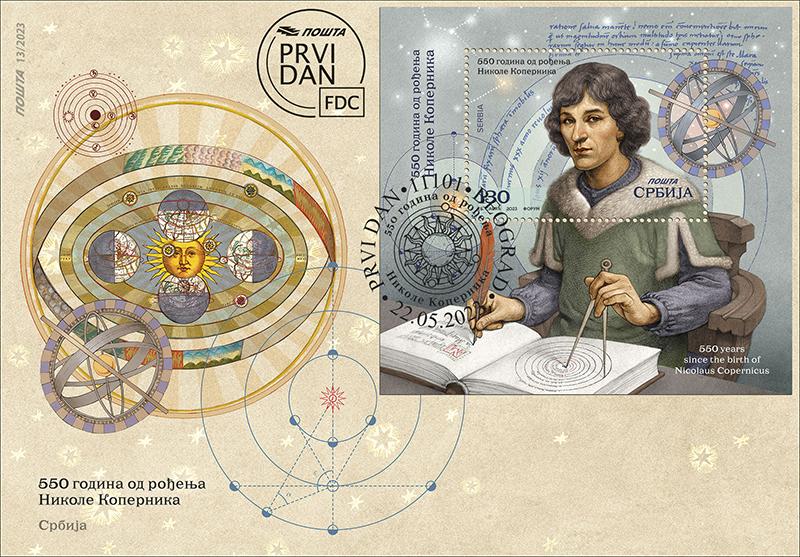
Nicolaus Copernicus (lat. Nicolaus CopernicusPolish: Mikołaj Kopernik; Toruń, February 19, 1473 – Frombork, May 24, 1543), Polish astronomer and mathematician, was the first scientist to formulate the heliocentric model of space bodies, claiming that the Earth revolves around its axis, while at the same time orbiting the Sun.
He received his academic education studying mathematics, medicine, astronomy, theology and canon law at the Jagiellonian University in Krakow and the University of Bologna. He belonged to the Catholic order of Jesuits and served as a priest in the town of Frombork, where he arranged an observatory from which he observed the movements of the celestial bodies.
Based on the results he reached by observing the celestial bodies, Copernicus wrote his capital scientific work ”On the Revolutions of the Heavenly Spheres” (lat. De revolutionibus orbium coelestium) in six volumes, which was published in Nuremberg in 1543, just before the scientist›s death. This work marked a revolutionary turning point in astronomy and was the impetus for the later capital scientific discoveries of Kepler and Newton.
The Copernican or heliocentric system, was quickly accepted in the scientific circles of his time, but it caused heated debates, conflicts and changes in wider social circles.
Marking the 550th anniversary of the birth of Nicolaus Copernicus, the Post of Serbia with this issue of commemorative postage stamps pays tribute not only to the great world and Polish scientist, but also to the historical, cultural, scientific and diplomatic ties and cooperation of the fraternal Slavic peoples of Serbia and Poland.
Expert collaboration: Embassy of the Republic of Poland in Belgrade
Artistic realization of the issue: Boban Savić MA, academic painter
75 years since the founding of Mathematical Society of Serbia
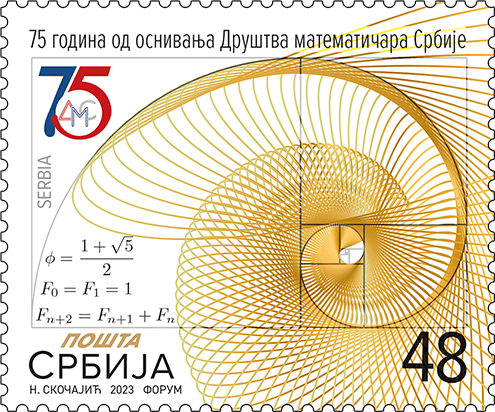
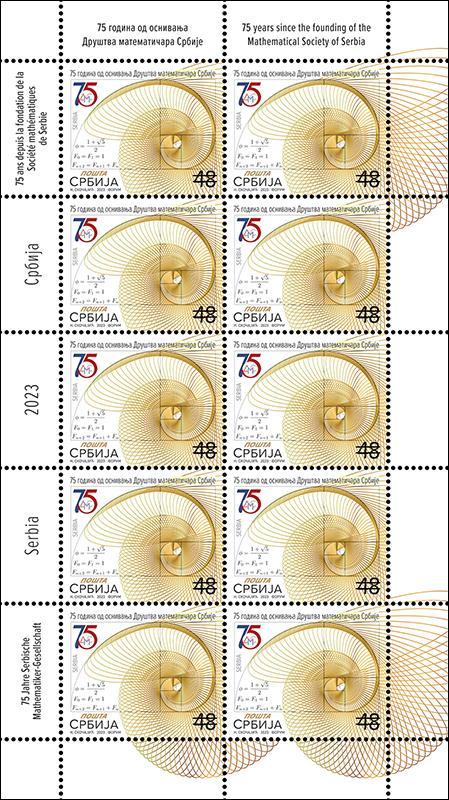
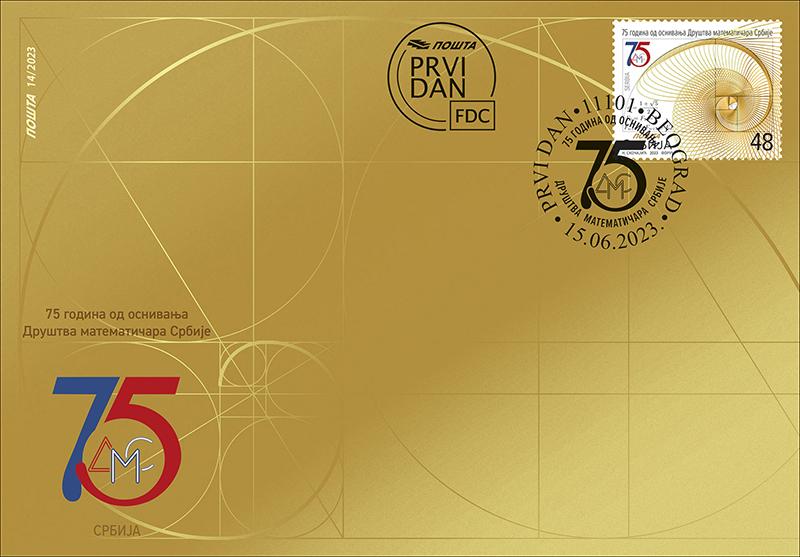
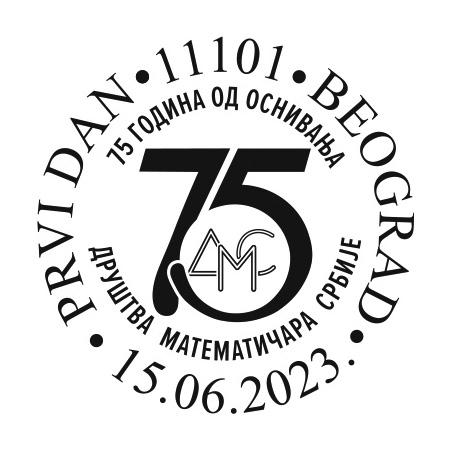
Друштво математичара Србије (ДМС) основано је 4. јануара 1948. године и ове године обележава 75 година рада. Носилац је бројних активности из домена математике и рачунарства на државном и међународном нивоу.
MSS initiated a series of activities aimed at improving the status of mathematics and mathematicians. On the initiative of MSS, the Mathematical Grammar School was established in Belgrade. The Society continuously works on the professional development of mathematics and informatics teachers through accredited seminars.
MSS is the holder and implementer of a large number of different projects, within which many open educational resources were created ("eCollection" platforms, "Final Exam", etc.). The "Final Exam" project was awarded at the international competition "Zero Project 2020" organized by the Essl Foundation and the United Nations in Vienna.
Competitions of young mathematicians organized by MSS are the oldest and most massive professional competitions for students in our country. MSS organizes summer and winter schools, as well as the trips for our students to 9 international Olympiads in mathematics and informatics, where they regularly achieve outstanding results.
MSS publishes the recognized scientific journals Matematički vesnik and The Teaching of Mathematics, the professional journal Nastava matematike, and two popular magazines for young people, Matematicki list and Tangenta. It organized 14 national congresses of mathematicians and supported the organization of more than 20 international symposia and conferences.
MSS is an active member of the International Mathematical Union, the European Mathematical Society and the Mathematical Society of Southeast Europe.
For its activities, in 2023, MSS was awarded the Sveti Sava Award and the Golden Sretenje Medal for exceptional contribution and achieved results in the system of education and science in the Republic of Serbia.
Expert collaboration: Mathematical Society of Serbia
Artistic realization of the issue: MA Nadežda Skočajić, Academic Graphic Artist
Каталошке информације
15. јун 2023.
Artistic realization of the issue: MA Nadežda Skočajić, Academic Graphic Artist
1239. 48,00 дин (вишебојна) 25.000
Sheet of: 10
На коверту са жигом ПД (FDC)
Нацрт: 1239. графички приказ златног пресека
Величина марке: 35 x 29 mm
European nature protection
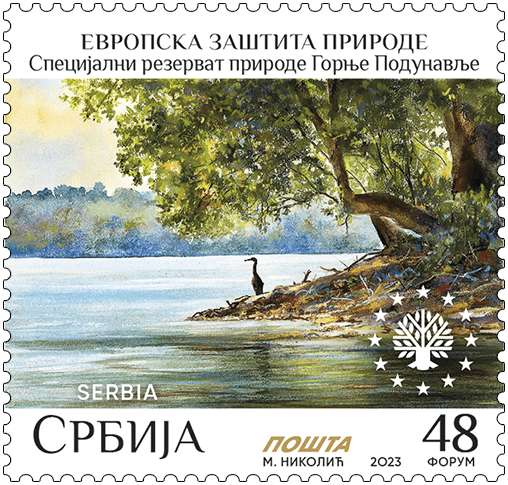
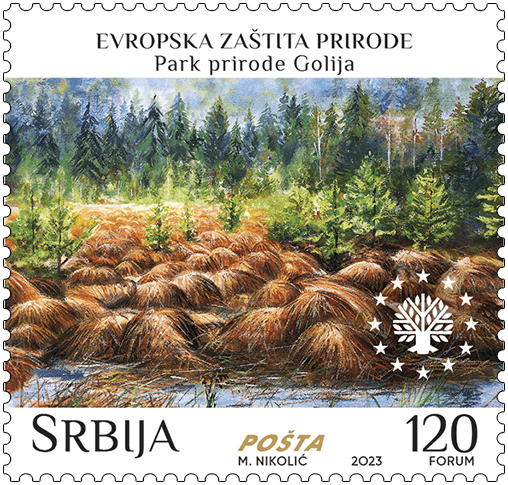
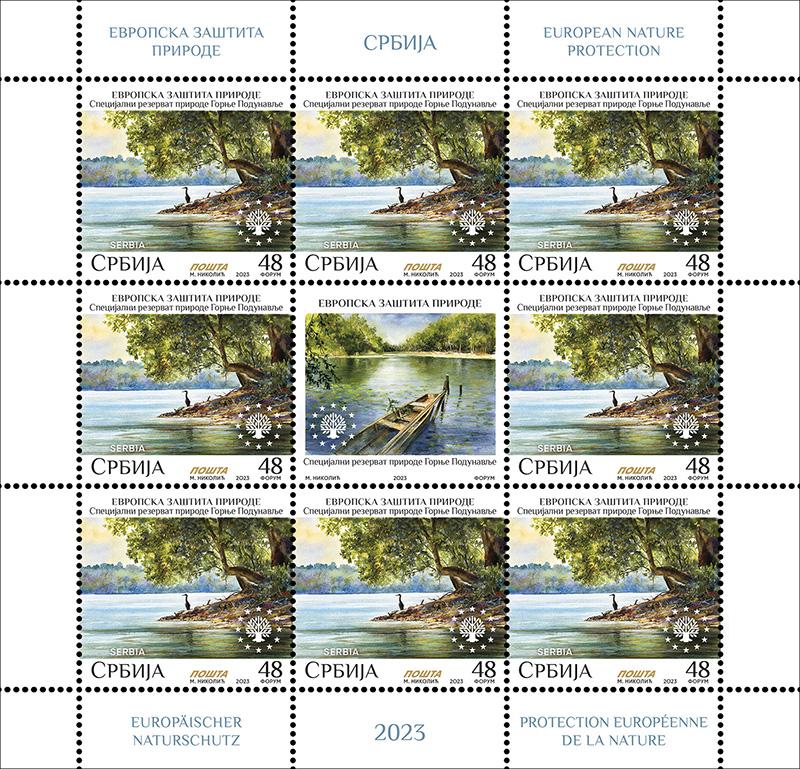
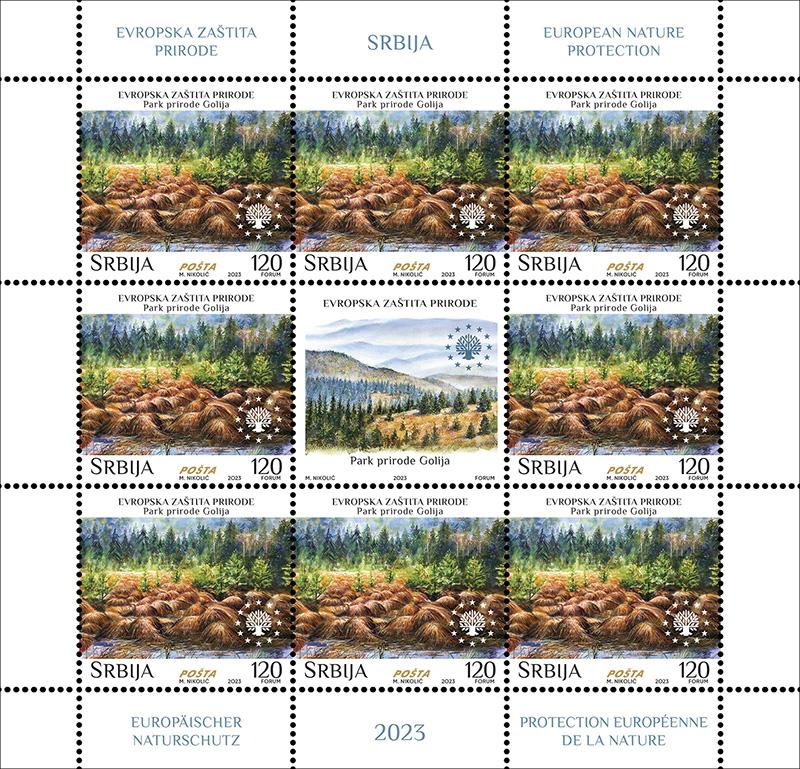
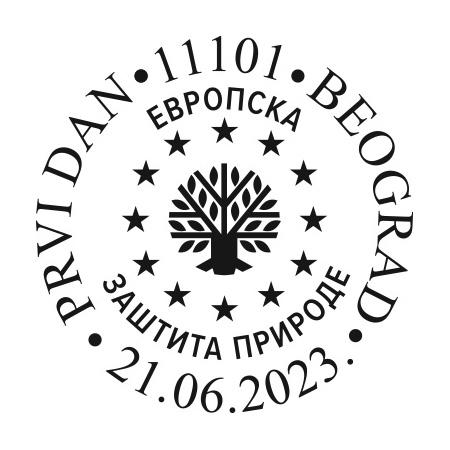

Upper Danube Special Nature Reserve
It covers the 64 km long left bank of the Danube, a lowland area with a flat and slightly undulating relief with meanders, backwaters, river dams and beams. Complexes of rite forests are interspersed with ponds, swamps, reed beds and cattails.
The Upper Danube region is home to over 1,000 plant species, 60 species of butterflies, 55 species of fish, 11 species of amphibians, nine species of reptiles, 230 species of birds, and 51 species of mammals. The reserve is an important breeding ground for fish, a nesting ground for white-tailed eagles (Haliaeetus albicilla) and black storks (Ciconia nigra), and there is also the largest habitat for the red deer (Cervus elaphus) and wild boar (Sus scorfa) in Serbia.
It was entered on the UNESCO World List of Biosphere Reserves in 2017, making it part of the “European Amazon” – the Mura-Drava-Danube Biosphere Reserve, which stretches across Austria, Slovenia, Hungary, Croatia and Serbia.
Golija Nature Park
Golija is adorned with beech and spruce rainforests, high mountain meadows and pastures, sinkholes, coves, dry valleys, pits and caves. The natural rarities of the Park are the tress and lakes, the largest of which are Košanin and Dajić, and the highest peak is Jankov kamen (1,833 m).
Clean and fast mountain streams are inhabited by brown trout (Salmo trutta), Danube barbel (Barbus balcanicus), common minnow (Phoxinus phoxinus) and European bullhead (Cottus gobio). In the abundance of plant life, there are also relics or endemics: Markgraf’s Alyssum (Alyssum markgrafi), Pancicia serbica, violet (Viola elegantula), Adamovic’s mullein (Verbascum adamovicii), Adamovic’s thymus (Thymus adamovicii). This is also home to reptiles and amphibians: the alpine newt (Ichthyosaura alpestris), the common frog (Rana temporaria), the common European viper (Vipera berus) and the horned viper (Vipera ammodytes), over 150 species of birds and a large number of species of mammals, such as the Eurasian pygmy owl (Glaucidium passerinum), Boreal owl (Aegolius funereus), Hazel grouse (Bonasa bonasia), Lesser blind mole-rat (Spalax leucodon), Alpine shrew (Sorex alpinus), Red fox (Vulpes vulpes), wolf (Canis lupus) and brown bear (Ursus arctos).
Together with the Studenica monastery, Golija has been declared a UNESCO World Biosphere Reserve.
Based on the Protection Study of the Institute for Nature Conservation of Serbia, in 2001 the Government of the Republic of Serbia declared Golija and Upper Danube to be protected areas of the first category of protection, as areas of exceptional international and national importance.
Expert collaboration: Institute for Nature Conservation of Serbia
Artistic realization of the issue: Miroslav Nikolić
Каталошке информације
21. јун 2023.
Artistic realization of the issue: Miroslav Nikolić
1240. 48,00 дин (вишебојна) 25.000
1241. 120,00 дин (вишебојна) 25.000
Табак: 8
На коверту са жигом ПД (FDC)
Нацрт: 1240. Специјални резерват природе Горње Подунавље
Нацрт: 1241. Парк природе Голија
Величина марке: 35 x 33,35 mm
150 years of metrology in Serbia

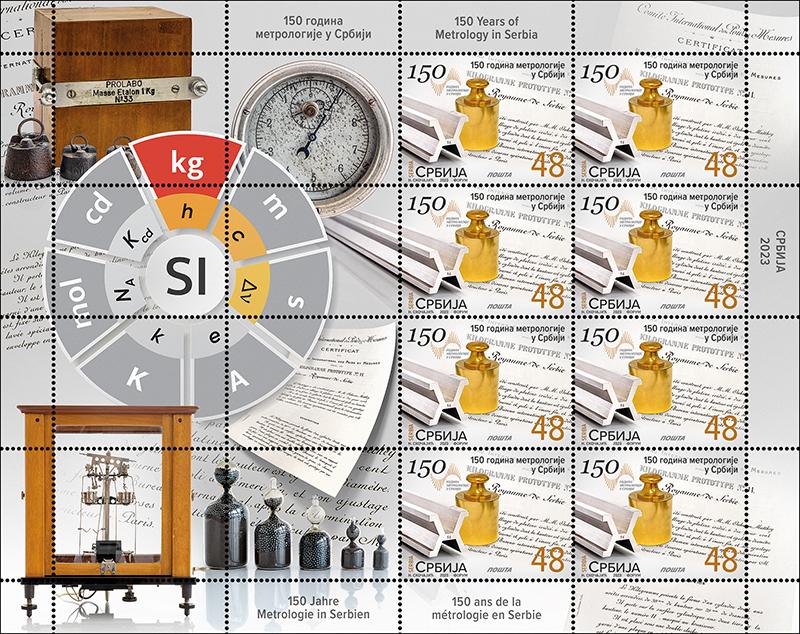
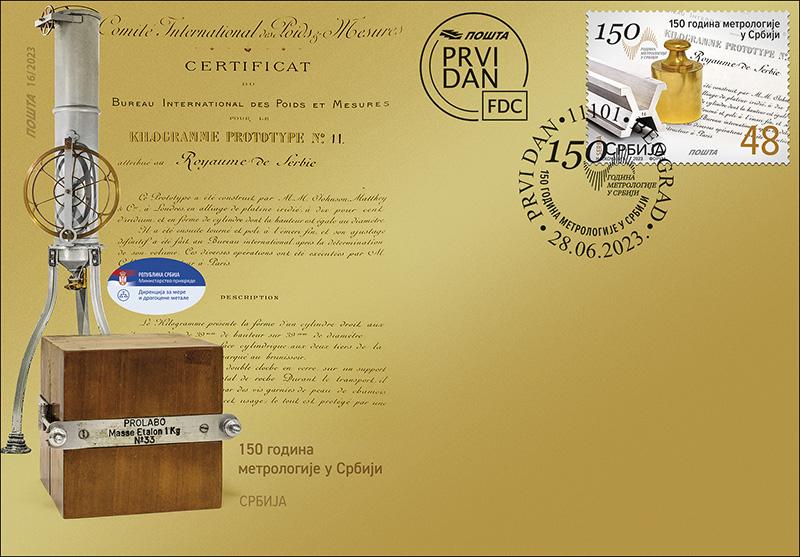
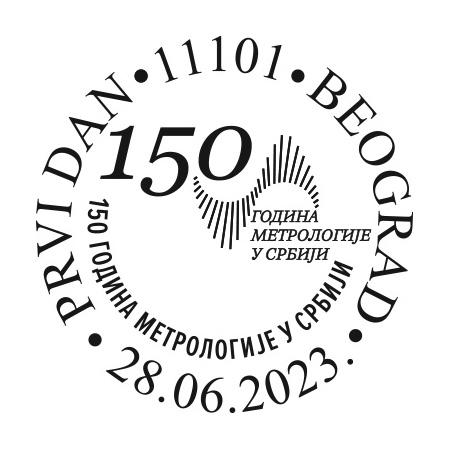
Metrology in Serbia has a long tradition. The National Assembly of the Principality of Serbia voted, on December 1, 1873, the Law on Measures, which officially accepted the decimal metric system in Serbia and established the Department of Measures at the Ministry of Finance of the Principality of Serbia with the task of taking care of the control of measurement and comparison of measurement units. Already in 1879, the Principality of Serbia joined the international "Meter Convention", which was established in 1875, which created a framework for the industrial, commercial and social application of established measures, both in the country and at the international level.
The historical heritage of the Department of Measures of the Principality of Serbia is preserved today by the Directorate of Measures and Precious Metals – an administrative body within the Ministry of Economy, whose task is to develop and ensure the application of appropriate measurement infrastructure, to ensure accurate, reliable and honest measurements for the purpose of prosperity and improving the quality of life of citizens and increasing the competitiveness of the economy in our region. The Directorate of Measures and Precious Metals is a national metrology institute, recognized throughout the world.
Motif on the stamp: the first standards of the Principality of Serbia – a kilogram weight prototype made of gilded brass, which was acquired in 1880 and a meter prototype, made of platinum and iridium alloy, with serial number 30, cast in the first series of prototypes in 1889.
Motif on the envelope: standard weight of 1 kg with serial number 33, which the Principality of Serbia received after signing the "Meter Convention" and cubator, a device used for inspecting and calibrating barrels and casks, which is kept in the Directorate of Measures and Precious Metals.
Background of the stamp and envelope: a certificate from the International Bureau of Measures confirming that the Principality of Serbia received a prototype of the kilogram weight with the serial number 11.
Стручна сарадња: Дирекција за мере и драгоцене метале, Министарства привреде Републике Србије
Artistic realization of the issue: MA Nadežda Skočajić, Academic Graphic Artist
Каталошке информације
28. јун 2023.
Artistic realization of the issue: MA Nadežda Skočajić, Academic Graphic Artist
1242. 48,00 дин (вишебојна) 25.000
Табак: 8
На коверту са жигом ПД (FDC)
Нацрт: 1242. Први еталони Кнежевине Србије – прототип тега и прототип метра
Величина марке: 42 x 31,9 mm
Serbia – USA: 100 Years of Hollywood
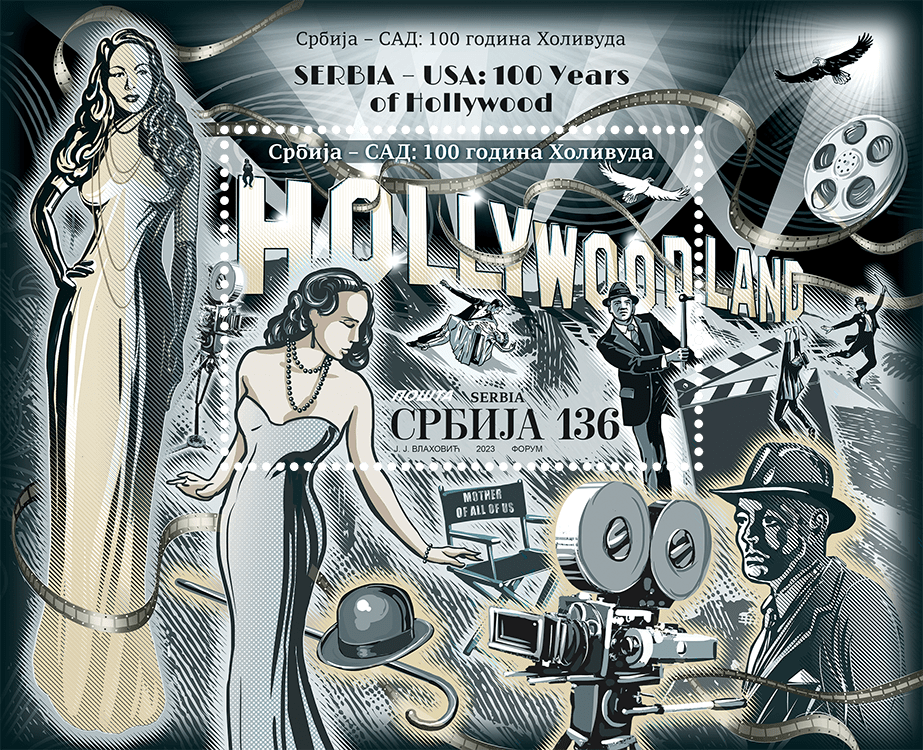
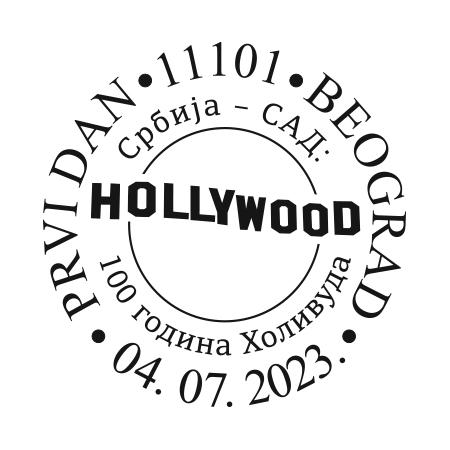
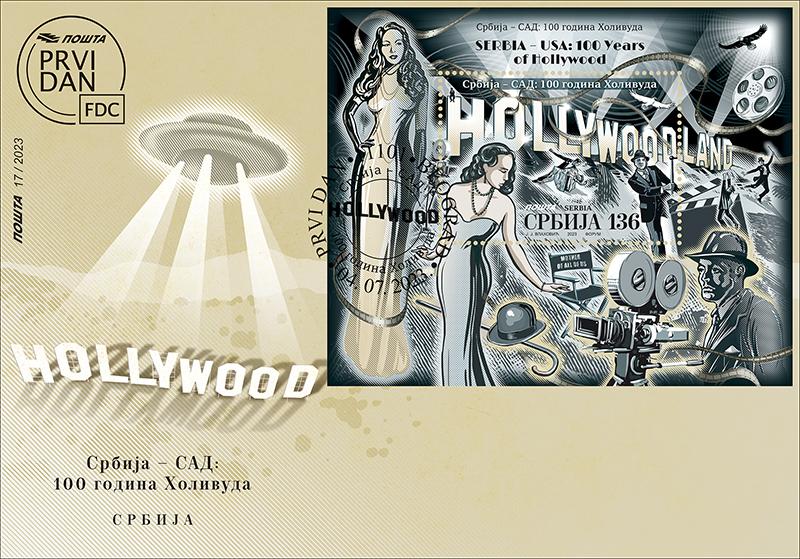
Cultural ties form an important basis of friendship between the people of Serbia and the people of the United States of America, and films and the film industry represent one of the most recognizable symbols of the US culture in Serbia. Hollywood, as the historical capital of the film industry, symbolizes the spirit of America, its values and a wide range of cultural aspects important for understanding the USA, which American films have conveyed in countries around the world, including Serbia, during the past 100 years.
The rise of Hollywood as the film capital is symbolized by one of the most famous signs of popular culture of the 20th century – the Hollywood sign in Los Angeles. The year 2023 marks the jubilee – the centenary of the installation of this sign, which has been carrying the message of universal culture throughout the world for a century. Today, the Hollywood sign represents a universal metaphor not only for the location, but also for an entire industry, lifestyle, and cultural factors woven into its century-long history.
The importance of two-way ties in the cultural relations of the two peoples can best be illustrated by the example of Hollywood and the film industry of the USA, with artists of Serbian origin also contributing to its creation, construction and achievement of global fame and success. Of the many names of our fellow citizens and their successors who built careers in the USA and made a significant contribution to the film industry and specifically to Hollywood, the name of Karl Malden stands out. Born as Mladen Sekulović in Chicago, he achieved an incredibly successful film career appearing in more than 60 films. Never forgetting his origins, Malden made an effort to leave his mark in Serbian and Yugoslav cinematography by appearing in a film produced in our region. Among the many awards and recognitions he received, in addition to the Oscar in 1951, the Screen Actors Guild Life Achievement Award, which he received in 2004, also stands out.
Artistic realization of the issue: MA Jakša Vlahović, academic graphic artist
Nikola Tesla and Mihajlo Pupin – Our Geniuses
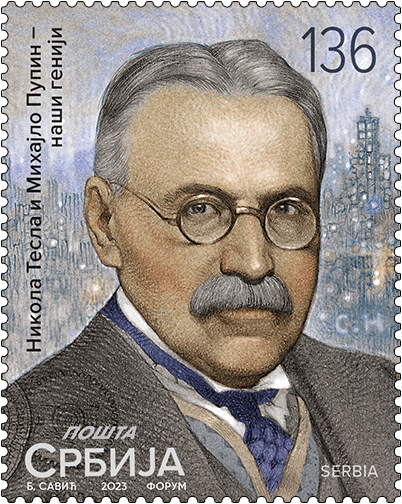
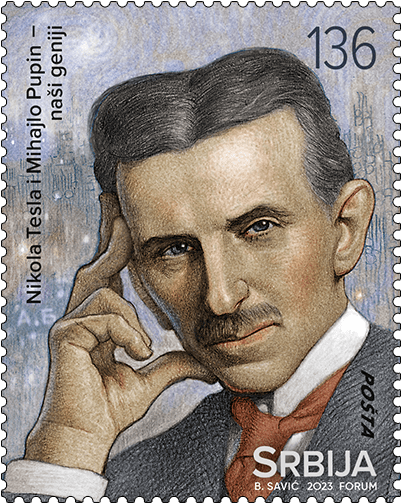
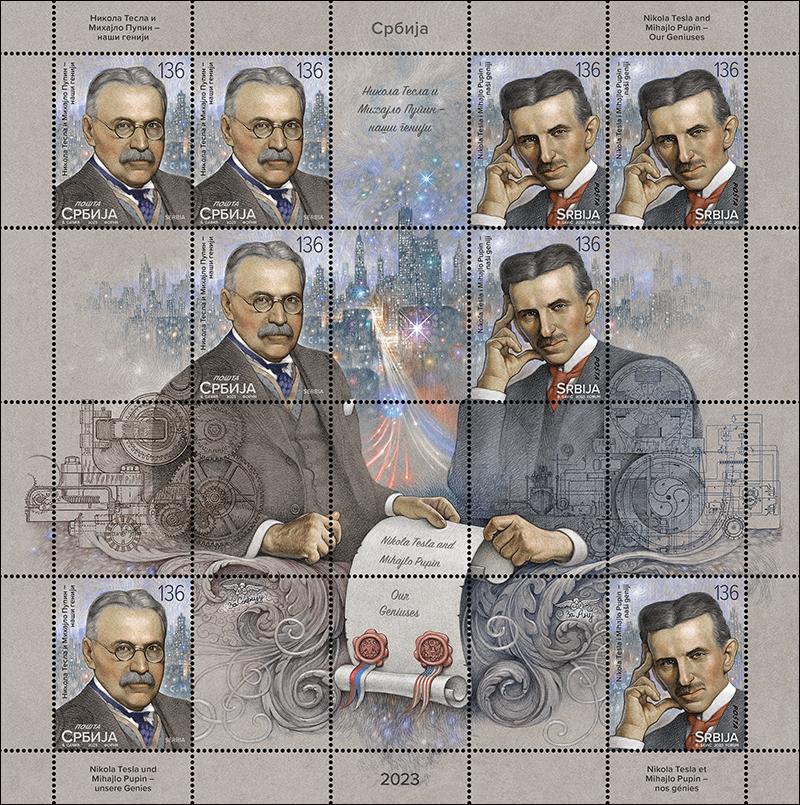
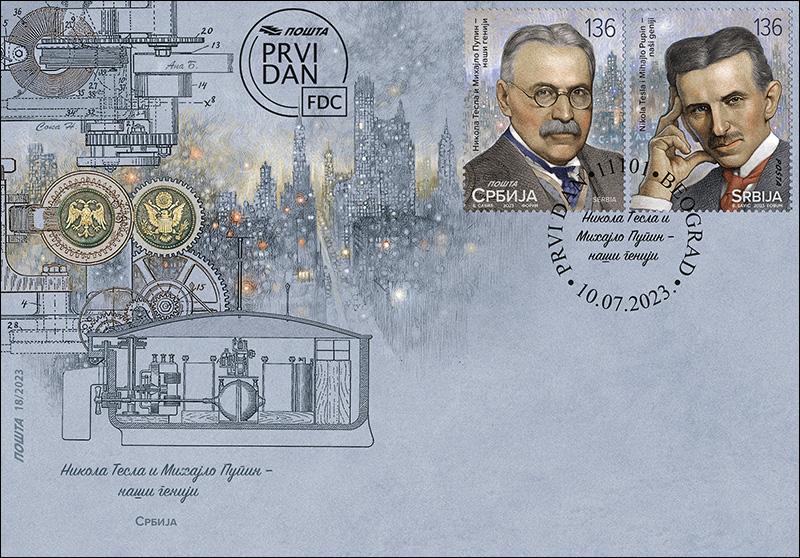
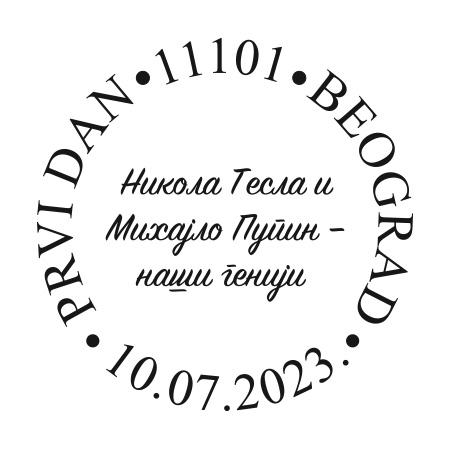
Nikola Tesla and Mihajlo Pupin are two of the greatest Serbian scientists and inventors, who fulfilled their careers, inventions and scientific achievements in the United States of America. Both made key contributions to the scientific and technological development of humanity, never forgetting their Serbian origins and the American social environment that allowed them to fully express their talents and values.
The issue of commemorative postage stamps ”Nikola Tesla and Mihajlo Pupin – Our Geniuses” celebrates the two giants of science in honour of the centenary of the first publication of Mihajlo Pupin's Pulitzer Prize-winning autobiography, ”From Immigrant to Inventor” and the 125th anniversary of Tesla's first public demonstration of radio control.
Nikola Tesla (Smiljan, July 10, 1856 – New York, January 7, 1943) inventor, engineer and futurist, best known for his contribution to the design of the modern AC power supply system, is one of the greatest geniuses and the greatest inventor of the last millennium. He bequeathed his inventions, according to his own wish, to all humankind. Among many of his patents, there are also those in the field of radio and wireless transmission of radio signals, and shortly after he registered his first patent in this field, in 1898, Tesla performed the first public demonstration of controlling a boat via radio waves, at an exhibition in the field of electricity at Madison Square Garden.
Mihajlo Idvorski Pupin (Idvor, October 9, 1854 – New York, March 12, 1935) scientist, inventor, professor at Columbia University and honorary consul of Serbia in the USA, will be remembered not only for his successful and extensive scientific work but also for his outstanding contribution to the Paris Peace Conference, which, after World War I, determined the borders of the Kingdom of Serbs, Croats and Slovenes. Pupin was also engaged in literary work; he won the world prestigious Pulitzer Prize in 1924 for his most famous work, the autobiography in English ”From immigrant to inventor” published in 1923.
Artistic realization of the issue: Boban Savić MA, academic painter
Каталошке информације
Уметничка реализација издања: мр Бобан Савић, академски сликар
1244. 136,00 дин (вишебојна) 25.000
1245. 136,00 дин (вишебојна) 25.000
Табак: 8
На коверту са жигом ПД (FDC)
Нацрт: 1244. Михајло Идворски Пупин
Нацрт: 1245. Никола Тесла
Величина марке: 33,49 x 42 mm
250 Years since the Slovak Settlement in Kisač
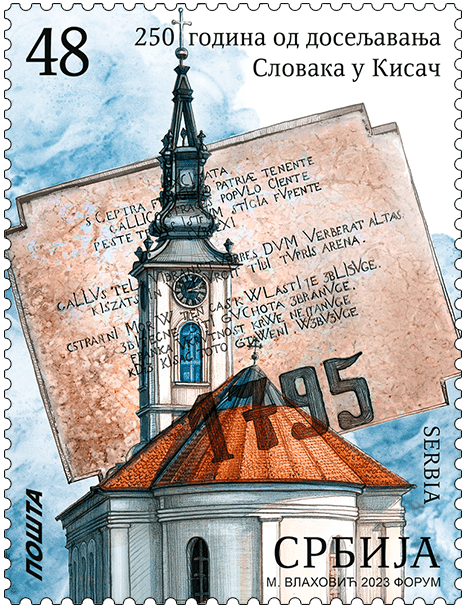
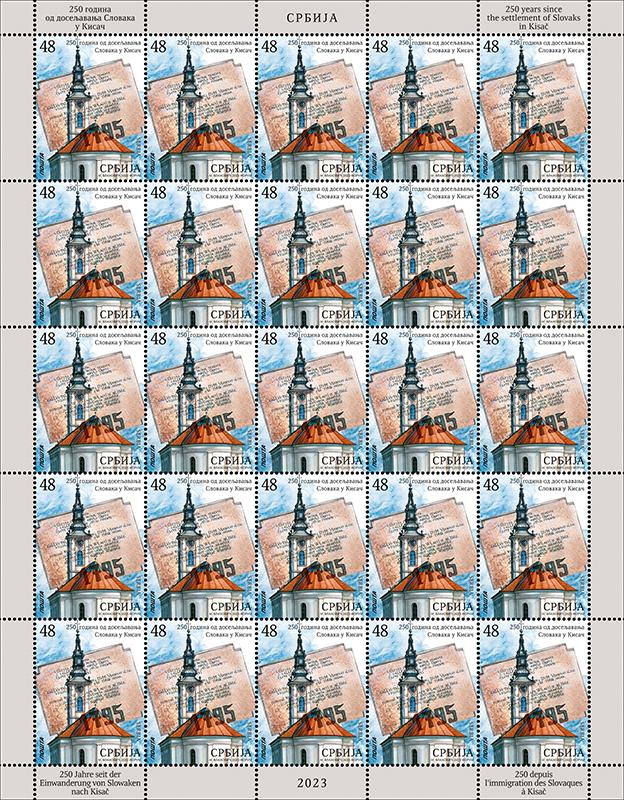
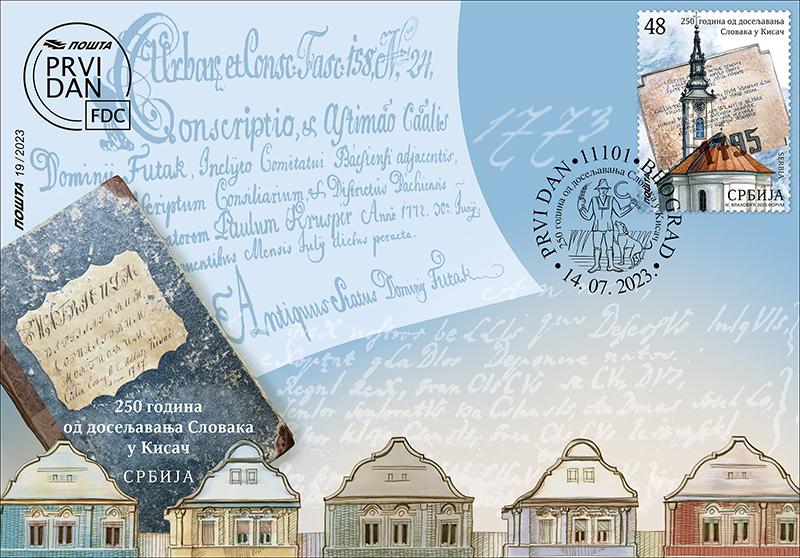
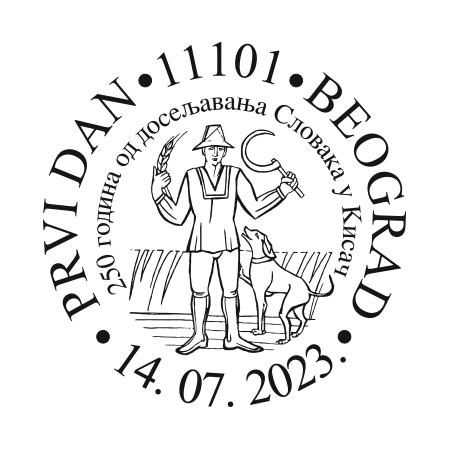
The settlement of Slovaks to Kisač (slov. Kysáč) started in 1773, whereby the role of Count András Hadik stands out, who, probably because of his Slovak origin, wanted to settle a larger number of his compatriots on his Futog estate. The first Slovak who moved to Kisač was Michal Vardžík (1736–1792). Circumstantially, the year of the arrival of the Slovaks in Kisač was immortalized in the Serbian Orthodox church that was built in that very year.
The issuance of the Patent of Tolerance in 1781 encouraged the arrival of a new wave of settlers, which created the conditions for the establishment of a school and inviting the first teacher and the first priest. The Evangelical church in Kisač bears the oldest Slovak Vojvodina epigraphic inscription from 1802.
In a period of 250 years, the Slovaks in Kisač managed to survive and preserve their identity in a multinational environment thanks primarily to favourable socio-political circumstances. Unhindered establishment and functioning of key institutions, societies and associations of national character (in the 18th and 19th centuries, for example, a school, a church and the “Reading Society” were founded, and in the period between the two world wars the “Society of Czechoslovak Women”, “Sokolstvo Jedinstvo” Falconry Society, the “Tatra” football club, “Zanatsko društvo” Crafts Society, the local board of the Matica slovačka in Yugoslavia, etc.) had a positive effect on the spread of literacy, the preservation of the Slovak native language and the growth of national consciousness. Here we should highlight the exemplary coexistence with other nationalities in the area, above all Serbian-Slovak cooperation in all local institutions and beyond.
The issuance of this series of commemorative postage stamps indicates that the harmony of inter-ethnic relations in Serbia is based on historical memory and mutual respect of all its citizens.
Стручна сарадња: Савет Месне заједнице „Кисач”, доц. др Даниела Марчок
Artistic realisation of the issue: MA Marija Vlahovic, academic graphic artist
Каталошке информације
14. јул 2023.
Уметничка реализација издања: Марија Влаховић, академски графичар
1246. 48,00 дин (вишебојна) 25.000
Табак: 25
На коверту са жигом ПД (FDC)
Нацрт: 1246. Евангеличка црква у Кисачу и најстарији словачки војвођански епиграфски натпис из 1802.
Величина марке: 31,9 x 42 mm
100 years of the PTT Museum
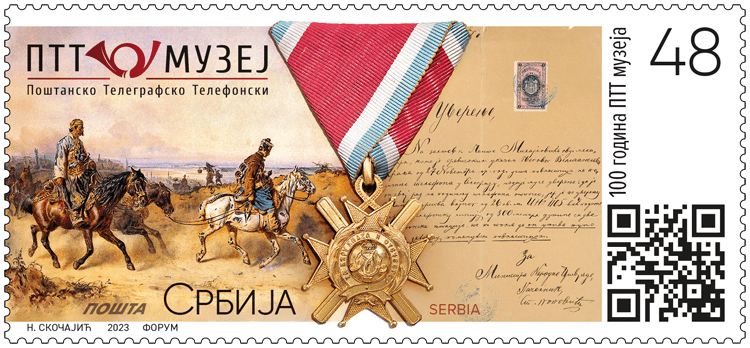
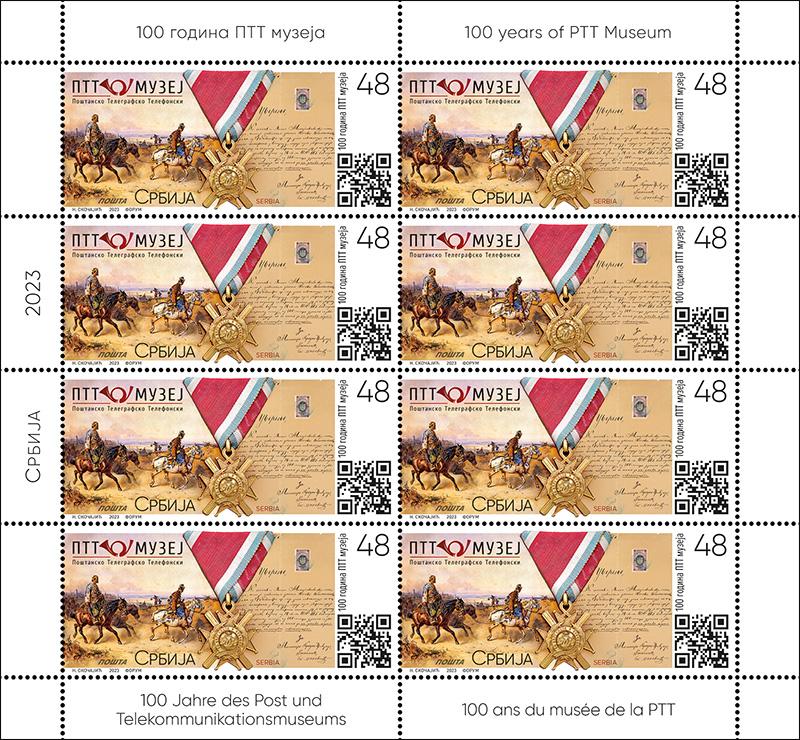
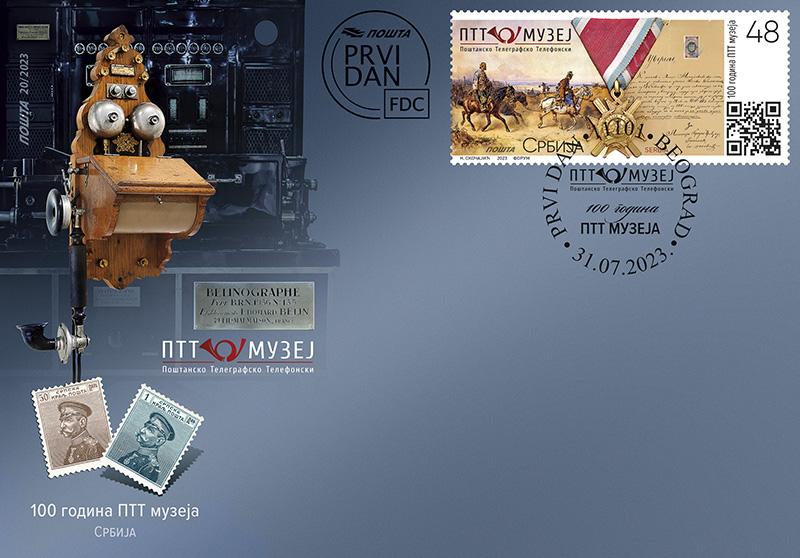
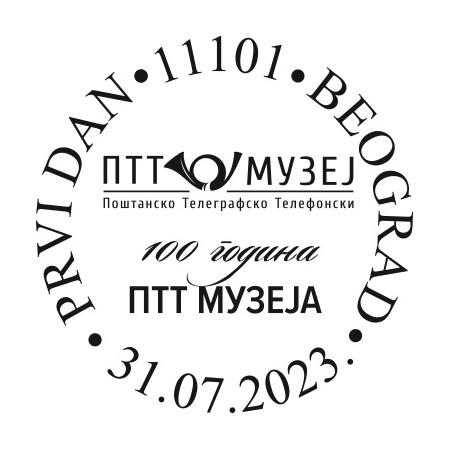
The PTT Museum in Belgrade, as a technical museum and cultural institution, functions as part of PE Post of Serbia and deals with the protection, collection, study and exhibition of items and documents related to the history of postal, telegraphic and telephone traffic. The PTT Museum was founded on July 31, 1923, when the Ministry of Posts and Telegraphs of the Kingdom of Serbs, Croats and Slovenes passed the first Rulebook on the museum. This Rulebook defined the way of operation and the organization of the PTT Museum and created a fund with exhibits that had been collected in an organized manner since 1888. The PTT Museum was officially opened to the public in 1958, and the museum’s new permanent exhibition, in Majke Jevrosime 13 Street, Belgrade, was opened to the public in 2013.
For a full 100 years, the PTT Museum, by participating in various cultural manifestations, organizing various thematic exhibitions, children›s workshops, expert panels and concerts, has successfully continued its tradition and achieved its main goal – to preserve and present the postal and technical heritage and nurture and build a culture of remembrance.
Motifs on the stamp: Tatar and accompanist, aquarelle; Order of the Takovo Cross, V degree, awarded for special merits to Panta Mihajlović by King Aleksandar I Obrenović in 1900; The Certificate which Panta Mihajlović received in 1883 from the Ministry of National Economy of the Kingdom of Serbia, "that he built telephone lines within the prescribed period and, based on that, fulfilled the conditions of the concession, so it should not be taken away from him".
Motifs on the envelope: personal phone of King Petar I Karađorđević; regular issue of the postage stamp, with the image of King Petar I Karađorđević from 1911, draft M. Marković, cut P. Aničić, and the press of the State Stamp Office in Belgrade; this stamp was made in 12 different values and in a different color for each denomination. In the background Bellinograph – a device for transferring documents and photos on the Belgrade – Paris line, acquired in 1937 and installed in 1938, in the Palace of the Main Post Office in Takovska Street.
All the motifs depicted are from the collection of the PTT Museum.
Expert collaboration: PTT Museum, Belgrade Graphic realization of the issue: Nadežda Skočajić, Academic Graphic Artist
Каталошке информације
31. јул 2023.
Уметничка реализација издања: Надежда Скочајић, академски графичар
1247. 48,00 дин (вишебојна) 25.000
Табак: 8
На коверту са жигом ПД (FDC)
Нацрт: 1247. Татарин и суруџија; орден Таковског крста; Уверење Министарства народне привреде Краљевине Србије
Величина марке: 70 x 31.9 mm
GOOD LUCK!
120 years of the Bulletin of Mines
120 years since the miners’ strike in the Senj mine
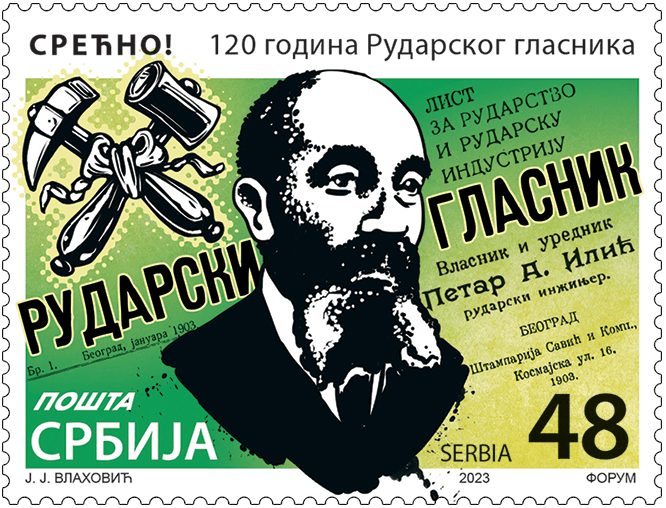
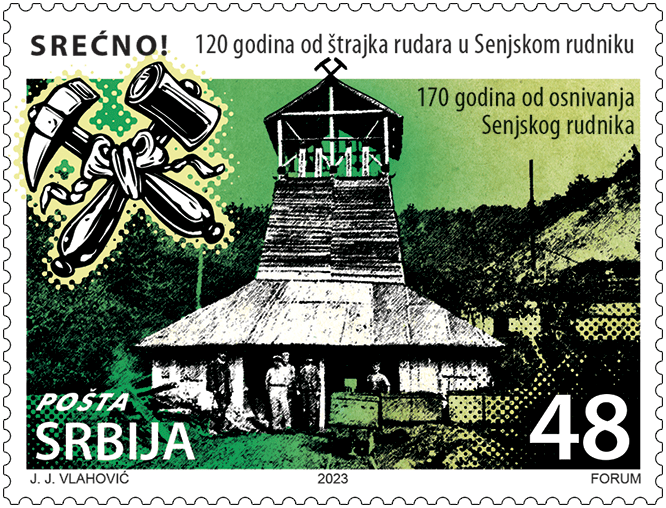
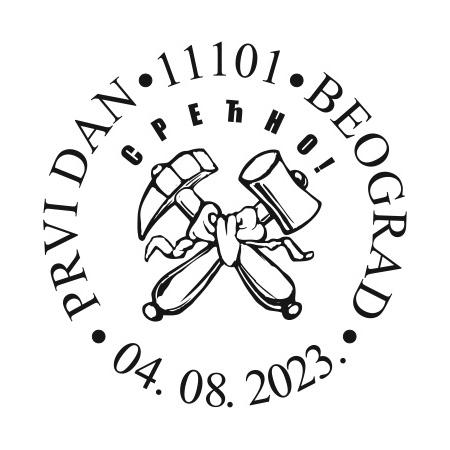
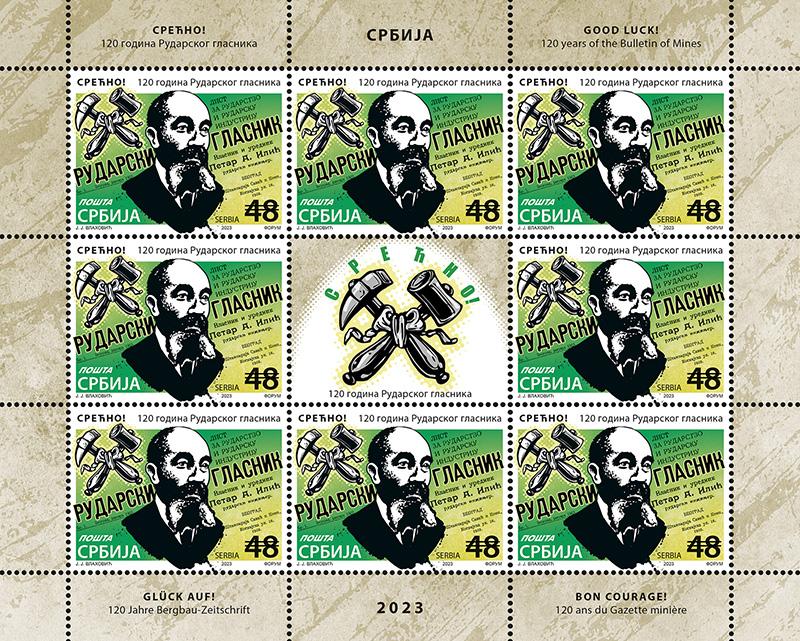
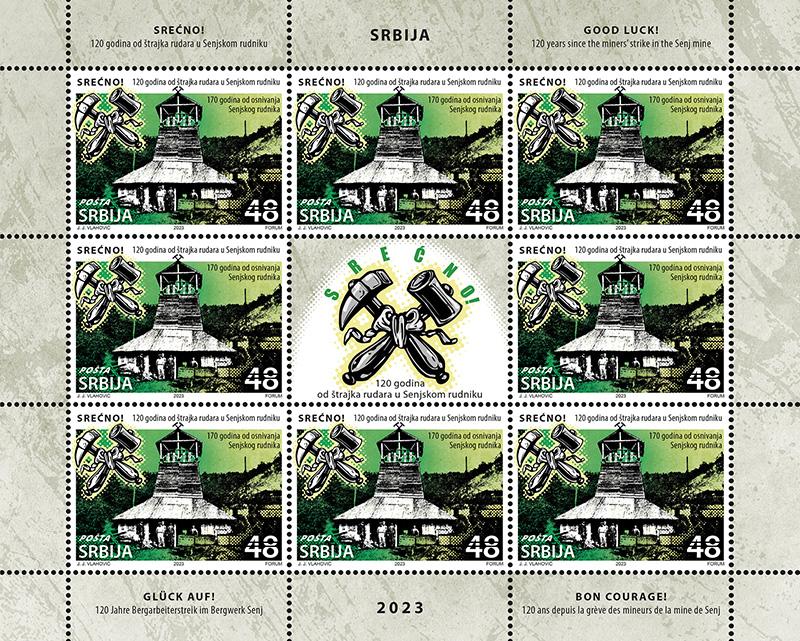
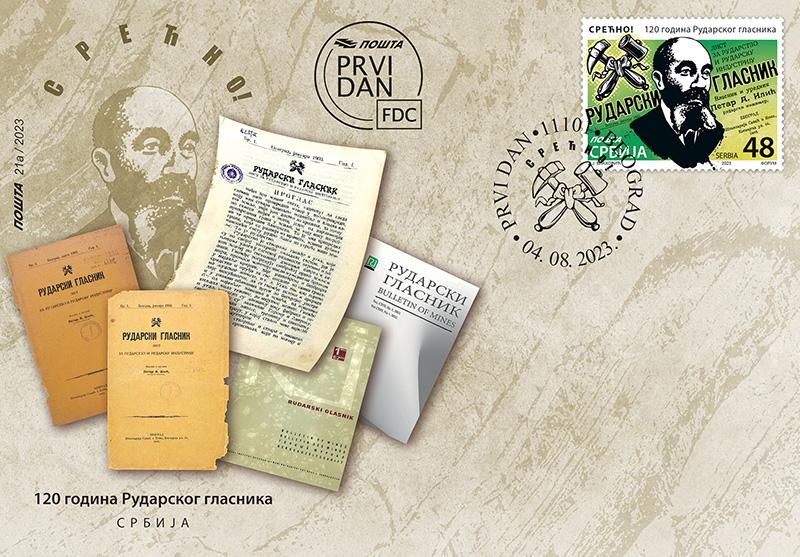
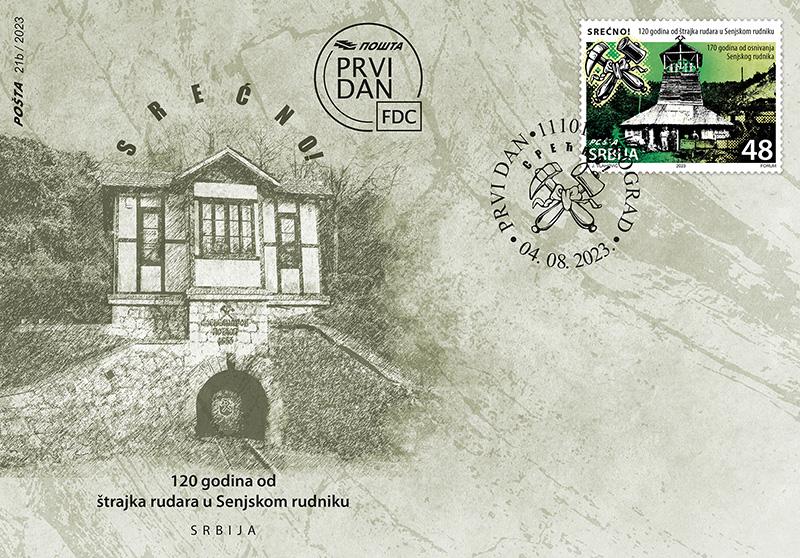
120 years of the Bulletin of Mines
The first issue of one of the oldest scientific magazines for mining, the Bulletin of Mines, appeared at the beginning of 1903. The owner and editor was Petar Ilić (Oreovica near Požarevac, 1863 – Belgrade, 1941), professor of mathematics and mining engineer.
Discussions about mines and mining geology, the development and state of mining in Serbia, the opening of mines and investments in mining, mining terminology, staff training, scientific and technical and technological achievements, mining in neighbouring countries and in the world, mining legislation and mining and geology in general, Petar Ilić left a written treasury that preserves from oblivion important information about Serbian mining at the turn of the 19th and 20th centuries. After retiring, Ilić was unable to continue financing the magazine, and in 1910, after 78 issues with a total of 2,548 pages published, the Bulletin of Mines ceased publication. After the founding of the Mining Institute in Belgrade in 1960, the re-publication of the magazine was initiated. The renewed Bulletin of Mines was published in 1962 and quickly became one of the most respected scientific magazines for mining. It was published regularly until 1999, when due to material and other reasons, printing was stopped. Under the auspices of the Mining Institute and in a new guise, the Bulletin of Mines continues its mission in 2013, in Serbian and English. Since its birthday in 1903 to its jubilee year in 2023, the Bulletin of Mines published 246 issues on 18,825 pages. With scientific and professional information, keeping facts about the great rise and achievements of the Serbian mining and geological economy, science, engineering and education during the 20th century, the Bulletin of Mines continues to fulfil the original goals and mission of the magazine.
Stamp motif: a portrait of Petar Ilić, the founder of the magazine.
Envelope motif: front pages of the Bulletin of Mines.
120 years since the miners’ strike in the Senj mine
The industrial revolution and the application of steam engines brought coal to the fore as an energy source in industry. In Serbia, the construction of the Smelting plant in Kragujevac, which had to be supplied with high-quality, high-calorie fuel, led to the opening of the Senj brown coal mine in 1853, based on the decision of the Mining Department of the Ministry of Finance of the Principality of Serbia.
After the preparatory works, the first 26,320 eyes, or 33.7 tons of coal, were unearthed in the outcrop of the coal seam, and shipped to the Smelting plant on May 12, 1854 in 98 Kiridžija wagons. With the commissioning of the Belgrade – Niš railway in 1884, the need for brown coal increased considerably, so in order to facilitate the delivery of coal, a narrow-gauge railway Senj mine – Ćuprija was built in 1892. Due to its strategic importance, the Senj mine, except for one short period (1869–1874), was always owned by the state.
Coal mining was based on manual work, the miners had no protective equipment, they used their clothes – fur/leather coats (gunjs), fur hats (šubaras), leather footwear, etc. On St. Procopius Day in 1893, one of the biggest accidents in the mines of Serbia occurred, when the entire shift remained underground. Since then, July 21 has been marked as a day of remembrance for fallen comrades.
On August 6, 1903, on the fiftieth anniversary of the mine, the first organized miners’ strike took place in the Senj mine, and the reason was the dismissal of three comrades. After nine days of strike, the miners won the return of their comrades to work, but also shorter working hours and free lamp oil. In honour of this event, August 6 was declared the Day of Serbian Miners in 1955, and it has been solemnly celebrated ever since.
Stamp motif: Senj mine, an export shaft from the time of the miners’ strike in 1903.
Envelope motif: the symbol of the Senj Mine – Undermining Aleksandar from 1853 when the mine was opened.
Expert collaboration: Mining Institute Belgrade, academician prof. Slobodan Vujić, PhD
Artistic realization of the issue: MA Jakša Vlahović, academic graphic artist
Каталошке информације
04. август 2023.
Artistic realization of the issue: MA Jakša Vlahović, academic graphic artist
1248. 48,00 дин (вишебојна) 25.000
1249. 48,00 дин (вишебојна) 25.000
Табак: 8
На ковертима са жигом ПД (FDC x 2)
Нацрт: 1248. портрет Петра Илића, оснивача часописа; 1249. Сењски рудник, извозно окно из времена штрајка рудара 1903.
Величина марака : 42x 31,9 mm
75 years since the founding of the Union of Philatelists of Serbia
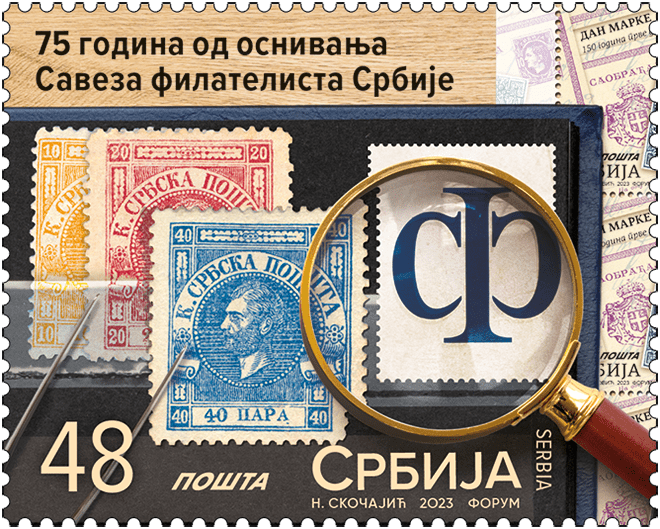

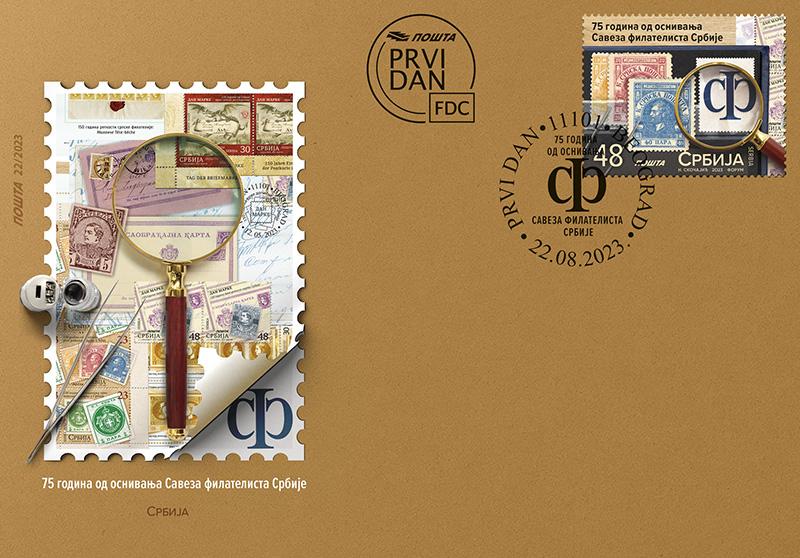
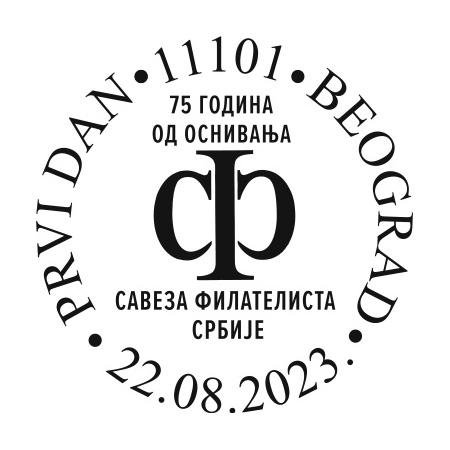
Philately as a collecting activity in Serbia records its beginnings in the last century, only to experience its real momentum as an organized activity shortly after the end of the Second World War. Enthusiasts of postage stamps quickly realized that without a comprehensive organization, phila-tely cannot expect a more engaged attitude of society towards it, nor can it play a more significant role, which naturally belongs to it. Convinced of the necessity of a strong philatelic organization, a few pre-war philatelic enthusiasts founded the Union of Philatelists of Serbia on August 22, 1948. Union of the Philatelists of Serbia has had an engaged attitude towards issues of protection of philately and philatelists from the very beginning. Although over the past 75 years, the questions and challenges have changed forms, they have certainly retained their original meaning and have not lost their relevance until these days.
The mission of organized philately in Serbia is realized today through the national magazine Philatelist, of which 281 issues have been published so far; Council of attestors – body for the examination of postage stamps; organization of national philatelic exhibitions SERBIAPHILA and SOFIZ, as well as participation in international philatelic exhibitions. The editorial policy of the Philatelist magazine, interesting and exhaustively covered topics from the history of philately, but also the confirmed successes of Serbian exhibitors on the international philatelic scene is an unequivocal confirmation of the quality philatelic work of the Union of Philatelists of Serbia through organized philately.
Expert collaboration: Union of Philatelists of Serbia
Artistic realization of the issue: MA Nadežda Skočajić, Academic Graphic Artist
Каталошке информације
22. август 2023.
Artistic realization of the issue: MA Nadežda Skočajić, Academic Graphic Artist
1250. 48,00 дин (вишебојна) 25.000
Табак: 8
На коверту са жигом ПД (FDC)
Нацрт: 1250. Прве српске поштанске марке са ликом Кнеза Михаила Обреновића (1866); знак Савеза филателиста Србије и пратећи филателистички прибор
Величина марака : 42x 33.35 mm
World Rowing Championships – Belgrade 2023
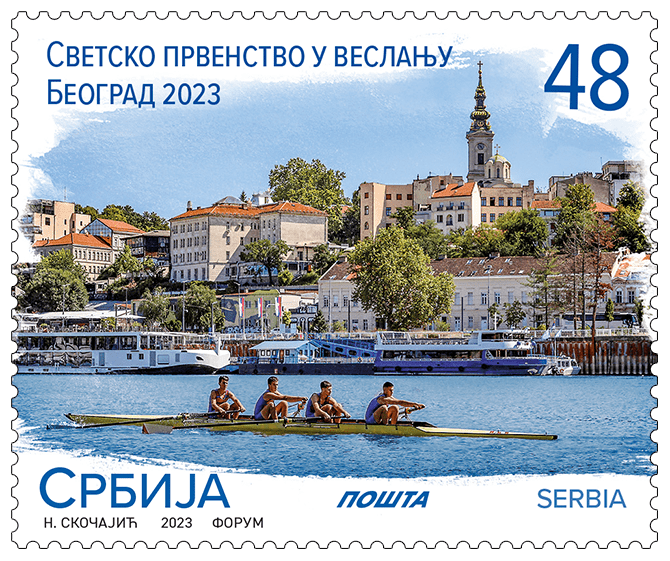
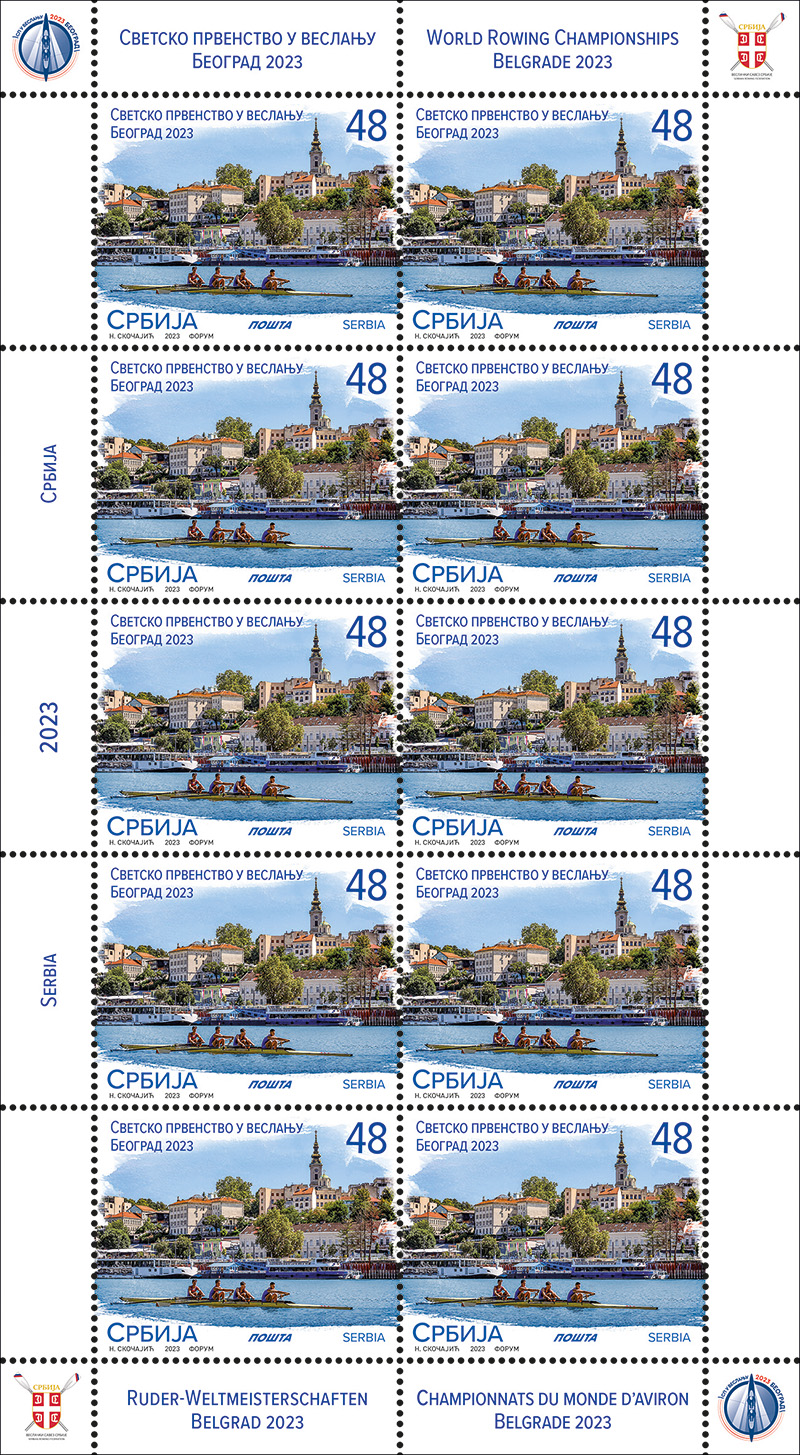
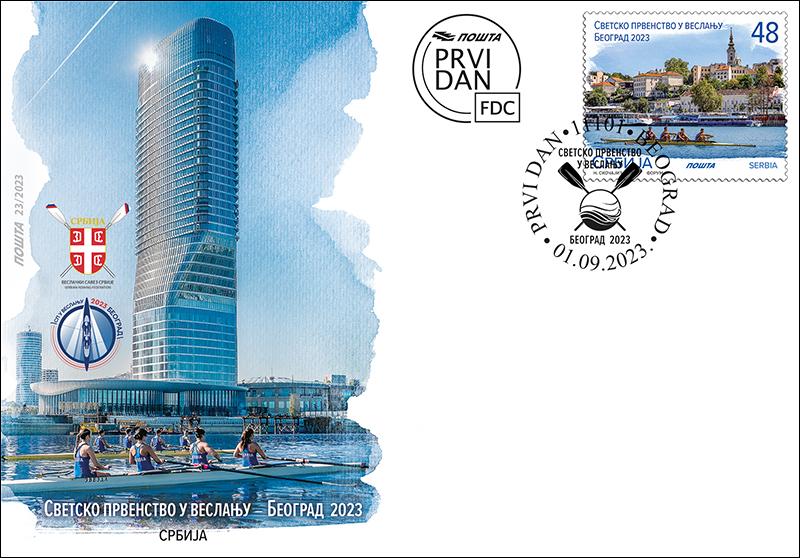
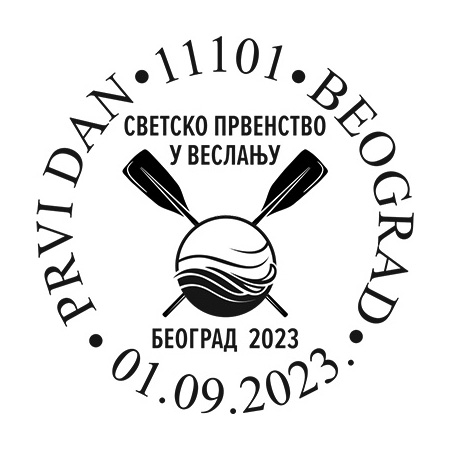
Serbian Rowing Federation (SRF) has been chosen as the host and organizer of the 2023 World Rowing Championships by the World Rowing Federation (FISA), which will be held from September 3 to 10, 2023 at Ada Ciganlija. The city of Belgrade and the Republic of Serbia for the first time became the hosts of the world championship in rowing for seniors.
The World Rowing Championship is the largest sports event to be held in Belgrade in 2023 and will gather over 1,500 rowers from more than 80 countries. The championship is also a qualifying regatta for the upcoming Olympic Games that will be held in Paris in 2024, so the competition will have additional significance because it is the last championship before the Olympic Games in Paris.
The World Rowing Championship is an opportunity for the best rowers worldwide to compete at the highest level and demonstrate their skills and abilities. It is also an opportunity to promote rowing as a sport and to raise awareness of the importance of physical activity and a healthy lifestyle. In addition, such a large international sports event has a significant economic impact on the host city and country, due to greater tourist visits during the competition itself and better development of sports infrastructure.
Expert collaboration: Serbian Rowing Federation
Graphic realization: MA Nadežda Skočajić, Academic Graphic Artist
Philatelic exhibition BALKANFILA XIX
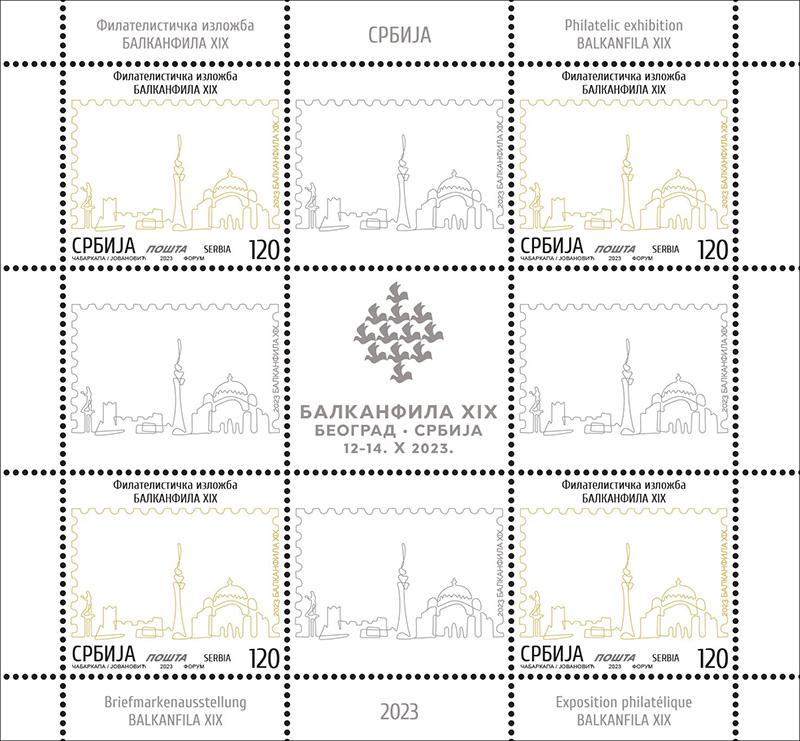
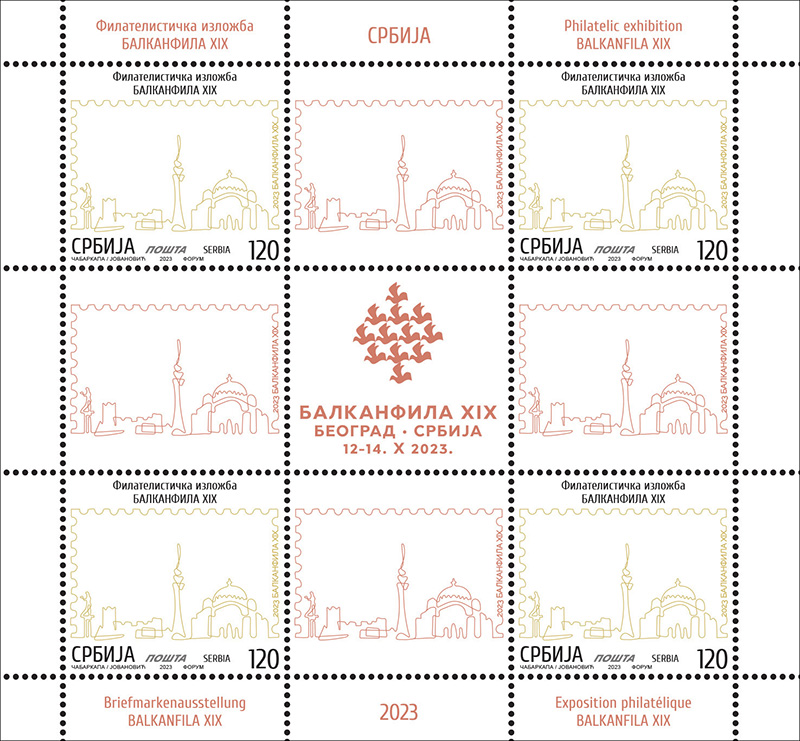
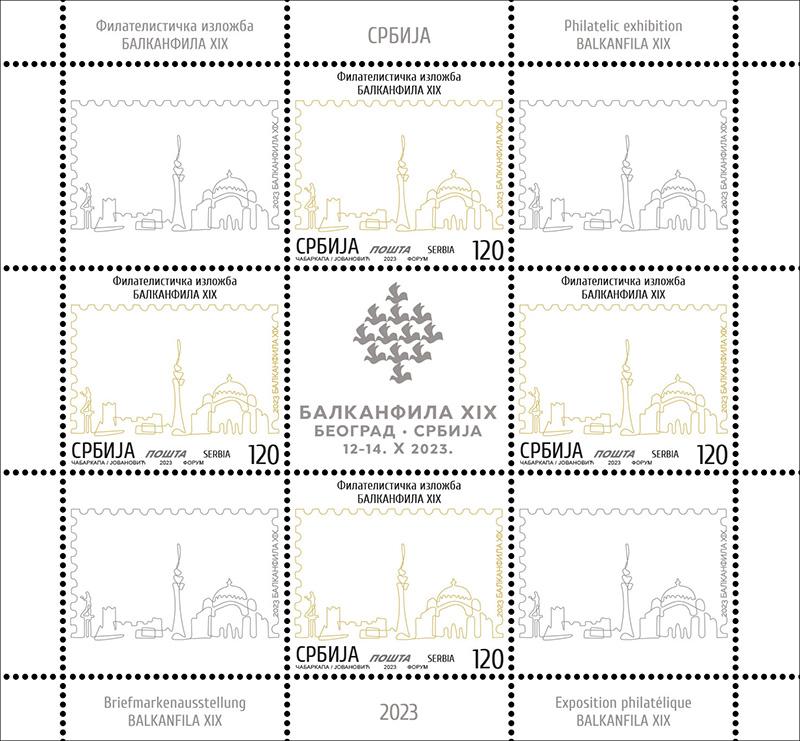
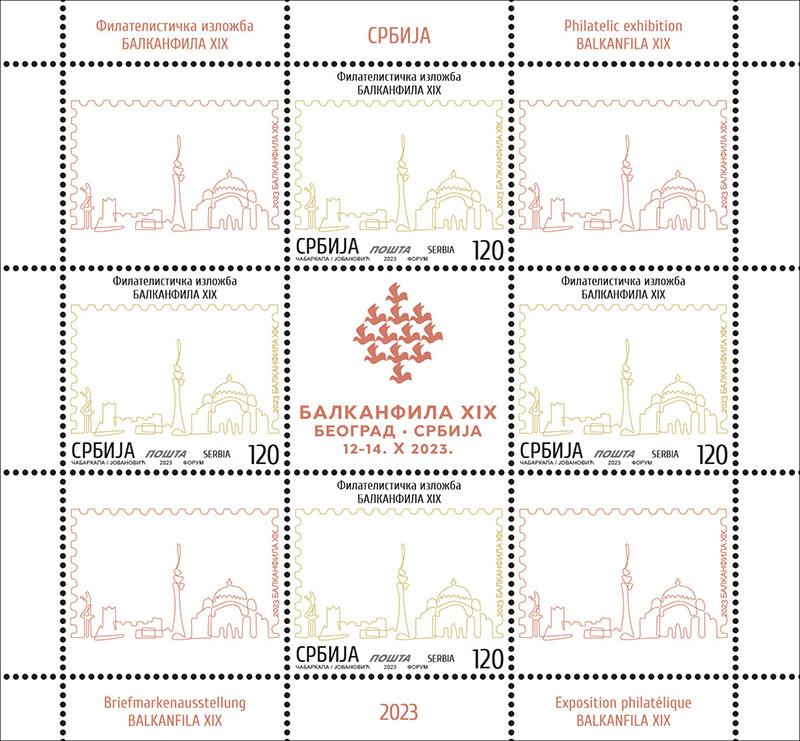
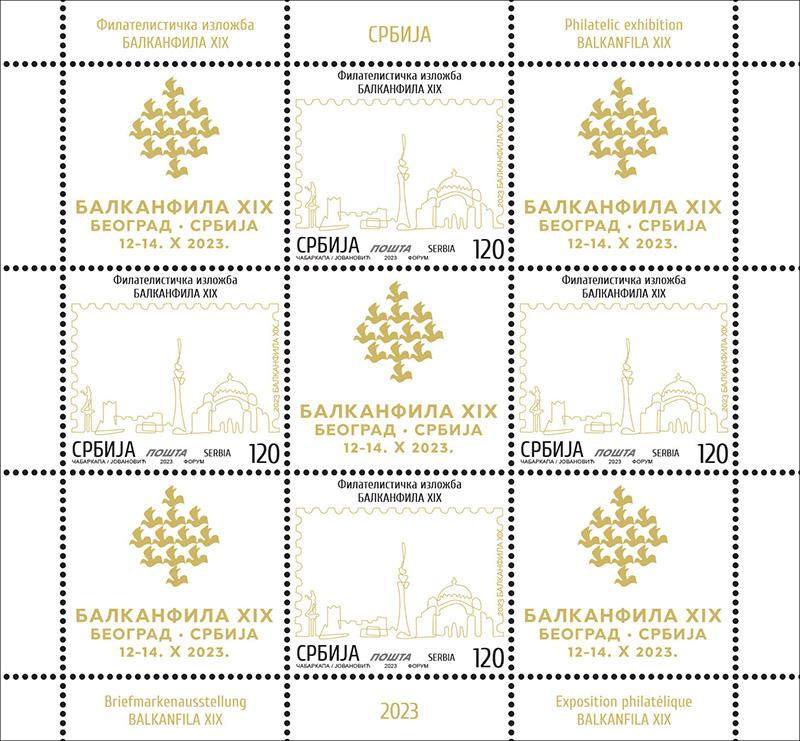
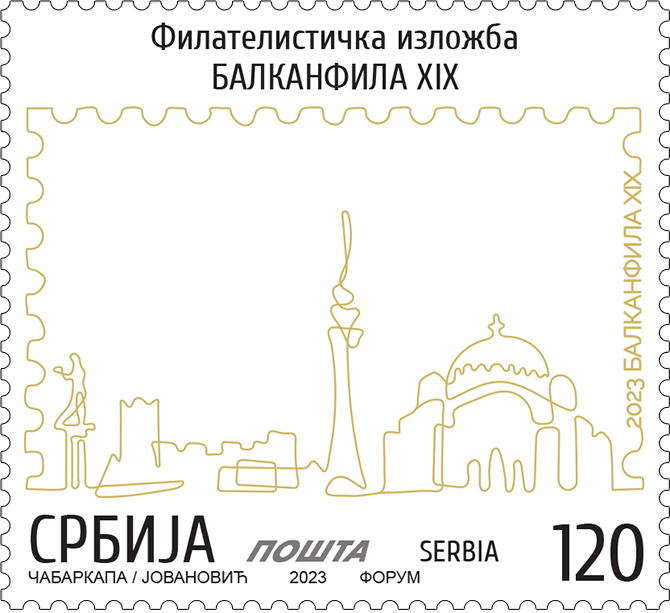
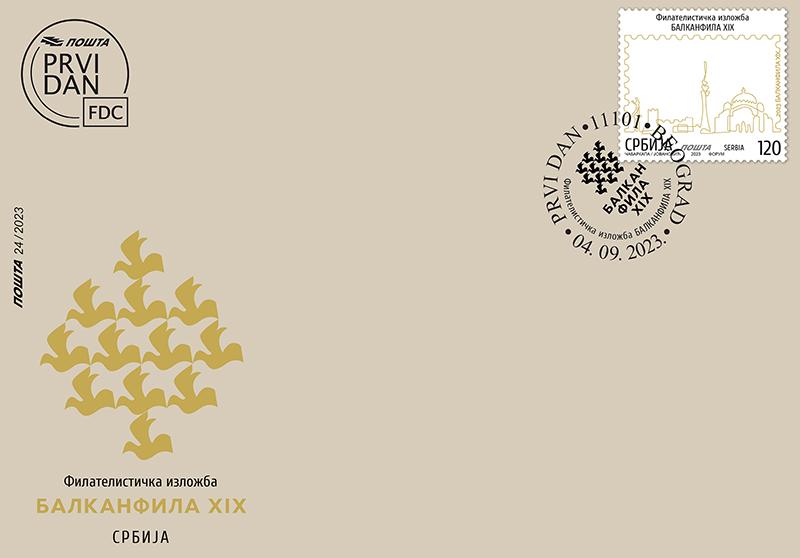
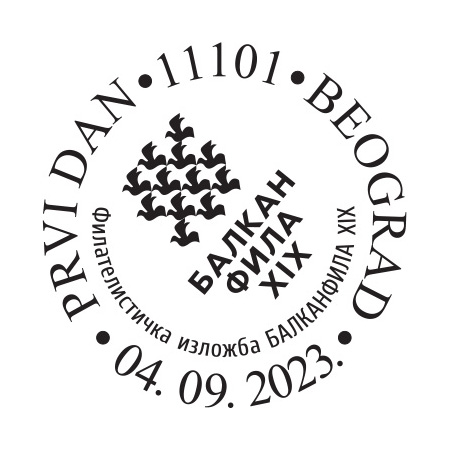
The International Philatelic Exhibition BALKANFILA XIX will be held in Belgrade from October 12 to 14, 2023, organized by the Union of Philatelists of Serbia and under the honorary patronage of the President of the Republic of Serbia. This, so far, the largest exhibition of philately in Serbia and the region is organized with the help and support of PE Post of Serbia, and will gather philatelic exhibitors from 12 countries, as well as guests and visitors from many countries of Europe and the world.
The first BALKANFILA International Philatelic Exhibition was held in Sofia in 1965, and was organized on the initiative of the philatelic societies of the Balkan countries, which realised that organising such a philatelic exhibition is an opportunity to promote philately, facilitate the exchange of experiences and improve cooperation between the philatelic societies of the Balkan countries. In the period from 1965 until 2016, a total of 18 philatelic exhibitions of the Balkan philatelists were held, and our country was the host twice – in Belgrade in 1977 (BALKANFILA VI) and in Novi Sad in 1987 (BALKAFILA XI).
At this year’s event BALKANFILA XIX, the traditional mission which is to strengthen and develop cooperation and friendship between philatelists of the countries of the Balkan region, philatelists from Albania, Bosnia and Herzegovina, Bulgaria, Croatia, Greece, Hungary, Montenegro, North Macedonia, Romania, Serbia, Slovenia and Turkey announced their participation. In 11 competition classes, more than 150 exhibits will be displayed, and together with the honorary exhibitors, around 600 display cases with philatelic exhibits will be presented to visitors in the space of the Central Military Club in Belgrade.
Authors of the Balkanfila XIX sign on the stamp, vignette and envelope: Jasmina Čabarkapa and Milica Jovanović
Graphic realization of the issue: MA Marija Vlahović, academic graphic artist
30 years since the establishment of PostEurop
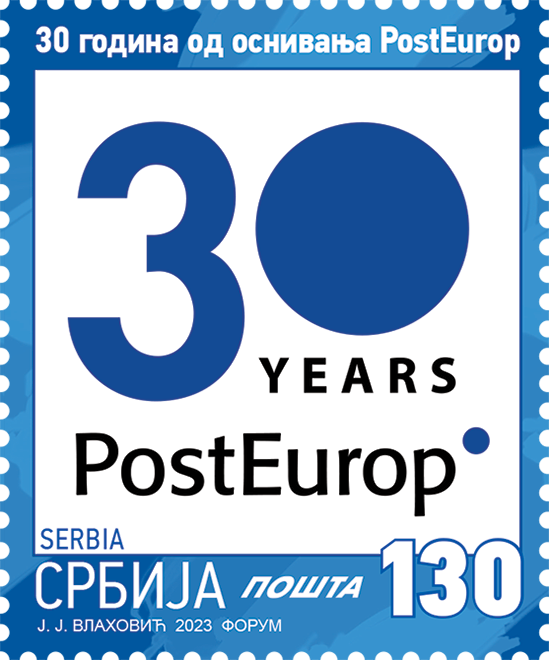

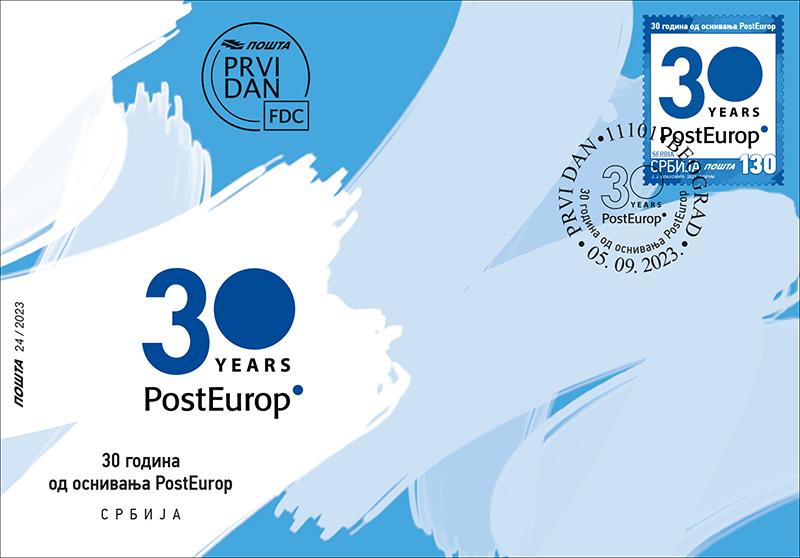
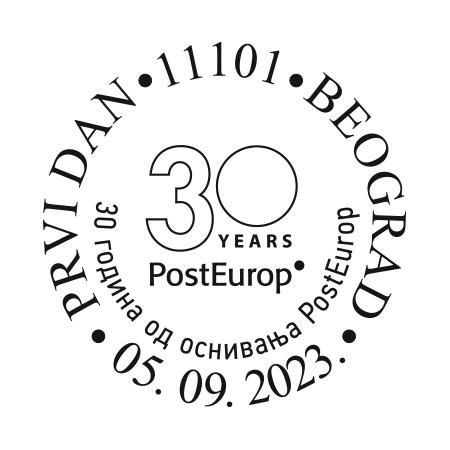
When, in the early 1990s, the processes of European integration intensified, efforts to harmonize and reform the European postal market led to the formation of the Association of Public Postal Operators – PostEurop, an organization that this year celebrates three decades of its existence. Thirty years of dedication to the single postal market, representing the interests of the national postal operators of PostEurop members, harmonizing the policy of the postal sector and the organizational and strategic issues it deals with, have created PostEurop as an organization dedicated to the support and development of a sustainable European market for postal communications, accessible to all users and providing modern and accessible universal services. PostEurop today represents the interests of two million postal workers employed across Europe who serve 800 million clients daily at more than 175,000 counters.
The Post of Serbia joins the celebration of the great and significant anniversary of PostEurop by publishing a commemorative issue with a graphic solution with which the Association of Postal Operators of Europe marked the jubilee – the 30th anniversary of its establishment.
Motif on the stamp: 30 years PostEurop logo
Graphic realization of the issue: MA Jakša Vlahović, academic graphic artist
Rulers of Serbia
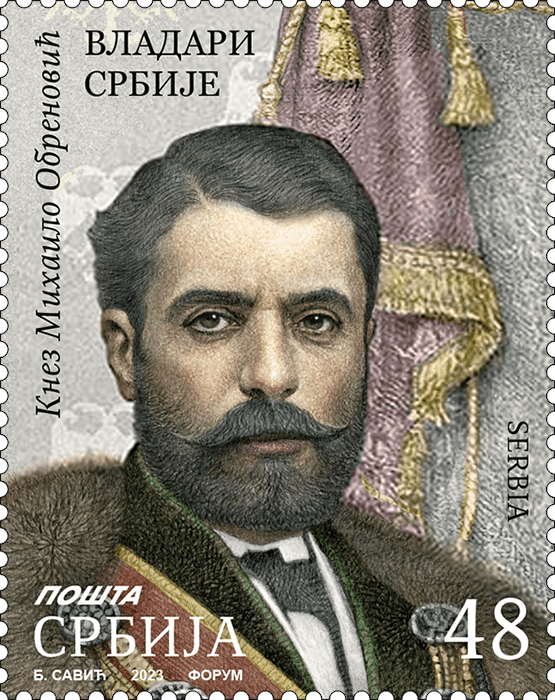
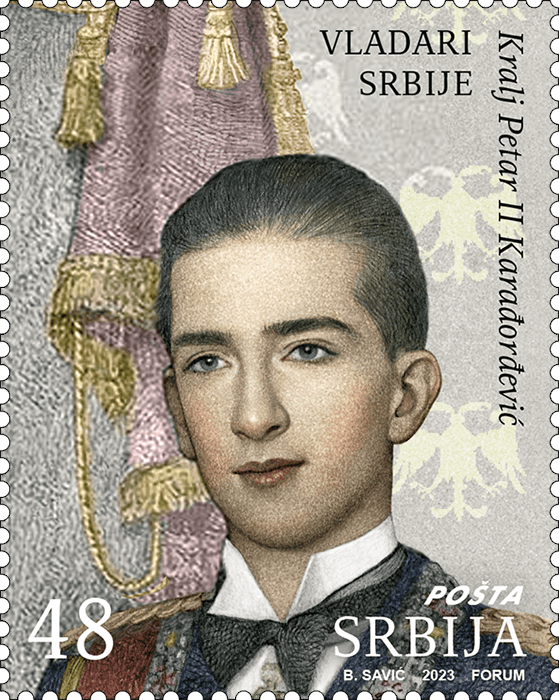
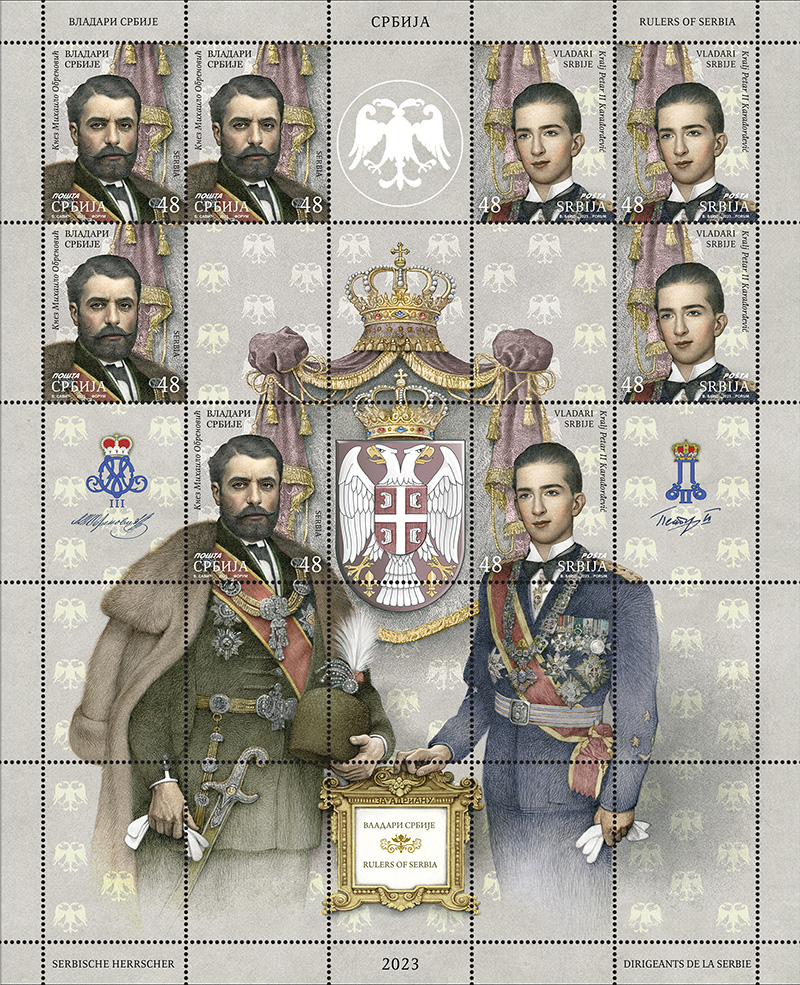
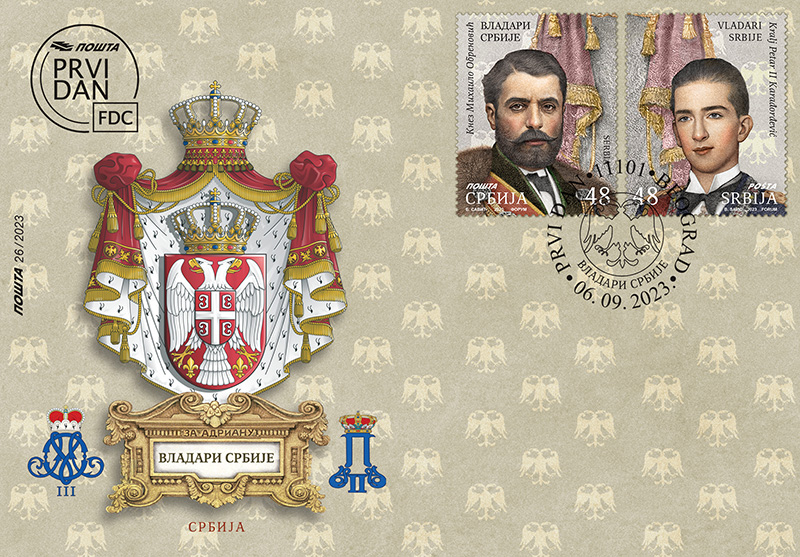
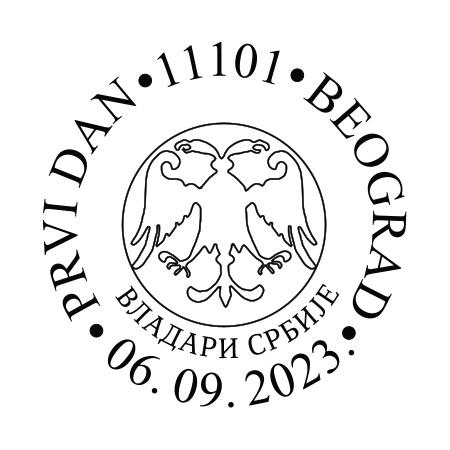
In its rich and long history, Serbia had a large number of rulers who significantly influenced the development of Serbian society and the state. Over the centuries, Serbia was led by folk’s people, who not only rose to the level of ruling exceptionalism, but managed to achieve it in generational continuity, which justifies the fact that today we can be proud of as many as three ruling dynasties that came from the Serbian people. The two great jubilees that we are celebrating in 2023 in honour of the birth anniversaries of two important rulers who came from the Obrenović and Karađorđević families are an opportunity to celebrate not only the lives and achievements of these two great men of ours, but above all to celebrate the rich history of Serbia that unites us all.
Mihailo Obrenović (September 4, 1823, Kragujevac – May 29, 1868, Belgrade) was the prince of Serbia from 1839 to 1842 and from 1860 to 1868. A mature and educated statesman, Prince Mihailo devoted himself to economic reforms and modernization of the Serbia. He managed to arrange for the departure of Turkish military crews from all cities in Serbia, and during his reign, a whole series of laws modeled after European ones were adopted, among others the Law on Posts in 1866. The Prince himself also initiated the establishment of the National Theatre in Belgrade in 1868. He was killed in an assassination attempt on Košutnjak on May 29, 1868.
Petar II Karađorđević (Belgrade, September 6, 1923 – Denver, November 3, 1970), the first son of King Alexander I and Queen Maria, ascended the throne as a minor, after the assassination of King Alexander I in Marseilles, on October 9, 1934. During one of the most difficult periods in the history of our nation, he supported the people’s desire for freedom and opted for the ideals of anti-fascism and independence. In the whirlwind of war, he was, like many other European crowned heads who opposed the Nazi aggression, forced to leave his homeland and transfer the torch of freedom and independence to the allied territory in London. After the abolition of the monarchy in Yugoslavia, he was not allowed to return to the country, and his earthly remains were transferred in 2013 to the church of St. George in Oplenac.
Artistic realization of the issue: Boban Savić MA, academic painter
75 Years Since the Foundation of the Chess Federation of Serbia
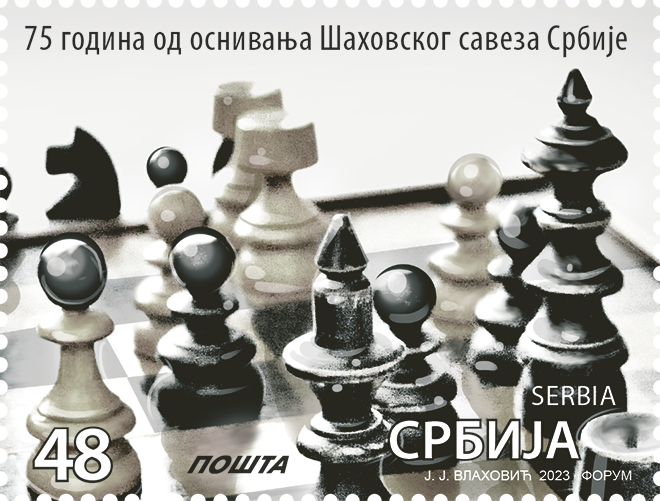
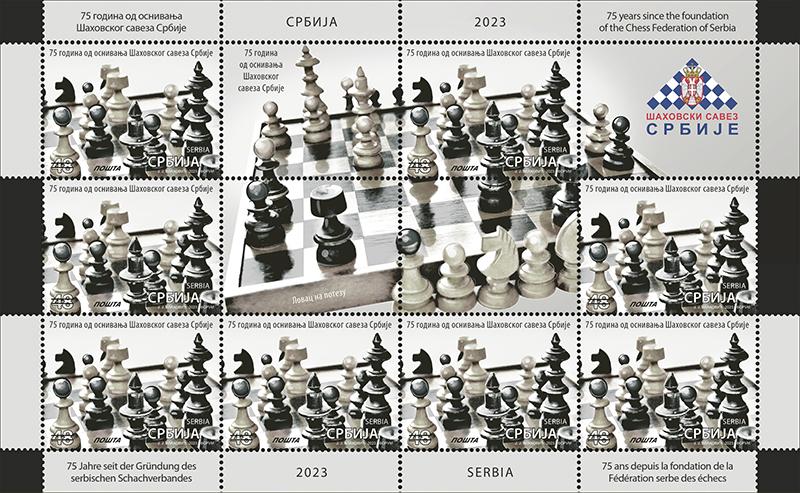
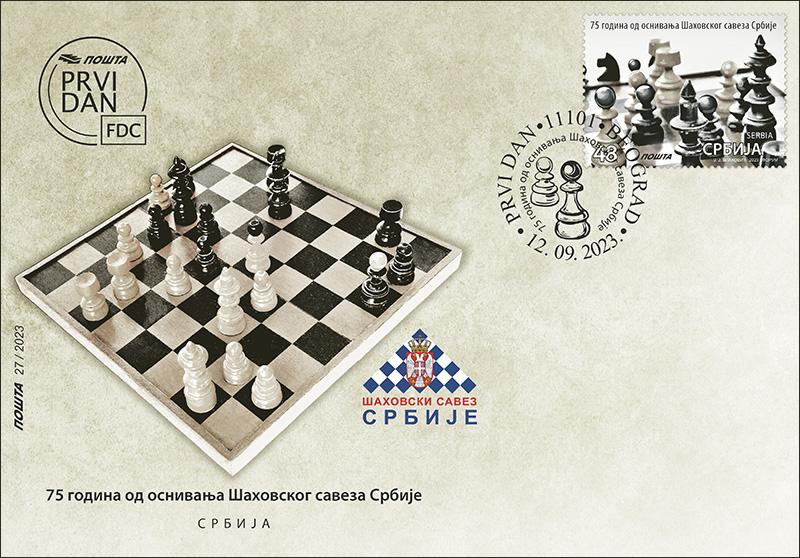
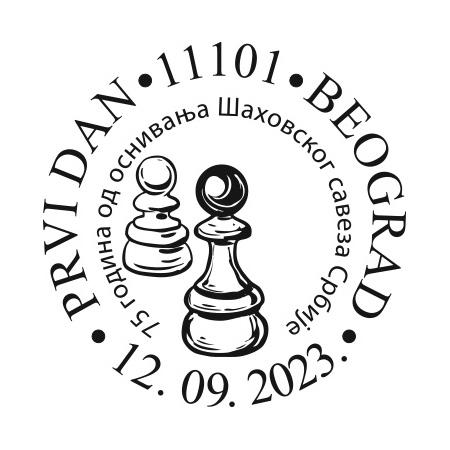
Although chess arrived in Serbia much earlier, modern times have brought the development and progress of this game to our country. The influence of the first grandmaster Bora Kostić between two world wars marked a significant step forward in popularizing of chess in the region. To further the expansion of chess in the postwar years, the Chess Association of Serbia was founded on September 19, 1948, marking the beginning of a golden age for chess in our region.
Serbia was organizer and host to several exceptional chess events, including the radio match Yugoslavia – USA in 1950, the Candidates Tournament in 1959, the Match of the Century (USSR – Rest of the World) in 1970, the final match of candidates for the world champion between Korchnoi and Spaski in 1978, the GMA-JAT in 1988 (an open tournament featuring 100 grandmasters, a historic first in chess history), the Olympics in Novi Sad in 1990, and the rematch of the century between Fischer and Spassky in 1992.
More recently, in 2022, we hosted the FIDE Grand Prix tournament as part of the battle for the world champion title, and in 2023, we organized the First Chess Paralympics in history and the European Individual Chess Championship in Vrnjačka Banja.
During the golden period (from 1950 to 1980), our chess players won 13 Olympic medals, and were six-time vice-champions at the European Team Championships. Female chess players also made their mark, winning two Olympic medals – silver in 1963 and bronze in 1988. In individual competitions, Serbian chess masters achieved remarkable results. Svetozar Gligorić was considered one of the world’s top chess players outside the Soviet Union by the end of the 1950s, while Ljubomir Ljubojević held the same distinction in 1983. In 1992 Alisa Marić played a match to become a challenger for the world champion title.
In 1966, Serbia launched the Chess Informer and introduced a universal chess language of symbols, making a significant contribution to the study of chess theory and the global development of the game.
Expert collaboration: Chess Federation of Serbia
Artistic realization of the issue: MA Jakša Vlahović, academic graphic artist
115 years of diplomatic relations between Serbia and Egypt
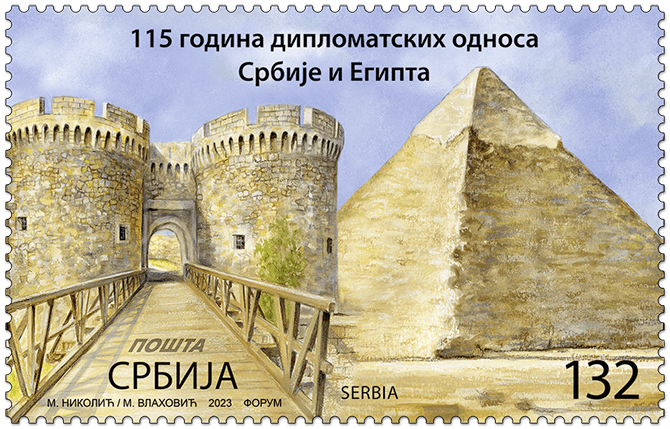

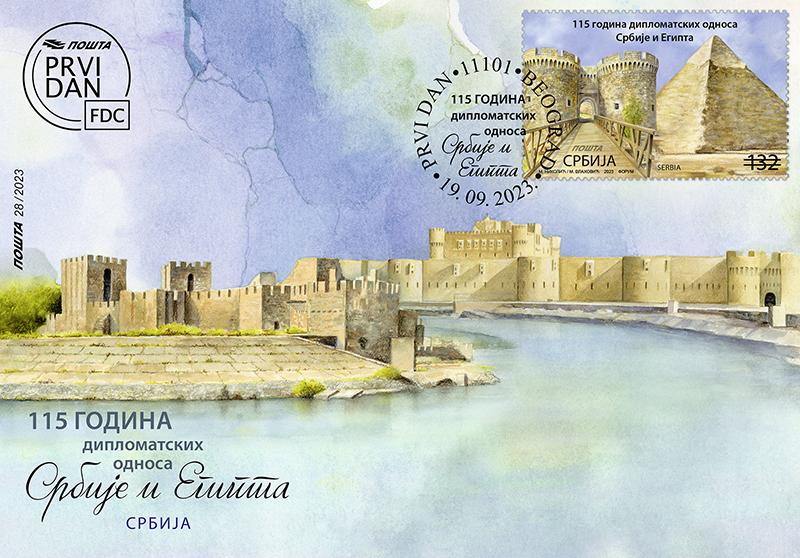
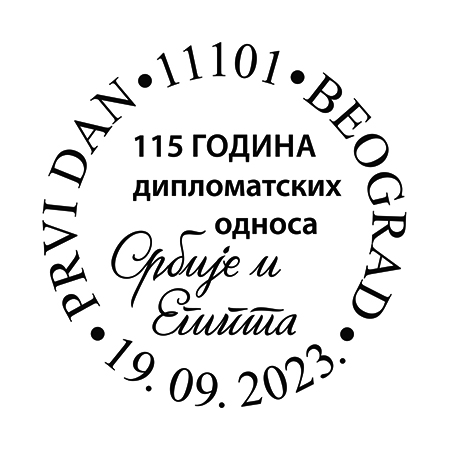
The long tradition of diplomatic and friendly relations between Serbia and Egypt and their two peoples, which dates back to 1908, is based on strong economic and political ties, a tradition of good relations and identical goals and views through a long history of cooperation during which the two nations shared important historical moments.
The Kingdom of Serbia opened a consulate in Cairo as early as 1908, and with the independence of Egypt in 1922, the consulate was raised to the level of a general consulate, and in 1926 it received the status of an embassy. The first chargé d’affaires of the then Kingdom of Serbs, Croats and Slovenes in Egypt was Jovan Dučić. Until the end of the Second World War and immediately after, the relations between the two countries had occasional oscillations, but after the establishment of the Arab Republic of Egypt in 1952, the relations between the two countries took an upward path. The heads of state at the time, Josip Broz Tito and Gamal Abdel Nasser, established a strong friendship between the two countries and exceptional personal relations by sharing, as the founders of the Non-Aligned Movement together with the President of India Jawaharlal Nehru, a common vision of the world in which the Non-Aligned Movement was a counterweight to the block division of the world, colonialism and arms race.
The relations between the two countries in the 21st century experienced a new momentum, and the traditional friendly ties of the two peoples and good economic cooperation between the two countries, especially in the fields of tourism, agriculture and economy, but also information and communication technologies, received a new impulse with the recent historic visit of the Egyptian president Abdel Fattah al-Sisi to Belgrade.
Motif on the stamp: Zindan gate on Kalemegdan and Pyramid of Khafre in Giza. Motif on the envelope: Smederevo fortress in Smederevo and Citadel of Qaitbay in Alexandria.
Expert collaboration: Embassy of Egypt in Belgrade, Serbia Artistic realization of the issue: Miroslav Nikolić Graphic realization of the issue: MA Marija Vlahović, academic graphic artist
200 years since the birth of Sándor Petőfi
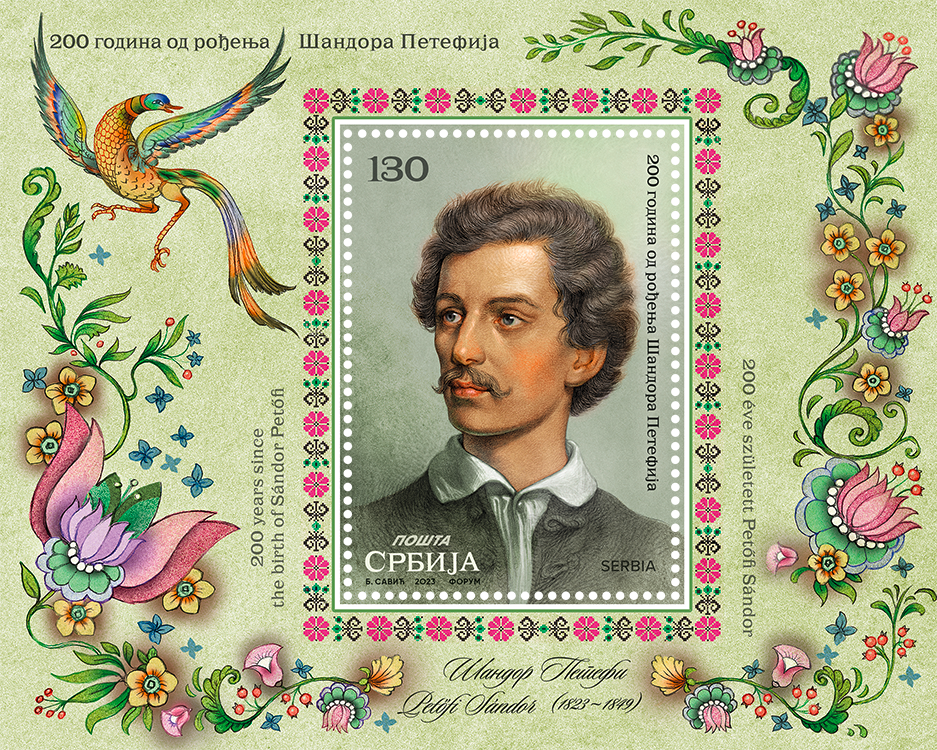
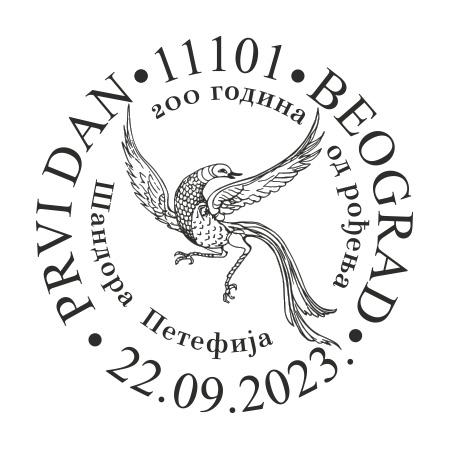
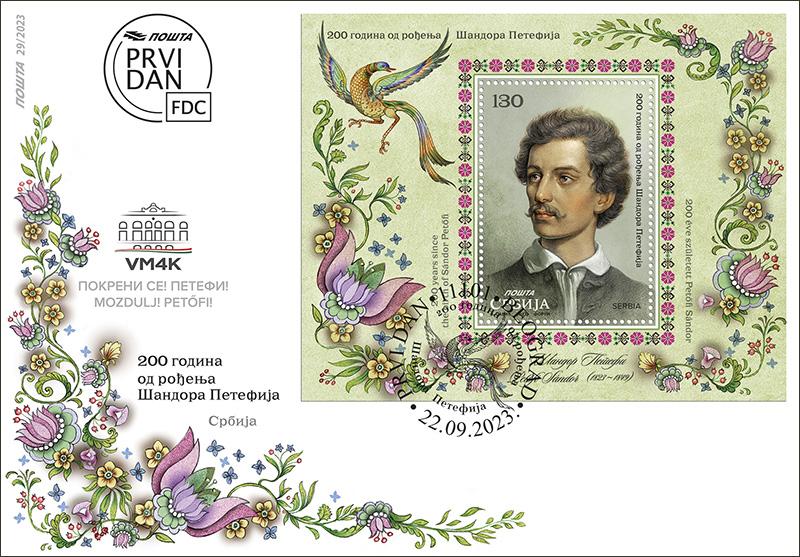
Sándor Petőfi, one of the most significant figures of Hungarian literature, revolutionary, actor, was born on 1 January, 1823 in Kiskeres, todayʹs Hungary, on the territory of the then Austro-Hungarian Monarchy. In his short 26 years of life, he wrote more than 1,000 poems, which were translated into more than 50 languages – into Serbian for the first time by Jovan Jovanović Zmaj, in 1855, from where we count the Serbian reception of Petőfiʹs poetry.
In addition to poetry, his role in the revolution and struggle for freedom in 1848-1849, as well as his glorious demeanor and heroism, made him one of the most significant figures of the Hungarian national myth.
The memory of the poet is cherished throughout Vojvodina, within organization of "VM4K", with POKRENI SE! PETEFI! (MOZDULJ! PETŐFI!) programme – a Vojvodina programme cycle "Petőfi 200".
Expert collaboration: Centre for Education, Research and Culture of Vojvodina Hungarians (VM4K); D.o.o. Magyar Szó Kft., Forum Printing House
Artistic realization of the issue: Boban Savić MA, academic painter
Каталошке информације
22. септембар 2023.
Artistic realization of the issue: Boban Savić MA, academic painter
Бл. 108. (136,00 дин) (вишебојна) 10.000
Табак: блок
На коверту са жигом ПД (FDC)
Нацрт: Бл 108. портрет Шандора Петефија.
Величина марке у блоку: 35 x 49,3
Величина блока: 100 x 80 mm
Joy of Europe
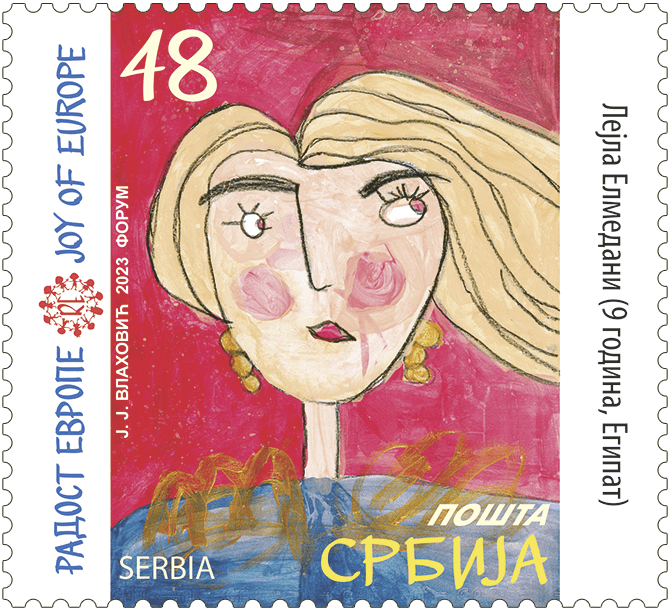
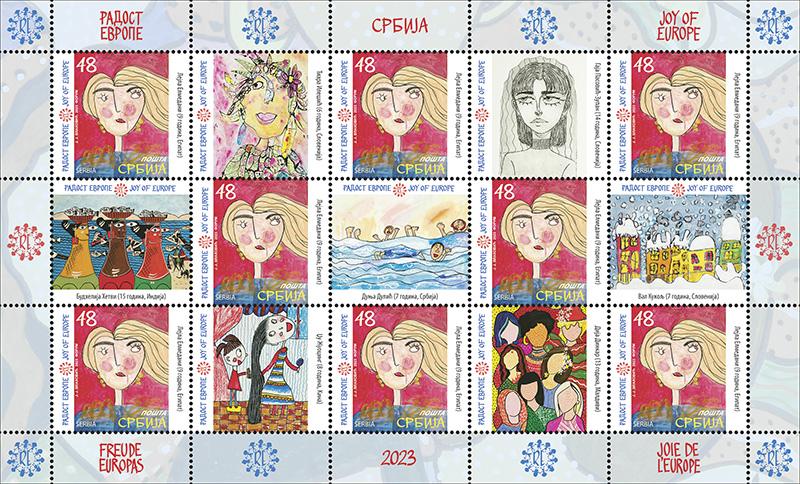
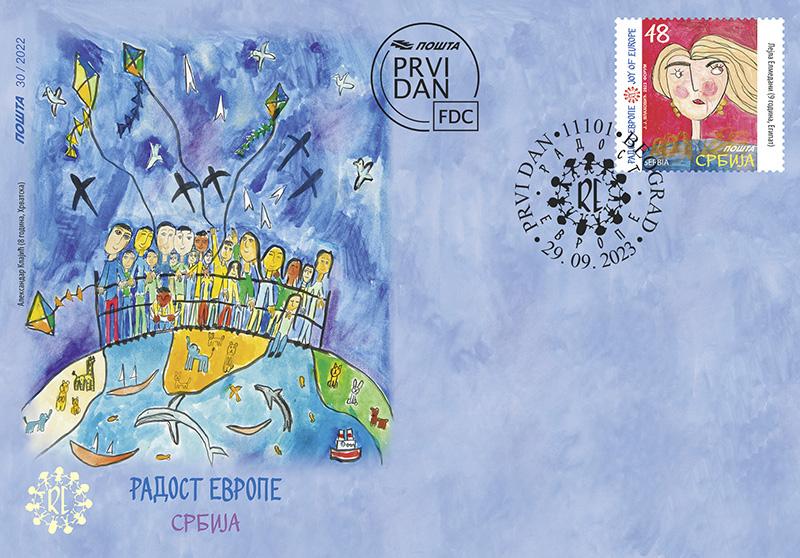
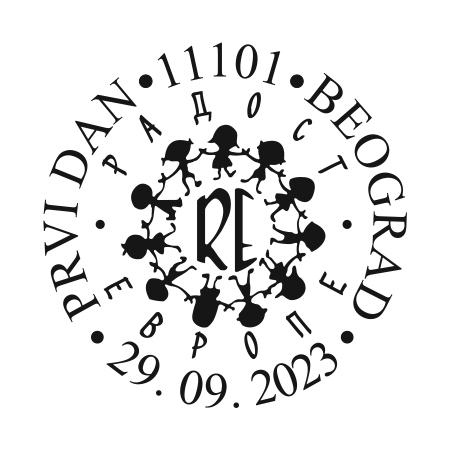
In 1969, on the occasion of the World Children’s Day, the first international festival of children’s songs and dances “Joy of Europe” was held in Belgrade with the support of the city government, President Tito, UNICEF and the United Nations General Assembly. More than half a century has passed since then and over 20,000 children have visited Belgrade. From the beginning, the main pillar of the event has been the hosts – parents, who welcome boys and girls from Europe into their homes, offering our traditional hospitality. The main idea of the event was and remains getting to know each other and creating friendships, and children’s play is at the centre of all events.
Exactly 25 years ago, in 1998, the 25th jubilee meeting “Joy of Europe” received a new program content – the International Art Competition, in which individuals, preschool institutions, schools, children’s art studios, children’s cultural centres and similar institutions participate since its establishment as well as associations from all over the world (children and the youth aged 4 to 18). Artworks created in the pencil, tempera, gouache, watercolour, pastel, ink, collage or graphics techniques have been making up the rich palette of the traditional manifestation for 25 years. They also find their place on the commemorative postage stamps “Joy of Europe” as a testimony that only the original, hand drawn and naive, carries fresh and strong creative power, because children have always drawn and enjoyed the creative process itself.
This stamp supports a natural and creative way of living in the most beautiful way possible!
The motif on the stamp is the work of Layla Elmedany (age 9, Egypt). The authors of the works on the vignettes are as follows: Tiara Ilešić (6 years old, Slovenia), Gaja Pasović-Zupan (14 years old, Slovenia), Budheliya Hetvi (15 years old, India), Dunja Dulić (7 years old, Serbia), Val Kukolj (7 years old, Slovenia), Ruo Qing Zhu (8 years old, China), Diya Dinkar (13 years old, Maldives). The author of the work on the envelope is Aleksandar Klajić (8 years old, Croatia).
Expert collaboration: Lidija Seničar, editor of the International Art Competition “Joy of Europe”, Children’s Cultural Centre Belgrade
Graphic realisation of the issue: MA Jakša Vlahović, academic graphic artist
Каталошке информације
29. септембар 2023.
Графичка реализација: Јакша Влаховић, академски графичар
1260. 48,00 дин (вишебојна) 25.000
Табак: 8
На коверту са жигом ПД (FDC)
Нацрт: 1260. цртеж Лејле Елмедани (9 година, Египат)
Величина марака : 35 x 31,9 mm
70 years of the daily paper “Večernje novosti”

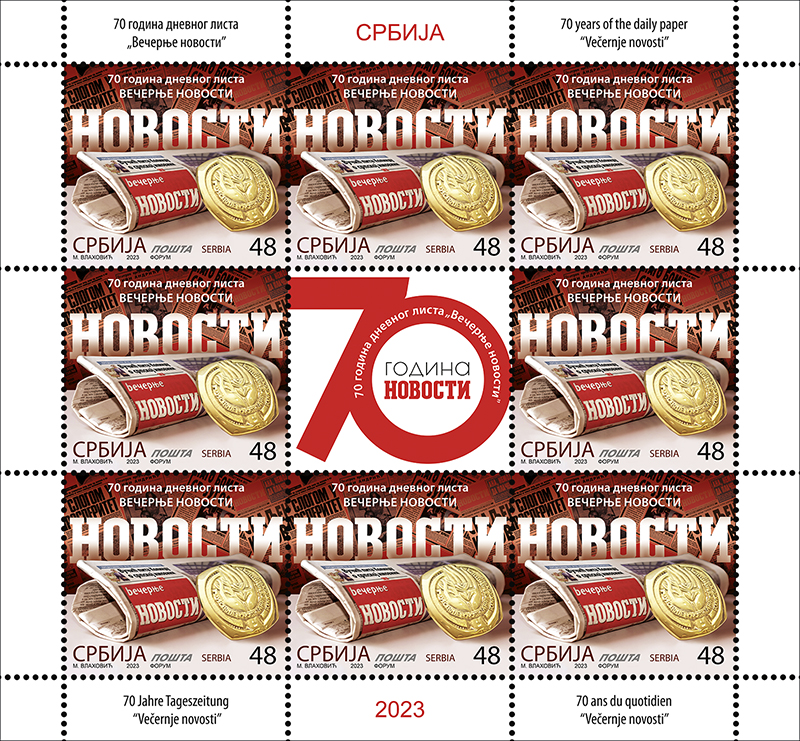
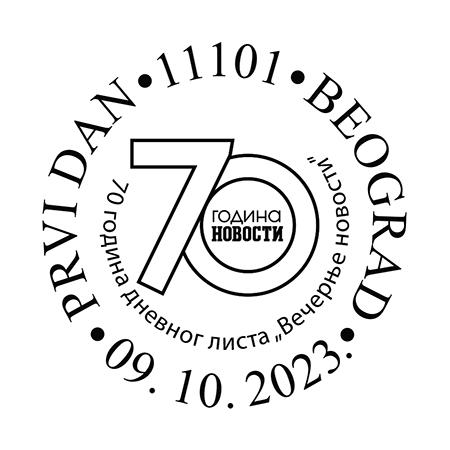
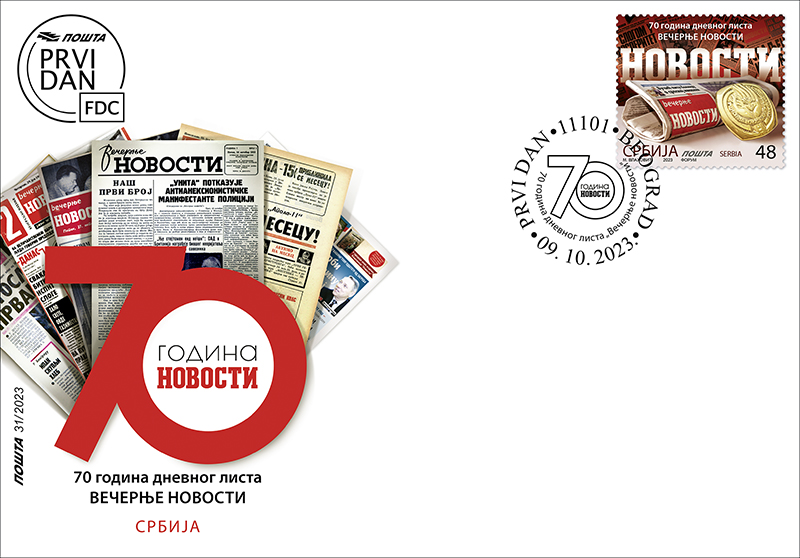
”VEČERNJE NOVOSTI” A JOURNALIST CONCEPT
When “Večernje novosti” appeared on the streets of Belgrade in the hands of colporteurs, on the eve of October 16, 1953, in the midst of the Trieste crisis, no one could have dreamed that the paper that was the first to emerge from the cliché would live to see its 70th birthday.
The idea of starting “Večernje novosti” came from the famous journalist, publicist and historian Vladimir Dedijer, and the first editor-in-chief of the first Yugoslav “večernjak” (evening paper) was Slobodan Glumac. The circulation of the first issue was 14,501 copies. It had only eight pages. In its golden age, “Novosti” printed more than 800,000 copies a day, which is why they still hold all the records in our region. A lot of time has passed, the world has changed, but the motto “quick, short, clear”, which was the essence of the journalistic concept, has become an imperative of modern journalism in our country. Seven decades with the people, daily fresh and current, “Novosti” has been the formula of a good newspaper, a recognized school of journalism, a measure of professional standards and a faithful interpreter of people’s lives.
Expert collaboration: Večernje novosti Graphic realization: MA Marija Vlahović, academic graphic artist
Каталошке информације
9. октобар 2023.
Графичка реализација: Марија Влаховић, академски графичар
1261. 48,00 дин (вишебојна) 25.000
Табак: 8
На коверту са жигом ПД (FDC)
Нацрт: 1261. насловне стране „Вечерњих новости”
Величина марака : 35 x 31,9 mm
125 years since the birth of Milan Konjović
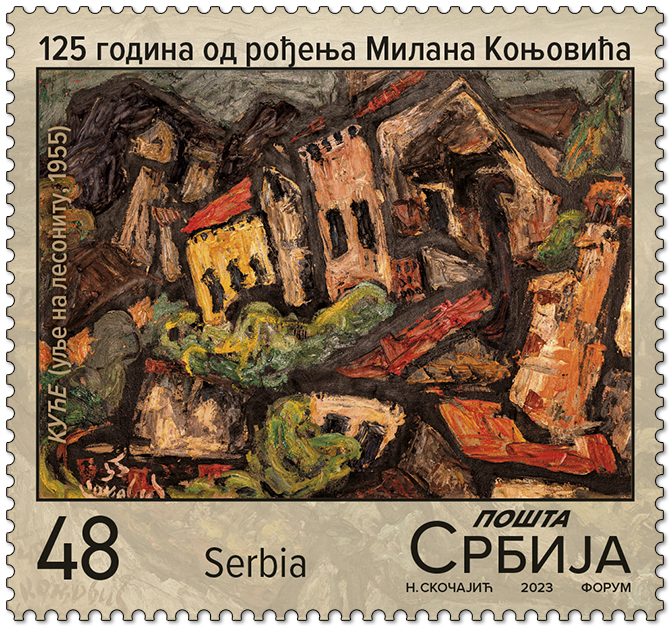
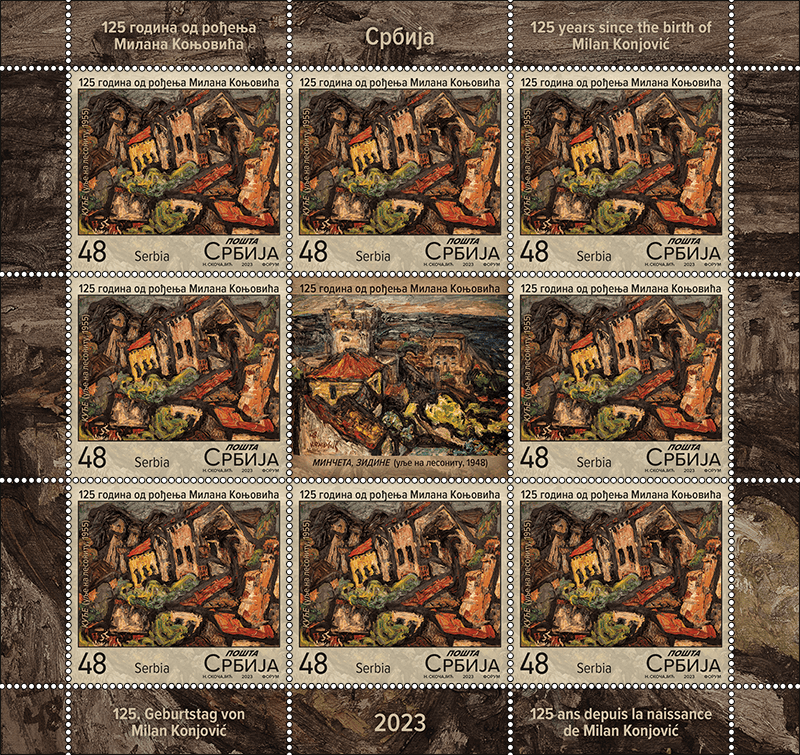
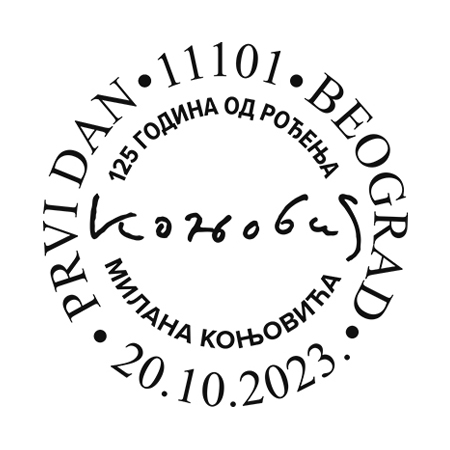
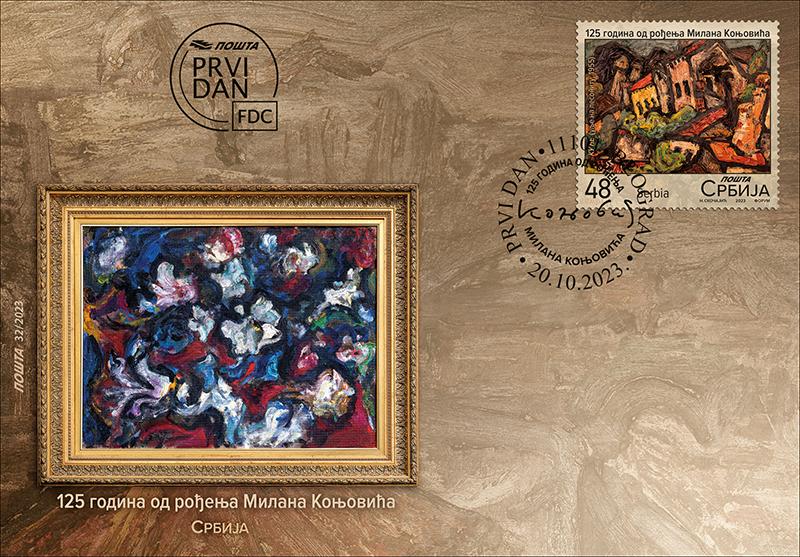
Milan Konjović (Sombor, June 28, 1898 – January 28, 1993, Sombor), a painter whose art leaves a deep impression on people with its originality and emotional charge. A rich artistic oeuvre of more than 6,000 works includes different phases and styles, and his palette of paintings consists of landscapes, portraits, abstract compositions and much more.
He showed his gift for art very early, he studied at the Belgrade Art School and then in Prague and Vienna, where he adopted European influences. His painting spans various periods, including expressionism, post-impressionism and abstraction, and some critics have called him "the last Fauvist". His paintings often reflected a deep connection with nature and rural life, and one of his most famous painting cycles is the one inspired by Vojvodina.
Konjović's works are exhibited in many galleries and museums around the world. He left a permanent mark in Serbian art history and remains remembered as one of the most important painters of his time.
Stamp motif: "Houses", oil on hardboard, 1955, from a private collection. Vignette motif: "Minčeta, Tower", oil on hardboard, 1948, from a private collection. Envelope motif: "Flowers", oil on hardboard, 1977, from the collection of PE Post of Serbia.
Graphic realization: MA Nadežda Skočajić, Academic Graphic Artist
Каталошке информације
20. октобар 2023.
Графичка реализација: Надежда Скочајић, академски графичар
1262. 48,00 дин (вишебојна) 25.000
Табак: 8
На коверту са жигом ПД (FDC)
Нацрт: 1262. „Куће”, уље на лесониту, аутора Милана Коњовића, 1955,
Величина марака : 42 x 39,15 mm
10 years of Air Serbia
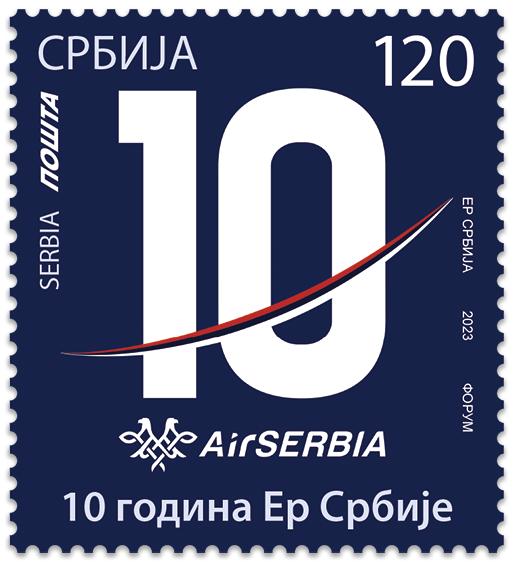
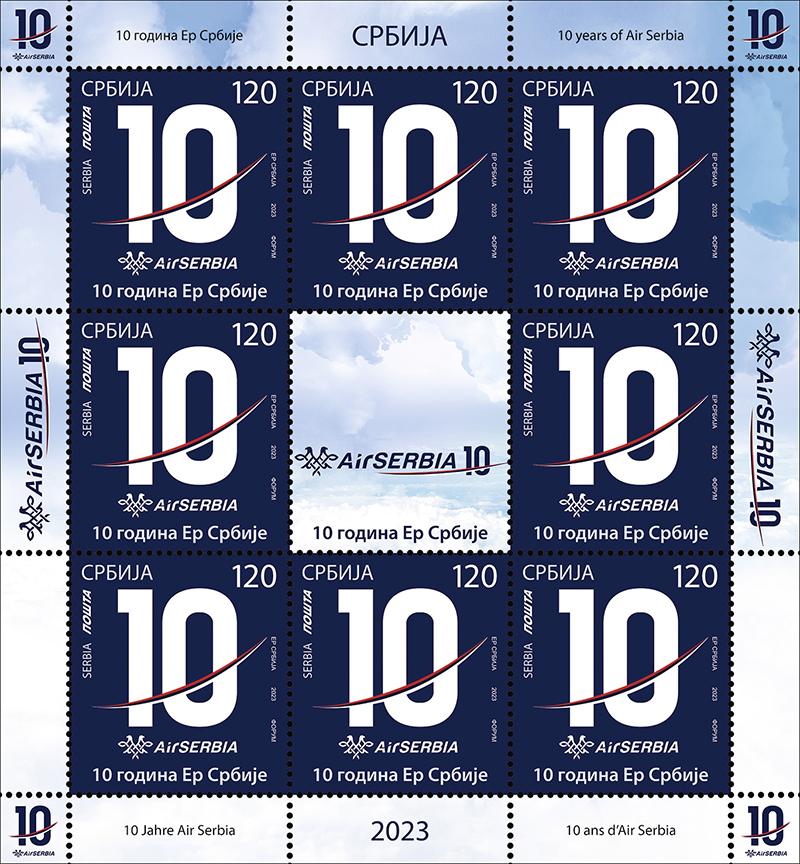
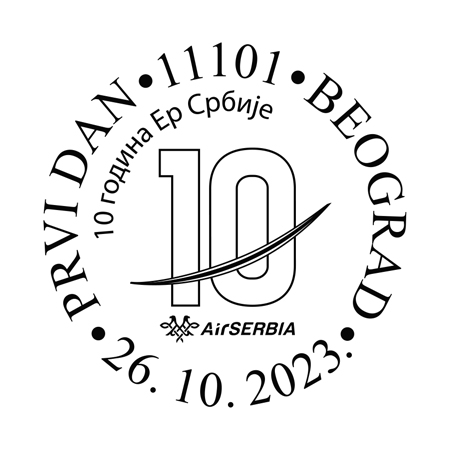
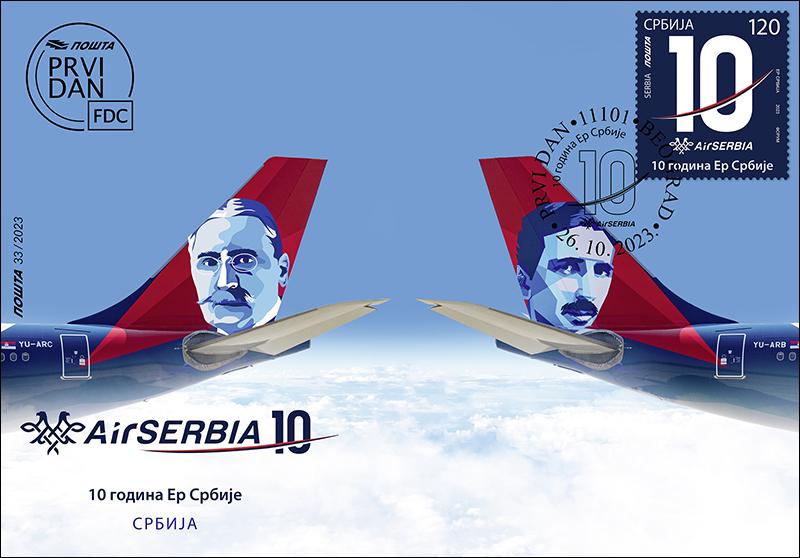
The first flight of the Serbian national airline under the name Air Serbia and with a new visual identity took place on 26 October 2013. During 10 years of operation, the company grew, focusing all its efforts on improving services and development of employees, fleet, and its network of destinations.
Employees are the most important resource of Air Serbia. They set high goals and work hard to attain them despite many challenges, achieving excellent results. The Serbian national airline fosters gender equality, as evidenced by the fact that half of its employees are women. One of the memorable events in Air Serbia’s history was the flight from Belgrade, in May 2017, made by an all-female crew.
The fleet of the Serbian national airline has been completely renewed over the past decade. Today it consists of Airbus A330-200 wide-body aircraft, narrow-body aircraft from the Airbus A320 family, and ATR 72-600 turboprop aircraft for regional flights. Continuous work is being done on the further expansion and improvement of the fleet.
Air Serbia’s network of destinations continues to grow year after year. Today, the company flies to more than 80 scheduled and charter destinations in Europe, the Mediterranean, North America, Asia, and Africa.
In June 2016, after a break of a quarter of a century, direct flights between Belgrade and New York were re-established, with Air Serbia becoming the only airline in the wider Balkan region operating direct flights to the United States of America.
From 9 December 2022, the Serbian national airline once again flies to the People’s Republic of China, i.e. between Belgrade and Tianjin, and has declared its firm intention to expand its operation to include other important Chinese cities.
Chicago, the third long-haul route of the Serbian national airline and the second in North America, was established on 17 May 2023, after a hiatus of more than 30 years. From the very beginning, it proved to be successful and useful for travellers, significantly contributing to better business, tourism, and all other connections between Serbia and the United States.
During the coronavirus pandemic, Air Serbia made all its resources available to the state and the people of Serbia. During the state of emergency, in cooperation with state bodies and organizations, numerous special flights were operated transporting more than 10,000 people stranded outside their home countries due to the pandemic. The Serbian national airline also made dozens of cargo flights that delivered hundreds of tons of medical equipment and materials to our country.
With over 1,400 employees, the youngest fleet in the region, a growing network of destinations, and a clearly defined sustainable development strategy, Air Serbia opens a new decade of business, ready to adapt to any change in the market, to operate profitably and constantly improve its service in the interests of passengers.
Стручна сарадња: Ер Србија Графичка реализација: Марија Влаховић, академски графичар
Каталошке информације
26. октобар 2023.
Графичка реализација: Надежда Скочајић, академски графичар
1263. 120,00 дин (вишебојна) 25.000
Табак: 8
На коверту са жигом ПД (FDC)
Нацрт: 1263. јубиларни лого „10 година Ер Србије” званичног графичког идентитета Ер Србије
Величина марака : 31,9 x 35 mm
Centenary of the Proclamation of the Republic of Turkiye
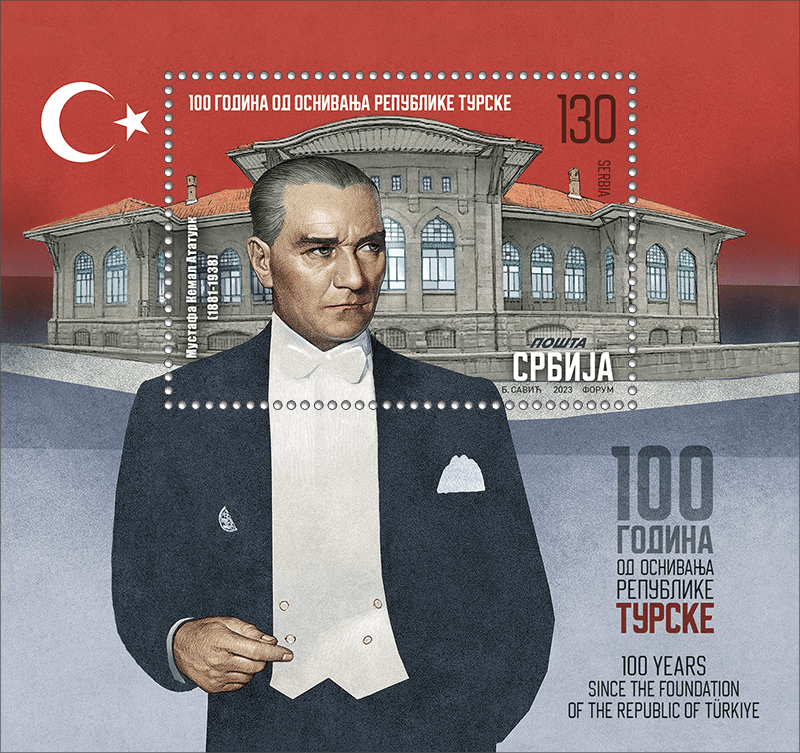
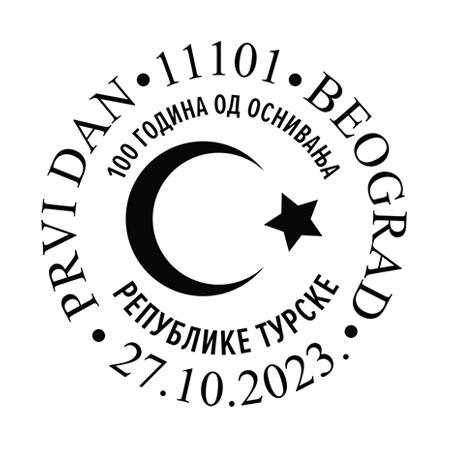
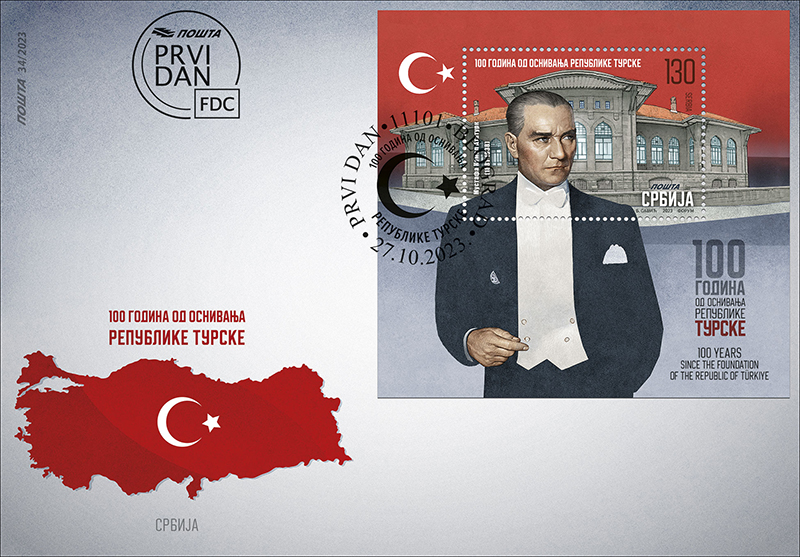
The Republic of Türkiye was proclaimed on October 29, 1923. Mustafa Kemal Atatürk is the founder and the first President of the Republic of Türkiye. Atatürk was not only the commander-in-chief of the War of Independence but also an exceptionally gifted statesman who implemented reforms with a lasting impact on Turkish society.
This commemorative stamp issued on the occasion of the centenary of the proclamation of the Republic of Türkiye symbolizes the determination of the Republic of Serbia to deepen the open and friendly bilateral relations based on cooperation and mutual trust between the two countries, which are already at the most advanced level in history.
In collaboration with the Embassy of the Republic of Türkiye in Belgrade
Artistic realization of the issue: Boban Savić MA, academic painter
115 years since the birth of Jevgenij Vučetić
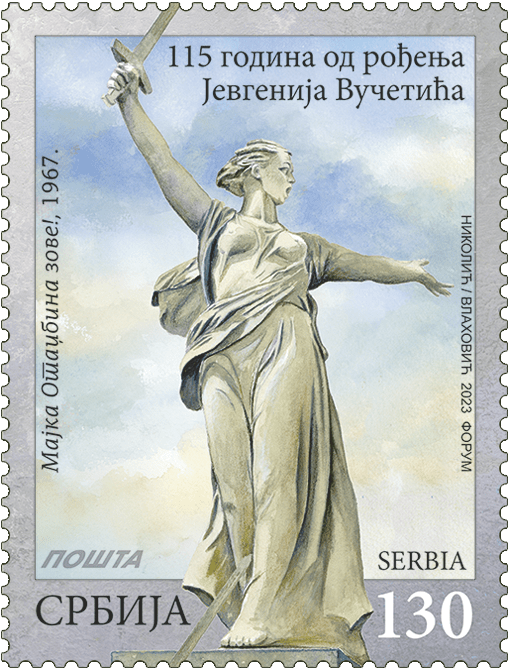
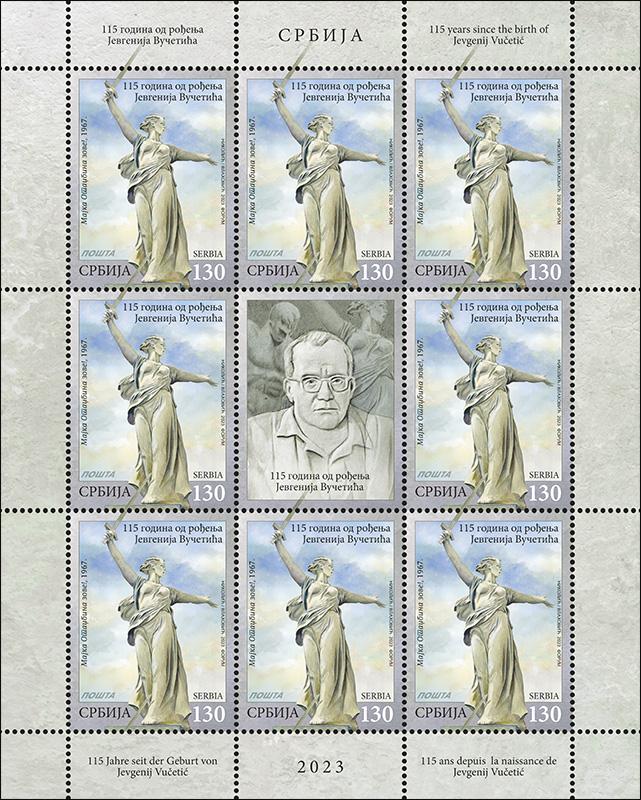
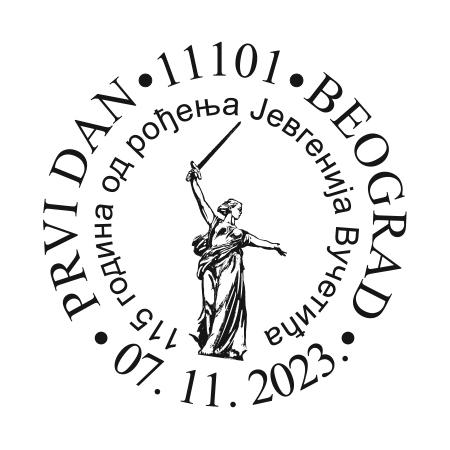
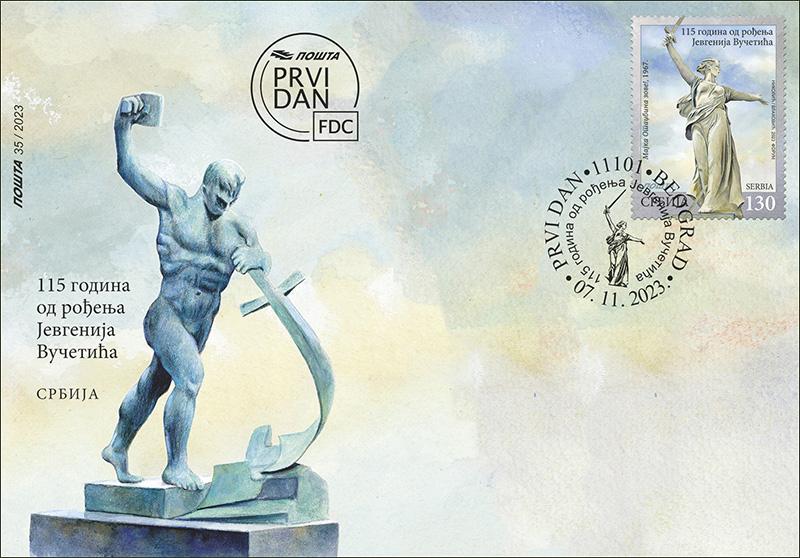
Yevgeny Viktorovich Vuchetich (Yekaterinoslav, December 28, 1908 – Moscow, April 12, 1974). Serbian by origin on his father’s side, of French blood on his mother’s side, he showed an artistic gift from his early childhood. He studied sculpture at the Leningrad Institute of Proletarian Fine Arts. He is one of the creators of the “Stalinist classicism” style. He participated in the Great Patriotic War and received the highest honours in the Soviet Union. He was a member of the Presidium and vice-president of the USSR Academy of Arts.
Motif on the stamp: the statue “The Motherland Calls!”, 1967, on the Mamayev Kurgan hill in Volgograd, dedicated to the heroes of the Battle of Stalingrad.
Motif on the vignette: portrait of Yevgeny Vuchetich.
Motif on the envelope: “Let Us Beat Swords into Plowshares!” statue, 1959, New York.
Expert coollaboration: The Russian House — Russian Centre of Science and Culture in Belgrade
Artistic realisation: Miroslav Nikolić
Graphic realisation of the issue: MA Jakša Vlahović, academic graphic artist
Каталошке информације
7. новембар 2023.
Уметничка реализација: Мирослав Николић. Графичка обрада издања: Јакша Влаховић, академски графичар
1265. 130,00 дин (вишебојна) 25.000
Табак: 8
На коверту са жигом ПД (FDC)
Нацрт: 1265. статуа „Мајка Отаџбина зове!”, 1967
Величина марака : 31,9 x 42 mm
Serbia-China: 10 years since the establishment of the ‘’Belt and Road’’ Initiative
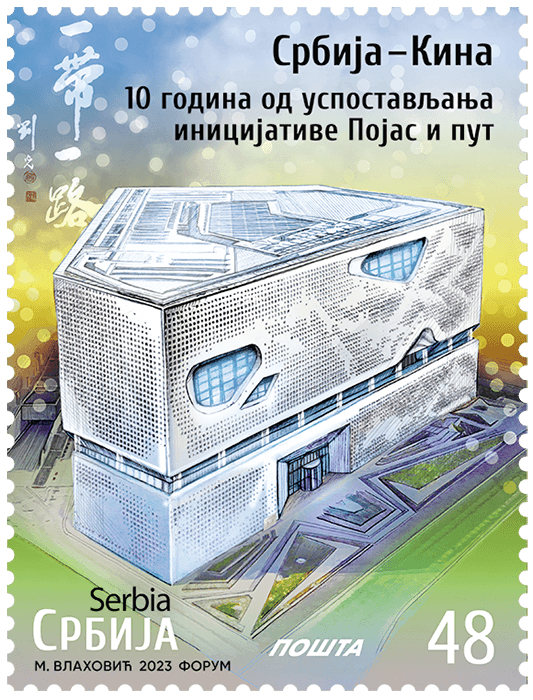

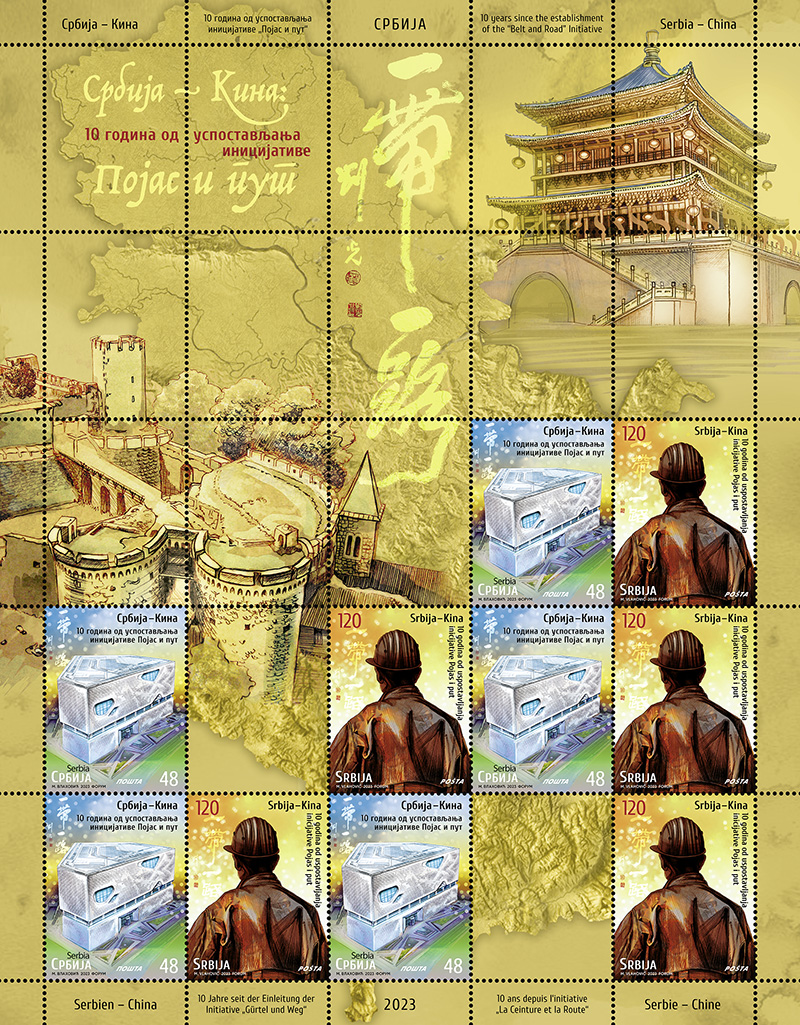
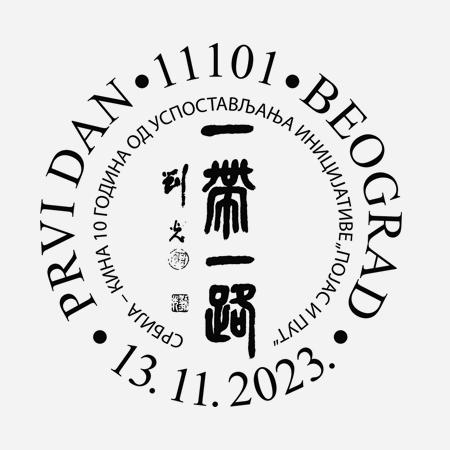
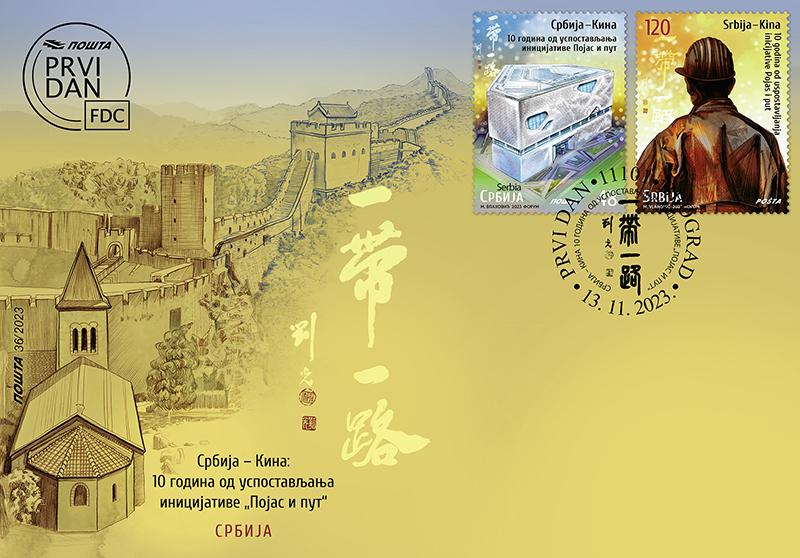
In 2013, Xi Jinping, President of the People’s Republic of China unveiled the ‘’Belt and Road’’ Initiative. Currently, more than 150 countries and 30 international organizations are participating in this endeavor. ‘’Belt and Road’’ Initiative is based on the ancient Silk Road, the trade route that allowed for people from different cultural backgrounds to encounter, make acquaintances, and cooperate. Within the framework of the ‘’Belt and Road’’ Initiative, Serbia and China are achieving significant cooperation in the field of economy and development of infrastructure projects in Serbia.
The motif on the 48 dinars stamp is the China Cultural Center Building in Belgrade.
The motif on the 120 dinars stamp is a worker in a smelter for the processing of raw copper ore in Serbia.
The motives on the sheet: Xi’an Bell Tower, the architectural symbol of the starting point of the ancient Silk Road - Xi’an City; Kalemegdan fortress in Belgrade; the inscription “Belt and Road” in Chinese, made in the traditional Chinese calligraphy technique in the Tsao style.
The motif on the first day cover: Kalemegdan Fortress and the Great Wall of China.
Expert cooperation: University Library “Svetozar Marković”, Belgrade, China Cultural Center in Belgrade.
Artistic realisation of the issue: MA Marija Vlahović, academic graphic artist.
Chinese calligraphic artist: Liu Guang.
Каталошке информације
13. новембар 2023.
Artistic realization: Marija Vlahović, Academic Graphic Artist
1266. 48,00 дин (вишебојна) 25.000
1267. 120,00 дин (вишебојна) 25.000
Sheet of: 10
На коверту са жигом ПД (FDC)
Нацрт: 1266. зграда Кинеског културног центра у Београду
Нацрт: 1267. радник у постројењу за прераду руде бакра у Србији
Величина марака : 31,9 x 42 mm
Tourism - 650 years of the castle of Užice
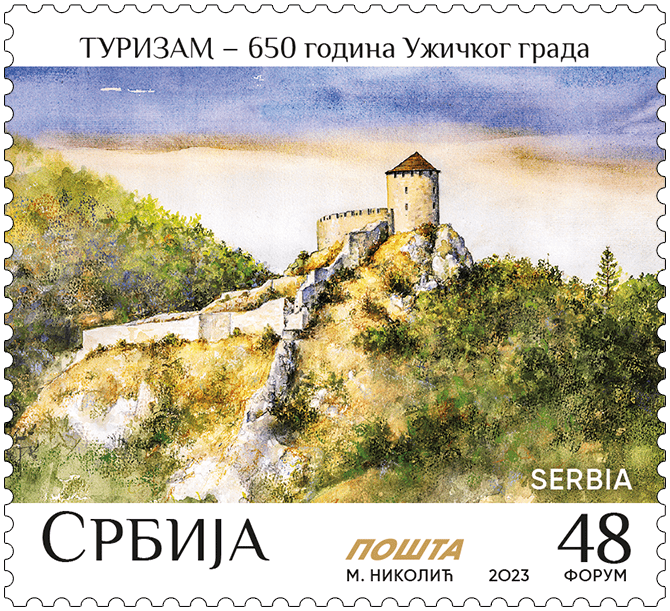

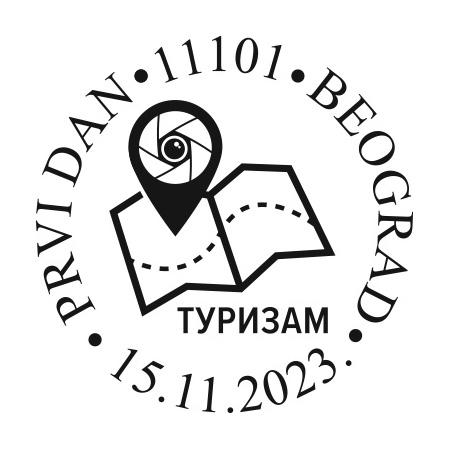
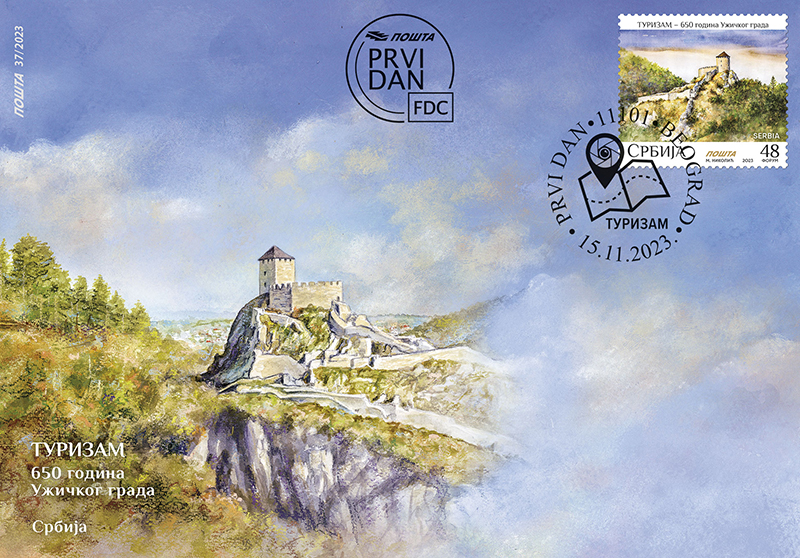
Serbia’s tourist offer is based on rich tradition, history and culture, natural beauty and human achievements that are worth seeing, and fortress architecture represents an important aspect of Serbia’s tourist offer.
The castle of Užice, a medieval fortress built in the second half of the 14th century, is the historical and cultural pearl of the city of Užice. The imposing fortress complex, located on a hill above the Djetinja River, was first mentioned in written documents from the 14th century as the main seat of the prefect Nikola Altomanović, built to protect the caravan route that connected the Moravian Valley with Bosnia, Huma and the Adriatic coast.
The medieval castle is located on a high, steeply cut and inaccessible rock on three sides, at the bend of the Djetinja river, west of today’s Užice. The defense system of the castle consisted of three separate units of stone walls and towers, interconnected. On top of the rock was the main part of the castle, which was dominated by a six-sided donjon, surrounded by walls. A four-sided tower rose above the river itself, and a semicircular tower hid a well. That part of the castle was connected by stone walls to the most spacious, quadrangular middle part, in which there were three towers and several buildings for the crew, and it was separated from the upper part by a wall in front of which there was a defense tower.
From 1373, the castle of Užice came under the possession of Prince Lazar, then became part of the Serbian Despotovina, and in 1445 fell under Turkish rule. The fortress was finally abandoned at the end of 1862 when, according to the agreement with Prince Mihailo, the Ottoman military crew left. In 1863, it was blown up and disabled for further military use.
Today, the partially reconstructed fortress, with preserved walls and restored citadel and tower in Gornji Grad, is one of the most visited tourist attractions in Užice.
Expert collaboration: Historical archive of Užice
Artistic realization of the issue: Miroslav Nikolić
Каталошке информације
15. новембар 2023.
Уметничка реализација: Мирослав Николић. Графичка обрада издања: Надежда Скочајић, академски графичар
1268. 48,00 дин (вишебојна) 25.000
Табак: 8
На коверту са жигом ПД (FDC)
Нацрт: 1268. средњовековна тврђава Ужички град
Величина марака: 35 x 31,9 mm
Protected animal species
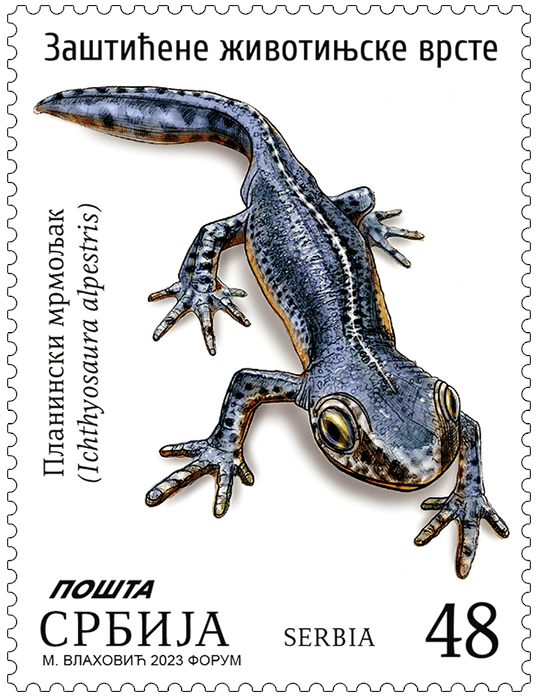
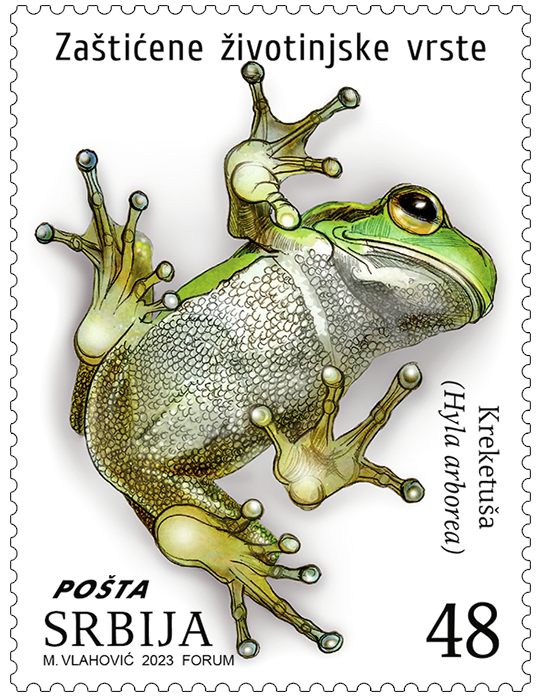
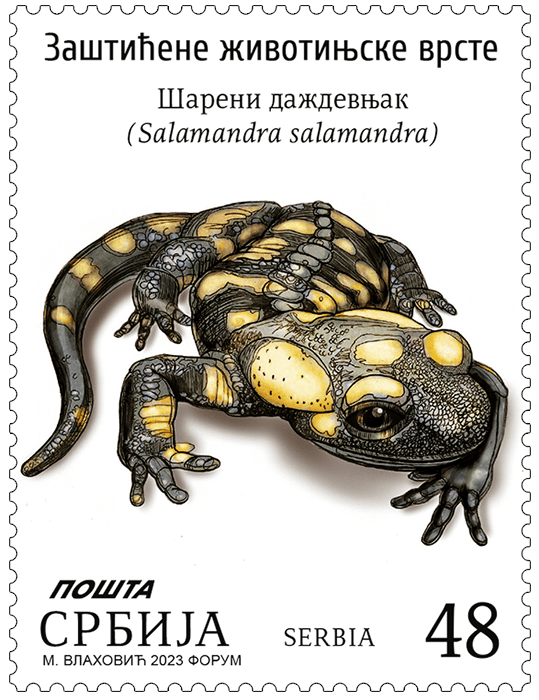
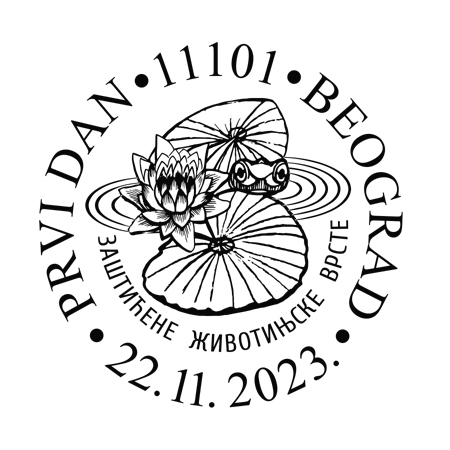
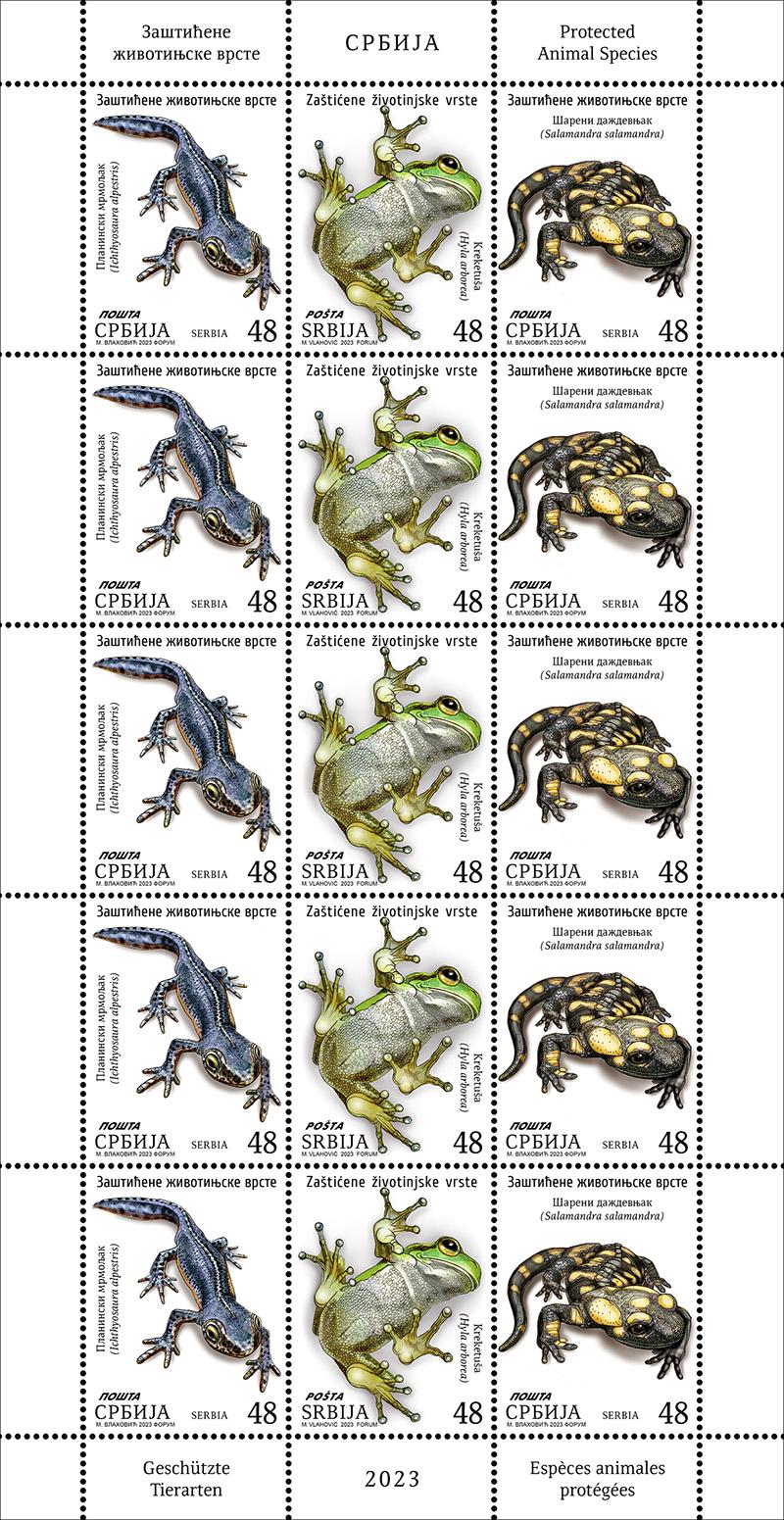
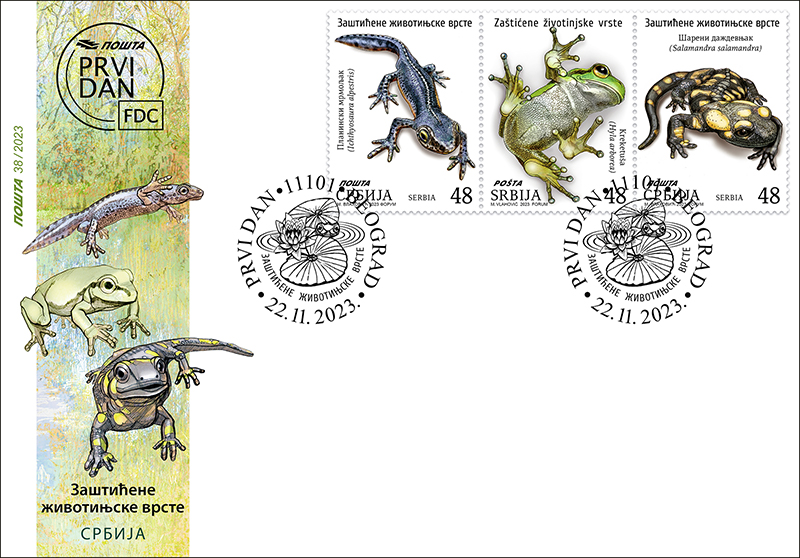
Amphibians (Amphibia) are the oldest representatives of terrestrial vertebrates and form a ”transition” between fish and true terrestrial vertebrates. This group of animals includes various species of frogs, salamanders, newts and related animals. 14 species of frogs and eight species of tailed amphibians live in Serbia, of which 18 species are strictly protected.
Alpine newt (Ichthyosaura alpestris) inhabits predominantly hilly and mountainous areas in Serbia. The length of its tail is approximately equal to the length of its body with its head. The dorsal surface of the body is dark, gray, brown or olive, sometimes completely black, with indistinct light spots often present on the back and sometimes on the sides. The ventral side is light yellow or orange.
European tree frog (Hyla arborea) also known as ”gatalinka” is a tailless amphibian whose color varies depending on the coloration of its surroundings, and because of that, it blends in perfectly in the environment where it lives. Males, smaller and lighter than females, have an internal inflatable vocal sac to amplify the sound, and the throat bulges out a lot during sound production. They are mostly light green in color, and their belly is usually white. Although they do not avoid daylight, they are most active in the evening hours. It's folk name gatalinka comes from the belief that it is capable of predicting (”gata”), what the weather will be like.
Fire salamander (Salamandra salamandra) is the largest tailed amphibian of Central Europe, with the longest lifespan. It lives up to two decades and reaches a length of up to twenty-two centimeters. The salamander has a large, flat head, on which there are marked parotid glands that secrete a poisonous secretion. Its striking black and yellow color warns potential predators that it is inedible. It lives mainly in deciduous forests of hilly and mountainous regions, in moist habitats near water.
Expert collaboration: Ana Paunović, PhD, Museum Advisor, Museum of Natural History, Belgrade
Artistic realization: Marija Vlahović, Academic Graphic Artist
Каталошке информације
22. новембар 2023.
Artistic realization: Marija Vlahović, Academic Graphic Artist
1269. 48,00 дин (вишебојна) 25.000
1270. 48,00 дин (вишебојна) 25.000
1271. 48,00 дин (вишебојна) 25.000
Табак: 15
На коверту са жигом ПД (FDC)
Нацрт: 1269. Планински мрмољак (Ichthyosaura alpestris)
Нацрт: 1270. Крекетуша (Hyla arborea)
Нацрт: 1271. Шарени даждевњак (Salamandra salamandra)
Величина марака : 31,9 x 42 mm
100 years of the Milanković calendar

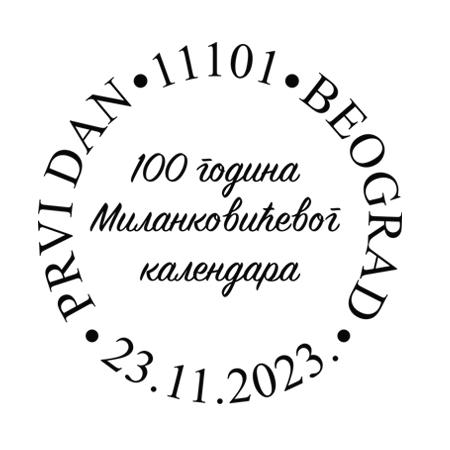
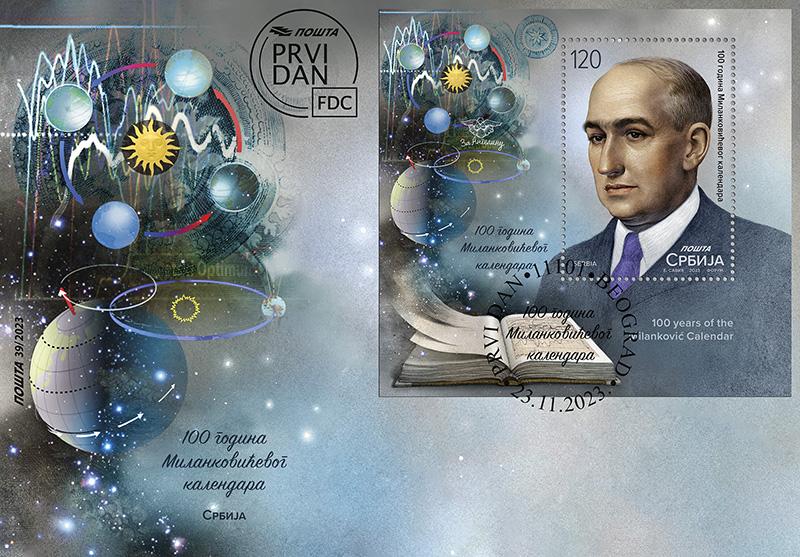
Milutin Milanković (Dalj, May 28, 1879 – Belgrade, December 12, 1958) was a civil engineer, mathematician, astronomer, climatologist and popularizer of science. Full professor of celestial mechanics, dean of the Faculty of Philosophy, director of the Astronomical Observatory in Belgrade and vice president of SASA, he was remembered in the history of science, first of all, for his theory about changes in the Earth,s climate over a long period of time, known as Milanković cycles, as well as the reform of the Julian calendar.
Rejecting a very lucrative career as a construction engineer in Vienna, Milanković came to Belgrade on a modest salary as a university professor for patriotic reasons and out of love for science. He is our greatest scientist who built his career in Serbia.
The reform of the Julian calendar, proposed by Milutin Milanković in 1923, is based on the idea of abolishing the date difference between the Julian and Gregorian calendars, as well as calculating leap years in the future in a specific way that ensures much greater precision of this calendar compared to the Gregorian one.
Based on very complex mathematical calculations, Milanković proposed the most accurate calendar up to that time, which has not been surpassed to this day. Milanković 's scientific work on the theory of climate change and the alignment of the calendar with astronomical events speak best of his commitment to science and precision in the study of astronomical and climatic changes over long time intervals.
Expert collaboration: ”Svetozar Marković” University Library, Belgrade
Artistic realization of the issue: Boban Savić MA, academic painter
Каталошке информације
23. новембар 2023.
Artistic realization of the issue: Boban Savić MA, academic painter
Бл. 110. (130,00 дин) (вишебојна) 10.000
Табак: блок
На коверту са жигом ПД (FDC)
Нацрт: Бл 110. портрет Милутинa Миланковићa.
Величина марке у блоку: 49,3 x 35
Величина блока: 85 x 80 mm
100 years of basketball in Serbia
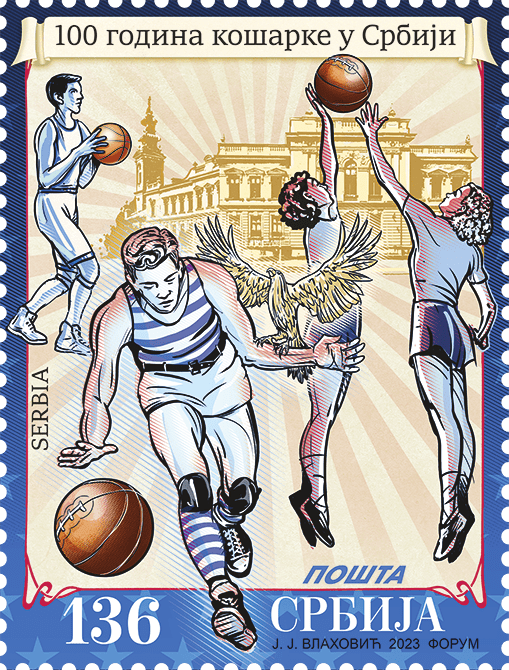

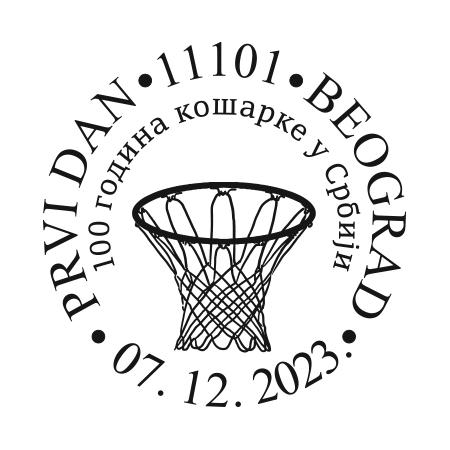
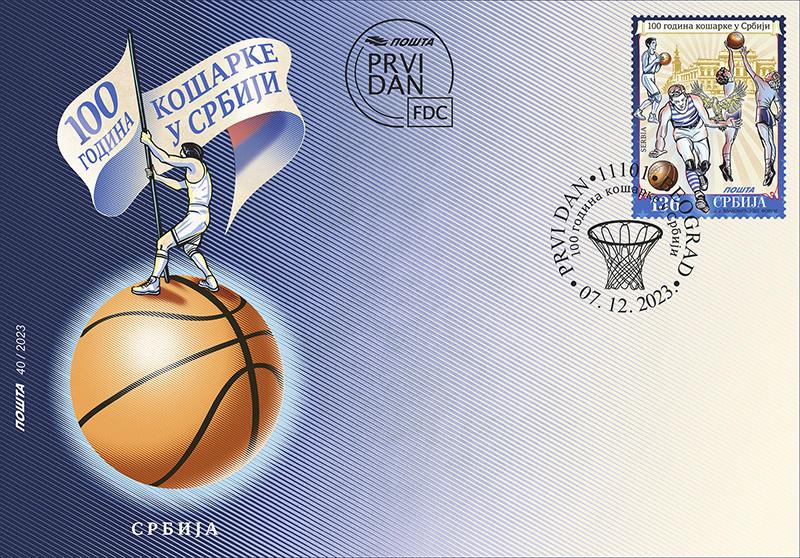
Basketball was invented in 1891 by Springfield College professor James Naismith, and his colleague William Weiland, a professor of folklore and folk sports from Oakland, an emissary of the American Red Cross, while demonstrating American sports games in Europe, brought constructions for basketball baskets and balls to Belgrade in 1923. This event marked the birth of one of the greatest basketball superpowers in the history of the sport. Weiland gave basketball courses to high school students, physical education teachers and members of the Sokol organization, then the largest sports organization. Weiland left, the baskets remained in the Second Men’s Gymnasium, and basketball started to be played more massively and increasingly better. In 1940, 170 male and female players in four age categories took part in the All-Sokol Rally in Borovo, and the first clubs were formed on the eve of the war, as sections of football clubs. Basketball continues to live even during the war. In September 1941, the Belgrade Championship was organized, and in the spring of 1942, the Serbian Basketball and Volleyball Association was founded, which registered 23 clubs. The President of the Association was a student of Weiland’s course from 1923, Svetislav Bata Vulović, and during the occupation, over 15,000 people watched the matches, which were played in Tašmajdan and Kalemegdan. Already in 1945, the national teams of Belgrade, male and female, played their first international match - against the national team of Sofia. The first European competition for our basketball players was the European Championship in Prague in 1947, and the first appearance on the world stage was at the first World Basketball Championship in Buenos Aires in 1950. The rest is history. From then until today, Serbian basketball is one of the best in the world. This is evidenced by countless awards and countless legendary names who, with their sports achievements, wrote the name of Serbian basketball in golden letters in the global history of this sport.
Professional cooperation: University Library Svetozar Marković, Belgrade
Artistic realization of the issue: MA Jakša Vlahović, academic graphic artist
Каталошке информације
7. децембар 2023.
Artistic realization of the issue: MA Jakša Vlahović, academic graphic artist
1273. 136,00 дин (вишебојна) 25.000
Табак: 8
На коверту са жигом ПД (FDC)
Нацрт: 1273. Кошаркаши кроз раздобља (од 1923. до данас), соко као симбол Соколске организације, зграда Основне школе Краљ Петар I у Београду, у којој је одиграна прва кошаркашка утакмица у Србији 1923. године.
Величина марака : 31,9 x 42 mm
30 years of diplomatic relations between Serbia and Slovakia
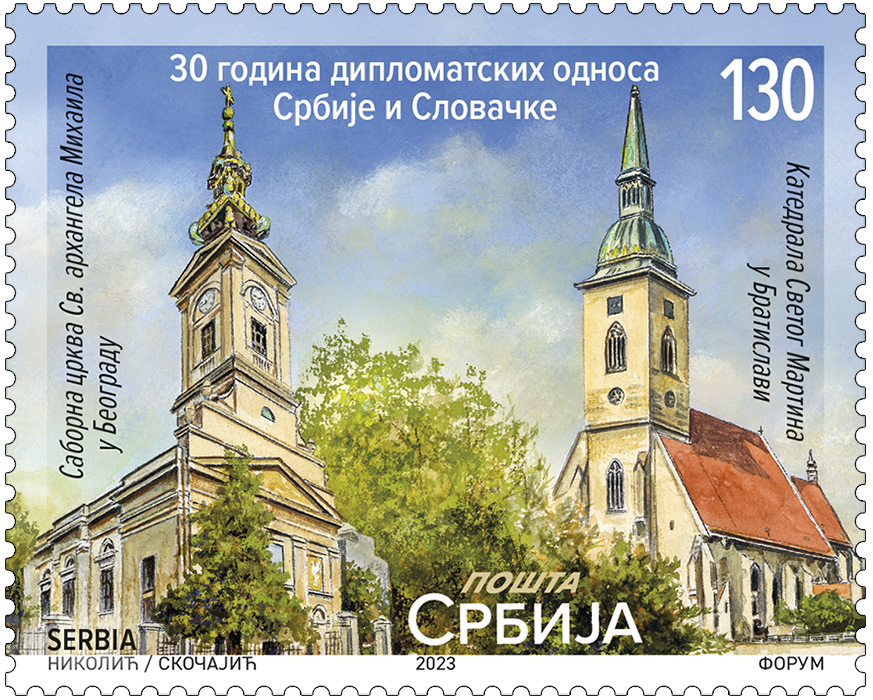

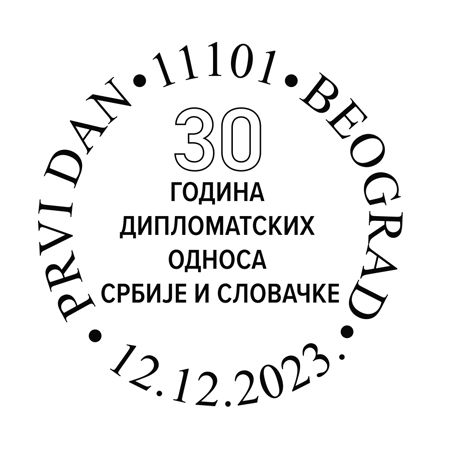
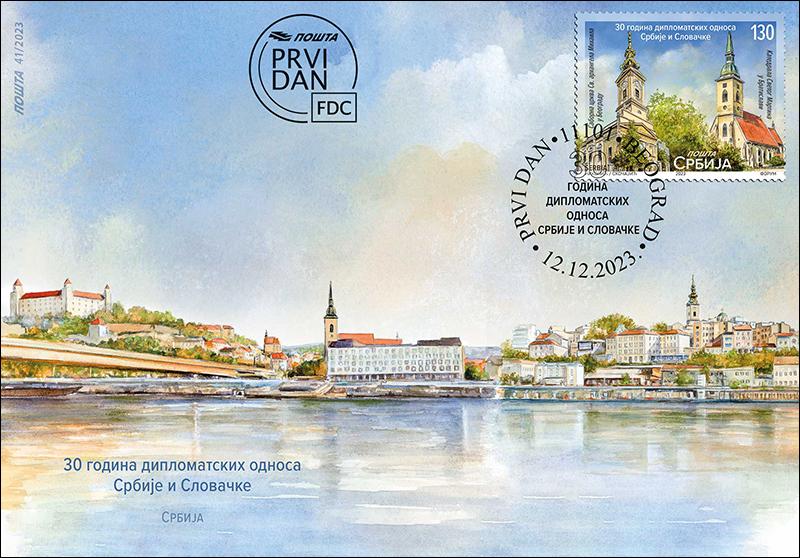
Diplomatic relations between Serbia and Slovakia were formally established thirty years ago on the foundations of constructive support that the two countries and two friendly peoples gave each other in the turning points of the historical struggle for freedom and independence during the 20th century.
Serbia and Slovakia are bound by traditionally good relations and closeness between the two peoples that go back to the past, during the 18th and 19th centuries, which was particularly manifested in the fields of culture, art, trade, education and science.
Over the past three decades, the two countries have achieved significant results in the fields of economic cooperation and economic exchange, but also in the fields of culture, education and science, remaining committed to the strengthening of friendly relations and achieving common goals – preserving peace, stability and prosperity in the region and beyond.
Expert collaboration: Embassy of the Slovak Republic in Belgrade
Artistic realization of the issue: Miroslav Nikolić and Nadežda Skočajić, Academic Graphic Artist
Каталошке информације
12. децембар 2023.
Artistic realization: Miroslav Nikolić and Nadežda Skočajić, Academic Graphic Artist
1275. 130,00 дин (вишебојна) 25.000
Табак: 8
На коверту са жигом ПД (FDC)
Нацрт: 1275. Саборна црква Св. архангела Михаила у Београду и Катедрала Светог Мартина у Братислави
Величина марака : 43,5 x 35 mm
World Art Greats
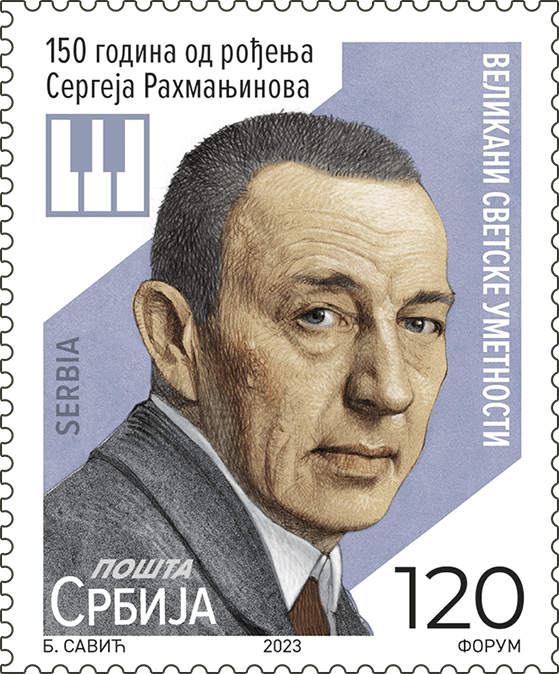

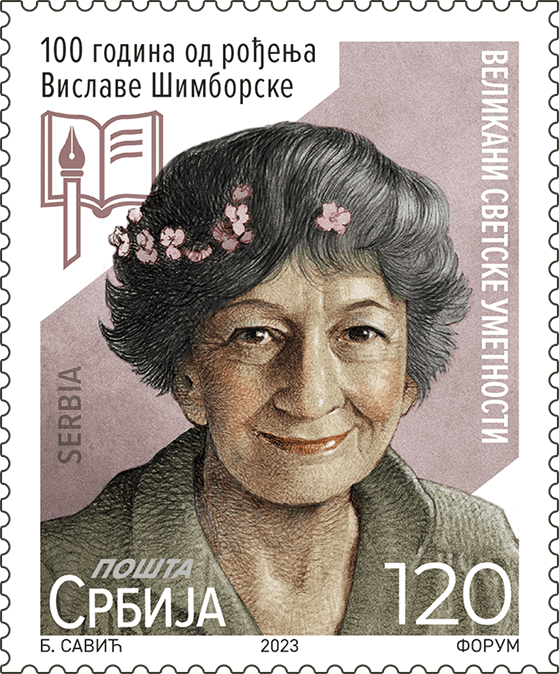
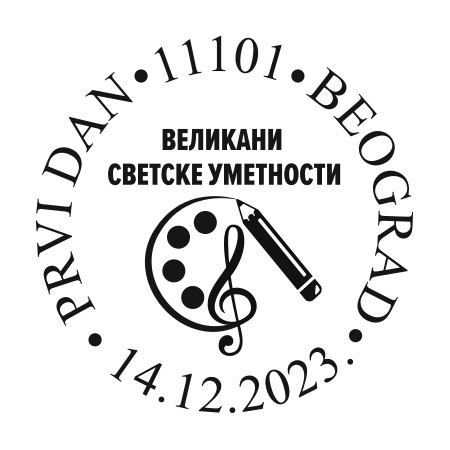
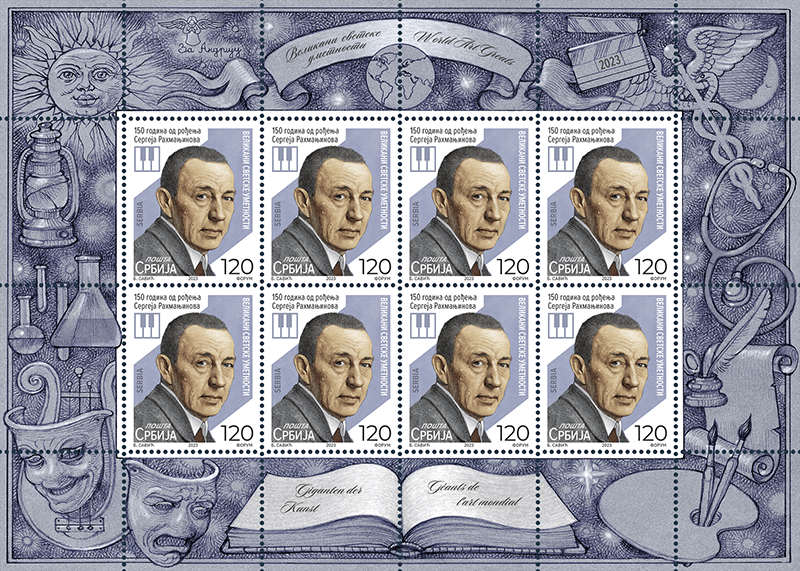
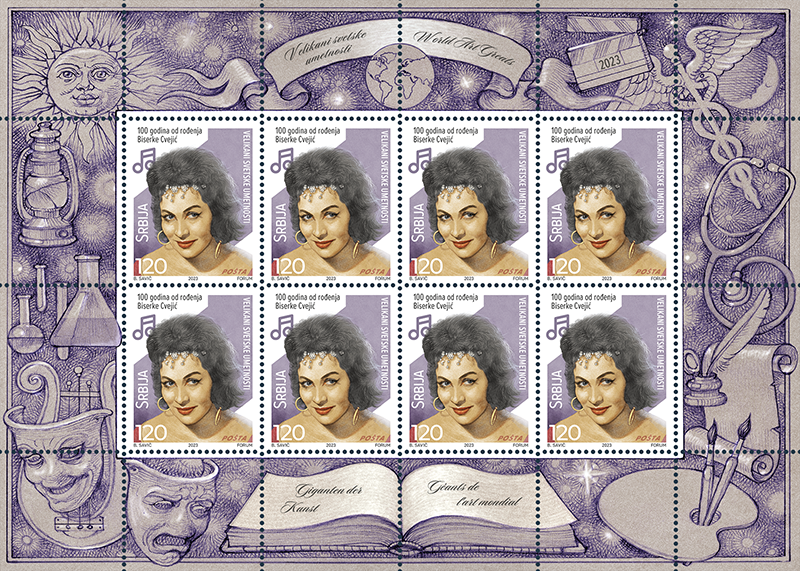
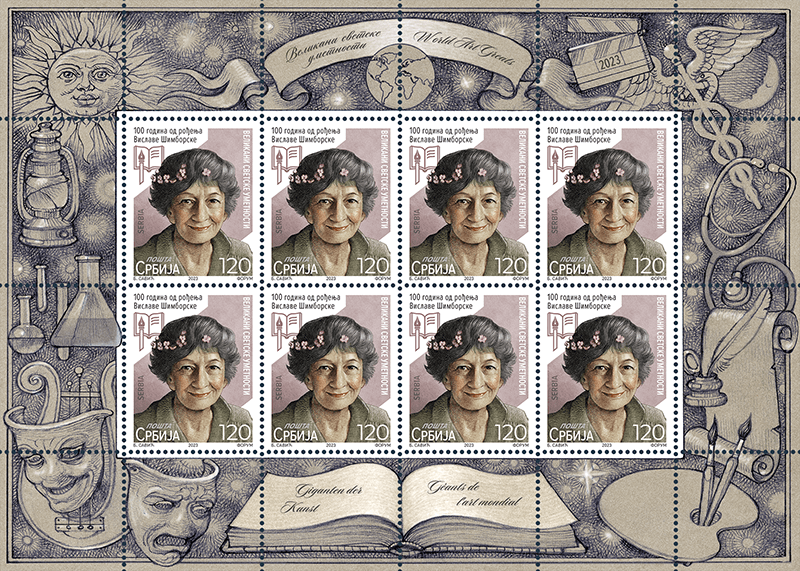
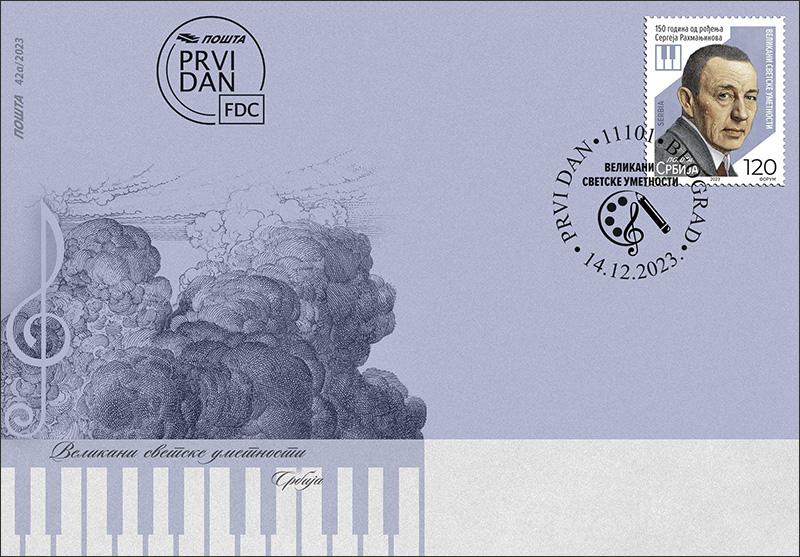
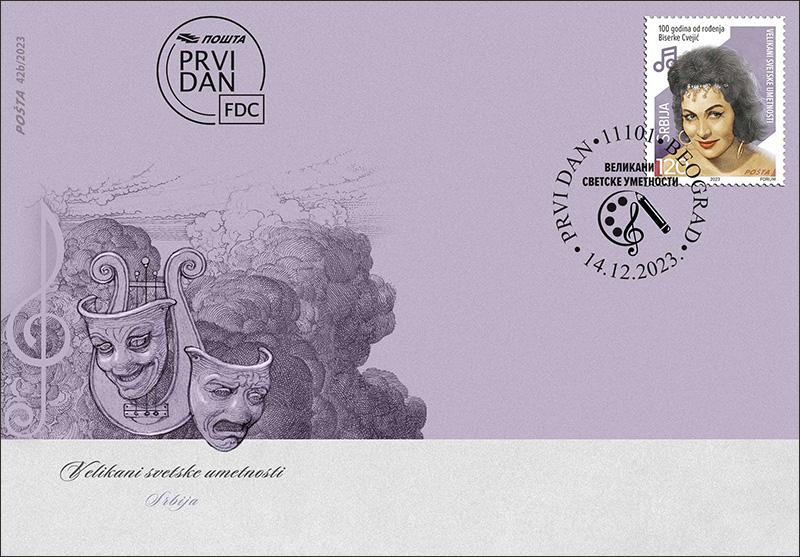

150 years since the birth of Sergei Rachmaninoff
Sergei Vasilyevich Rachmaninoff (Сергей Васильевич Рахманинов, Semyonovo, April 2, 1873 – Beverly Hills, March 28, 1943) was a Russian composer, pianist and conductor, who was a key representative of the romantic musical tradition and one of the most important composers of the 20th century.
Rachmaninoff gained fame and world recognition due to his virtuoso piano skills, fantastic sense of rhythm and legendary technical capabilities. In the opinion of many, he was the greatest pianist of the 20th century.
He started composing very early, already at the age of thirteen, at the age of nineteen he finished his Piano Concerto no. 1 (Op. 1, 1891), and his first symphony, Symphony no. 1 (Op. 13, 1896), he composed in 1896. He began his career as a conductor in 1904 at the Bolshoi Theater.
Sergei Rachmaninoff’s life encompassed challenging periods, including the turbulent events in Russia and the October Revolution. He moved from Russia in 1908, first to Italy, then to Germany and then to the United States, where he gained popularity after a very successful tour in 1909.
The rich author’s oeuvre of Sergei Rachmaninoff – among other things, four piano concertos, three symphonies, two piano sonatas, three operas and several choral works, is marked by deep emotional power, complexity and virtuosity in the best tradition of late romanticism, which is why his most famous works, including “Rhapsody on the Theme of Paganini” and “Second Concerto for Piano and Orchestra” are considered the pinnacle of romantic music.
Sergei Rachmaninoff’s musical work marked an entire era, and his overall artistic and performing work marked the music of the 20th century.
100 years since the birth of Biserka Cvejić
Biserka Cvejić (born Katušić; Krilo, November 5, 1923 – Belgrade, January 7, 2021) is one of the most significant and respected opera singers of our time. She left a permanent mark on the world of opera with her extraordinary talent, dedication to art and an impressive career that lasted for decades, during which she realized 77 mezzo-soprano roles in nearly 1,800 performances on stages around the world.
She began her professional career in the 1950s at the National Theater in Belgrade, quickly gaining a reputation for her powerful, emotional interpretation of roles. At the invitation of Herbert von Karajan, in 1961 she accepted an engagement at the Vienna Opera and worked with him until 1979.
Her singing skills were appreciated all over the world. She performed at the Milan Scala, the Metropolitan Opera, the Paris Opera and all major opera houses in the world.
At the height of her career, in 1978, she retired from the stage and devoted herself to the education of young singers, first as a professor of solo singing at the Faculty of Music in Belgrade, and later at the Academy of Arts in Novi Sad. With her husband Dušan Cvejić, she published the book “The Art of Singing”, and her extensive and notable pedagogical work, through which she passed on her knowledge and experience to generations of young artists, had a lasting impact on the development of the opera scene.
The ability to convey deep emotions through music and impressive vocal technique have made Biserka Cvejić a favorite among opera lovers and a role model for many young artists.
Biserka Cvejić is the holder of the highest French decoration, the order of the Legion of Honor and the lifetime achievement award “Dositej Obradović”. Her huge role in the popularization of opera in Serbia and the promotion of local talents contributed immeasurably to the cultural identity of our country. She passed away on January 7, 2021 in Belgrade.
100 years since the birth of Wisława Szymborska
Wisława Szymborska (Maria Wisława Anna Szymborska; Bnin, July 2, 1923 – Krakow, February 1, 2012), Polish poet, essayist and translator, winner of the Nobel Prize for Literature, is one of the most original and important contemporary Polish writers whose work is characterized by intelligence, deep introspection and imagination.
She started creating very early, even in her teenage years. She published her first collection of poems, “Dlatego żyjemy” (“That’s why we live”), in 1952.
Among her most significant works are the collections of poems “Wołanie do Yeti” (Cry of the Yeti, 1957), “Sól ziemi” (Salt of the Earth, 1962), “Wiersze wybrane” (Selected Songs, 1967), “Sto pociech” (One Hundred Consolations, 1967), “Czarny pasek” (Black Ribbon, 1976).
Through her verses, Szymborska explored the paradoxes of human existence, asking questions about the meaning of life, love and art. Deeply introspective, intellectually sharp and very skilled in wordplay and imaginative use of language, Szymborska wrote poetry rich in humor, which makes reading her poems a real pleasure.
She received the Nobel Prize for Literature in 1996, “for her poetic imagination that illuminates social reality with sarcasm.” Her works have been translated into almost all European languages, Arabic, Hebrew, Japanese and Chinese. Although her poetic oeuvre was not too extensive, the unique poetic expression with which she shrewdly illuminated the essence of human experience made Wisława Szymborska’s work leave a permanent mark on the Polish and world literary scene.
Expert collaboration: ”Svetozar Marković” University Library, Belgrade
Artistic realization of the issue: Boban Savić MA, academic painter
Graphic realization: MA Nadežda Skočajić, Academic Graphic Artist
Art
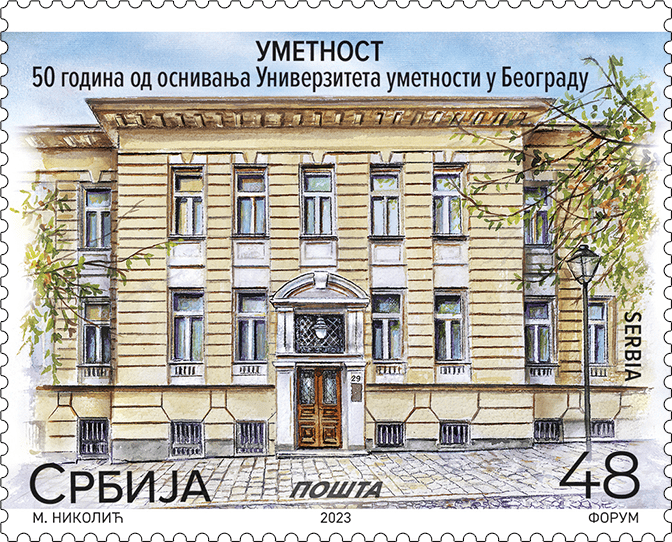
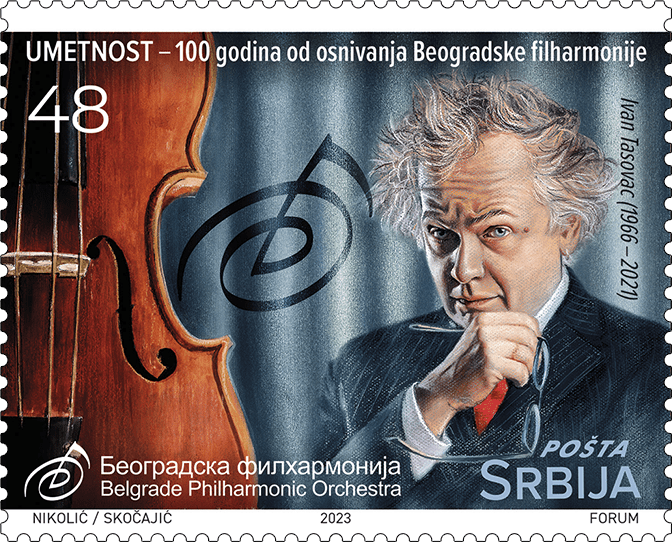

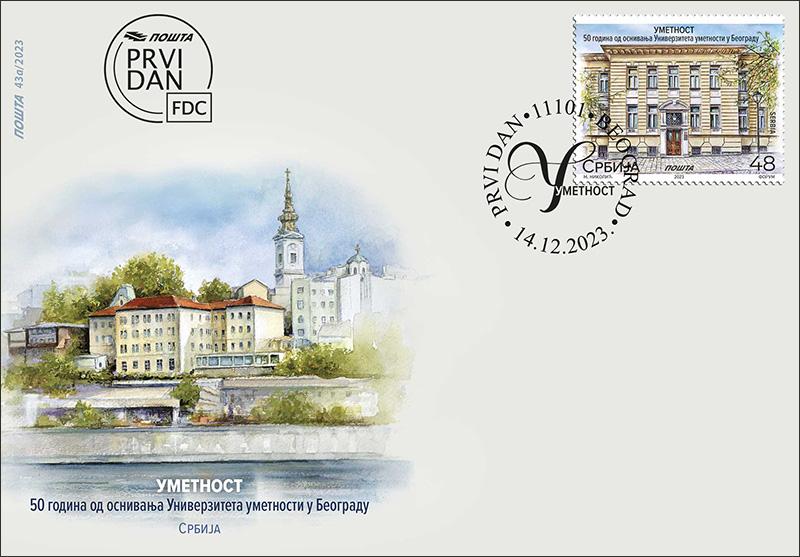
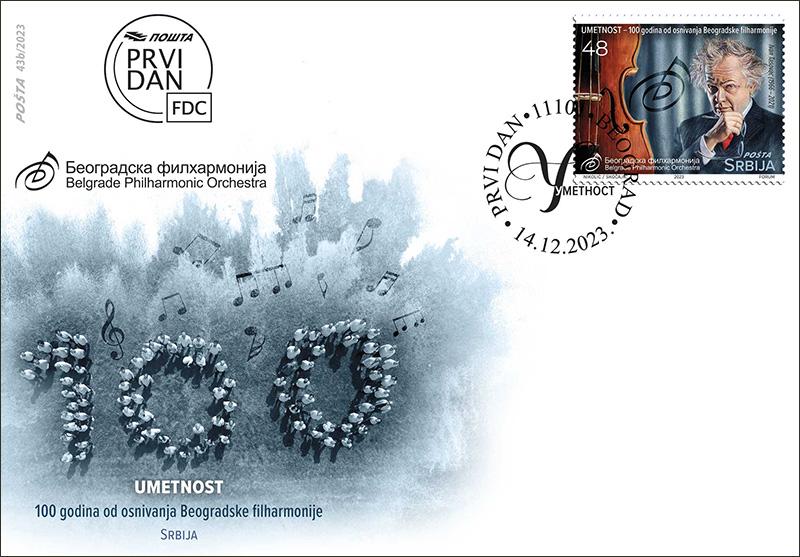
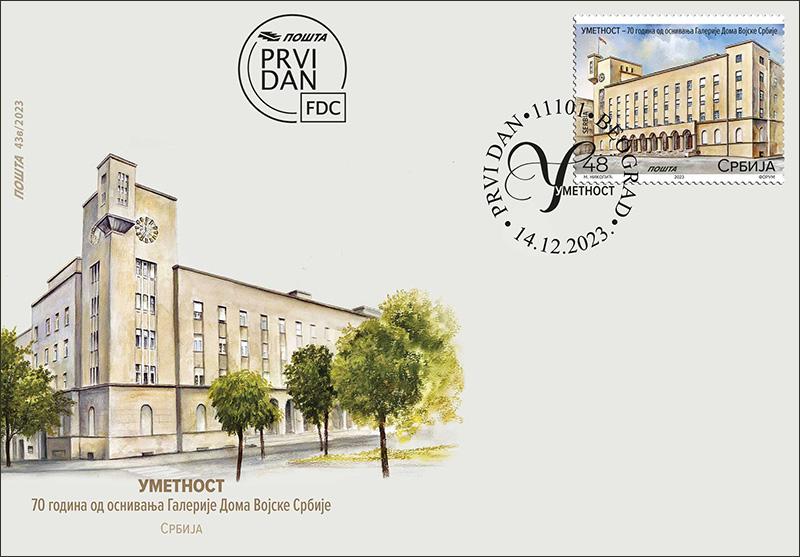
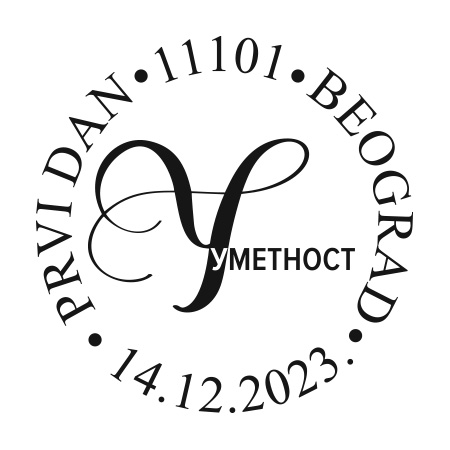
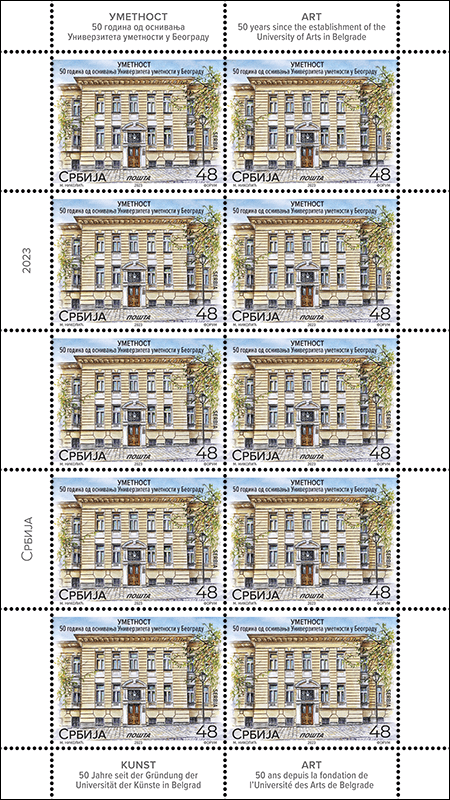

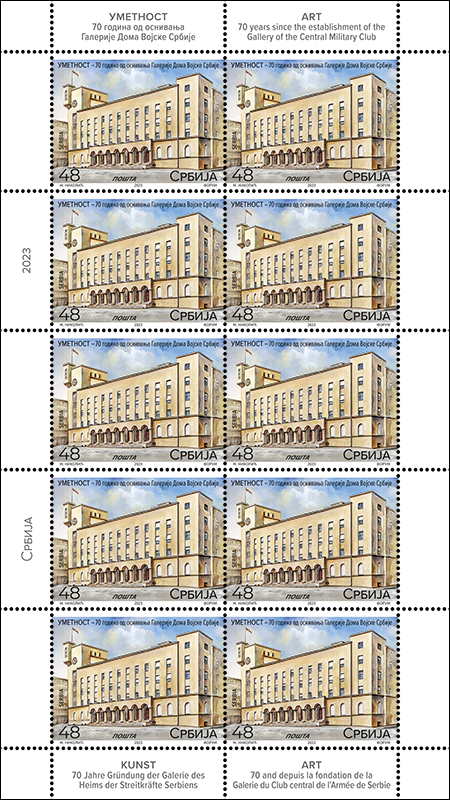
50 years since the establishment of the University of Arts in Belgrade
Association of Higher Art Schools – Academy of Music (founded in 1937), Academy of Fine Arts (founded in 1937), Academy of Applied Arts (founded in 1948) and Academy of Theater Arts (founded in 1948, into which the Higher School of Film Acting and Directing was integrated in 1950), was formed on June 10, 1957 as the Academy of Arts.
In 1973, the Academy of Arts grew into the University of Arts, which consists of four faculties: the Faculty of Fine Arts, the Faculty of Music, the Faculty of Applied Arts and Design, and the Faculty of Dramatic Arts.
Since its establishment, the University of Arts in Belgrade, as the leading institution for art education in Serbia and the region, has played a key role in shaping the art scene in Serbia and is one of the foundations on which Belgrade has built its reputation as a creative center and capital of culture.
Today, the University of Arts educates more than 2,800 students, through 37 accredited study programs and over 120 modules at the level of undergraduate, master’s and doctoral studies, in four faculties and the University’s Center for Interdisciplinary Studies, and is one of the few universities in Europe that has introduced artistic research into frameworks of doctoral studies.
During its five decades of existence, the University of the Arts has had an exceptional cultural impact by educating talented artists, musicians, actors, directors and other experts in various artistic disciplines, and its graduates have contributed to the richness of the cultural heritage of modern society, not only in our region, but also around the world.
Expert collaboration: ”Svetozar Marković” University Library, Belgrade
Artistic realization of the issue: Miroslav Nikolić
Graphic realization: MA Nadežda Skočajić, Academic Graphic Artist
100 years since the founding of the Belgrade Philharmonic Orchestra
One of the most important Serbian composers and conductors, Stevan Hristić (1885–1958), formed an orchestra from musicians of the National Theater Opera, teachers of Belgrade music schools and several amateurs, which, under the name of the Belgrade Philharmonic, held its first concert on June 13, 1923. Thanks to the enthusiasm of the founder, artistic director and chief conductor Stevan Hristić and his fellow musicians, the artistic musical journey of the Belgrade Philharmonic began in 1923, which has lasted for a century.
The 100-year long history of the Philharmonic consists of a diverse musical repertoire performed on stages all over the world, 620 musicians who have spent their working lives there since the archive has been continuously maintained (1951), 16 artistic directors, numerous guest conductors and musicians – the world’s most famous names in music art, but also enthusiastic audiences on all continents.
The Belgrade Philharmonic entered the new millennium under the leadership of Ivan Tasovac after several difficult years at the very end of the last century. Unique charm, specific character and undiminished enthusiasm have once again become the main characteristics of the Belgrade Philharmonic, which have returned this grandiose ensemble to the very top of the world’s orchestras and among one of the most successful cultural institutions in the country and region.
In addition to professional support and cooperation with the most important names of the international concert scene, the decades-long friendship with the legendary maestro Zubin Mehta, who regularly holds charity concerts with the Philharmonic, is especially valuable.
Breaking down prejudices, initiating cultural contacts, preserving old and creating new friendships, pushing boundaries in music and reaching new levels of excellence have created the Belgrade Philharmonic as a national brand and an orchestra for the concerts of which people wait in long lines for hours.
Expert collaboration: Belgrade Philharmonic
Artistic realization of the issue: Miroslav Nikolić and MA Nadežda Skočajić, academic graphic artist
70 years since the establishment of the Gallery of the Central Military Club
The Gallery of the Central Military Club is located in the monumental building of the palace of the former Military Home, today the Central Military Club. The initiative to establish the Gallery was initiated in 1945 by the well-known fine artist and founder of the Faculty of Applied Arts in Belgrade, Branko Šotra, the first post-war head of the institution.
Since the beginning of the Gallery’s work in 1953, numerous themed exhibitions of Yugoslav artists have been organized, dedicated to the revolution and the national liberation struggle, but artists have also organized independent exhibitions without thematic restrictions. This type of activity of the Gallery had a direct impact on the formation of the Art Collection, for which works were acquired through purchases, gifts, in exchange with institutions, and sometimes through the engagement of fine artists. As among the acquired works, there were equally works from both thematically engaged and independent exhibitions, the Art Collection of the Central Military Club became unique with this approach to collecting. This statement is supported by the wealth of the fund, which contains around 1,500 works of fine and applied art from all generations of artists from the former Yugoslavia.
The collection contains several significant works created in the first half of the 20th century, such as the works of Vlaho Bukovac, Ljuba Ivanović, Marino Tartalja, Sava Šumanović, Milo Milunović, Ljubo Babić, Kosta Hakman, and Jovan Bijelić. However, the largest part of the collection consists of works by Serbian and Yugoslav artists created in the second half of the 20th century, starting with Petar Lubarda, Zora Petrović, Milan Konjović, Krsto Hegedušić, Marko Čelebonović, Nikola Martinoski, Mića Popović, Ljubica Cuca Sokić, Sreten Stojanović and other greats of Yugoslav art.
Expert collaboration: Jelena Knežević, Senior Curator, Head of the Gallery of the Central Military Club
Artistic realization of the issue: Miroslav Nikolić
Graphic realization: MA Nadežda Skočajić, Academic Graphic Artist
Christmas
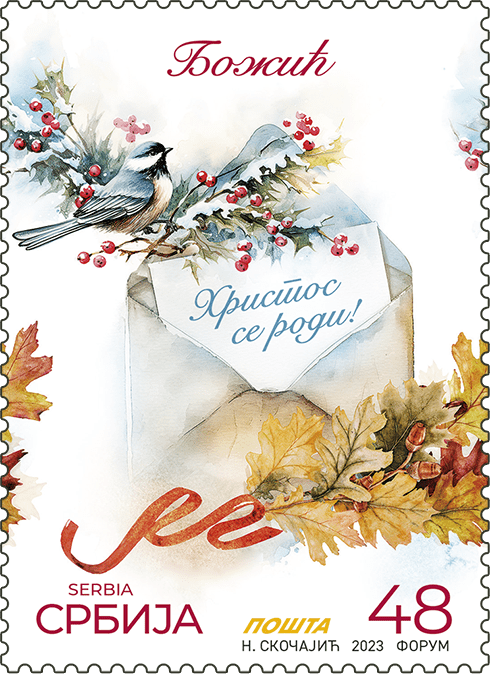
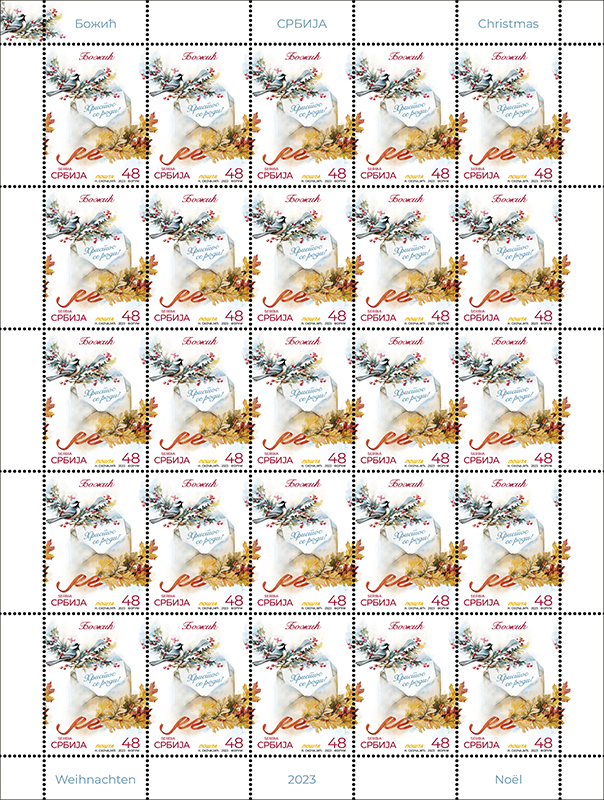
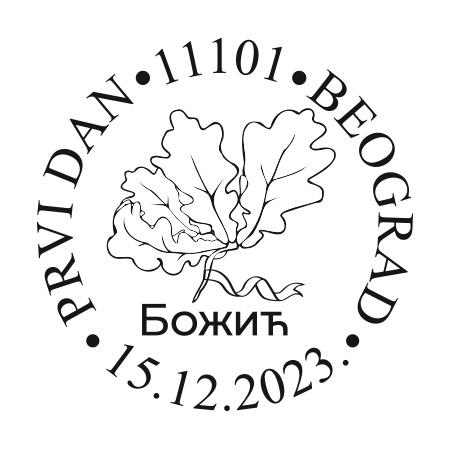
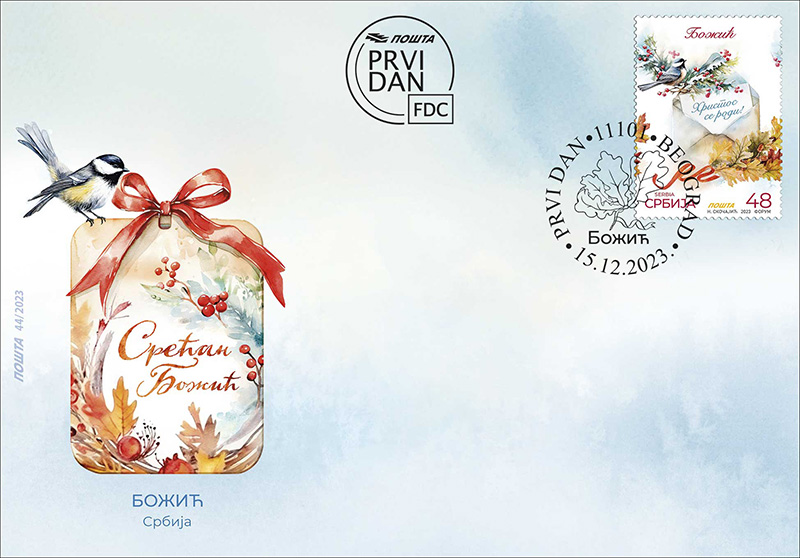
Christmas is one of the most important and one of the most joyous Christian holidays, that is celebrated both by the Orthodox and Catholic believers. The difference is only in the date of the celebration; the Orthodox celebrate it on January 7th, and the Catholic on December 25th, but its message remains the same – the message of peace and love. We celebrate Christmas for three days.
То је пре свега породични празник, а обичаји везани за њега су бројни. На дан уочи Божића, Бадњи дан, уноси се бадњак од храстовог дрвета у кућу, пали се кандило и простире слама у коју се стављају слаткиши, суве шљиве, ораси, шећер и новчићи. Слама симболизује јасле у којима је Исус рођен. Бадњак је симбол дуговечности и чврстине трајања хришћанства, као и топлине љубави коју нам Христос доноси својим рођењем и доласком на земљу. На сам дан Божића, рано ујутру, звоне звона на православним храмовима и објављују рођење Христово. Народ одлази у цркву на божићну литургију и сви се поздрављају речима „Христос се роди” и „Ваистину се роди”.
Artistic realization of the issue: MA Nadežda Skočajić, Academic Graphic Artist
Каталошке информације
15. децембар 2023.
Artistic realization: Nadežda Skočajić, Academic Graphic Artist
1282. 48,00 дин (вишебојна) 25.000
Табак: 25
На коверту са жигом ПД (FDC)
Нацрт: 1282. Божићна честитка, бадњак и празнични декоративни мотиви
Величина марака : 30,45 x 42 mm
PATRON SAINT’S DAY
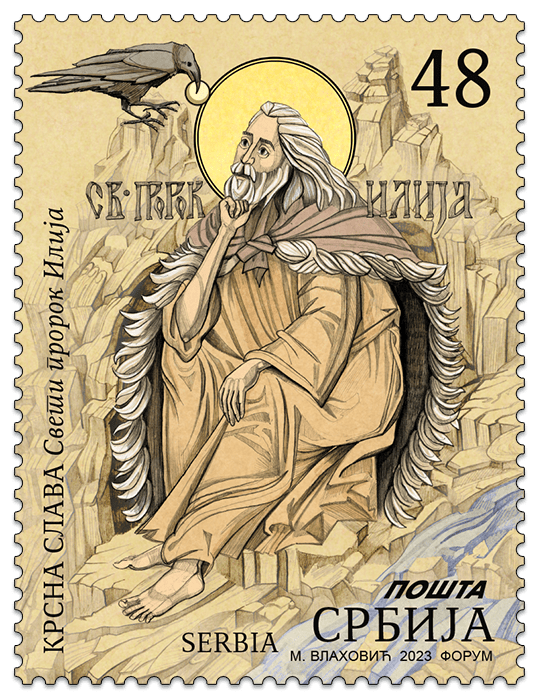


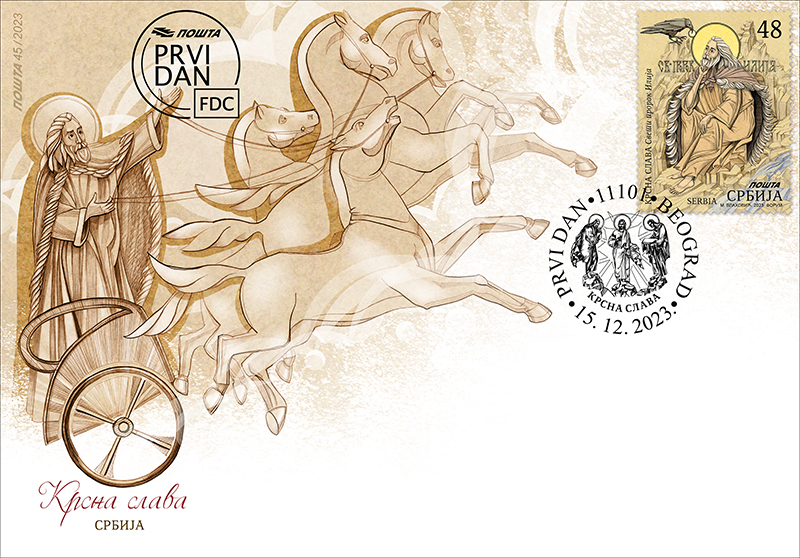
The Holy Prophet Elijah
Patron Saint’s Day (Slava) is a holiday dedicated to a Christian saint whom the family takes as its patron and protector. The celebration of the patron saint among Serbs dates back to the time of Saint Sava. Today, the majority of Orthodox believers in the territory of Serbia celebrate the Patron Saint’s Day as a significant holiday in which individual families and their guests participate – extended family members, spiritual relatives, neighbors and friends. As bearers of a unique Orthodox tradition, Serbs perceive Patron Saint’s Day as a way of expressing their Christian and national identity.
Slava is a vital element of the intangible cultural heritage of the Serbian people, and in 2014 it was inscribed on the UNESCO Representative List of the Intangible Cultural Heritage of Humanity.
The Old Testament prophet Elijah, the New Testament saint Saint Ilija, born in the 9th century BC is highly respected as a strict and unwavering preacher of ethical values and is one of the most celebrated saints in Orthodox Christianity. Holy Prophet Elijah, popularly known as Ilija the Thunderer, is commemorated on August 2. Characteristic for the commemoration of this saint is that a large number of customs and folk beliefs related to him originate from pre-Christian times, because Saint Elijah shares many characteristics with the Slavic god Perun, who controlled lightning and thunder.
Stamp motif: Old Testament prophet Elias as a hermit in front of a cave, wrapped in a fur cloak, with a raven bringing him bread, on the stream/Mount Horeb.
Envelope motif: The holy prophet Elijah ascends to heaven in a flaming chariot of bridled fiery horses, defeating death and thus being taken up to heaven alive.
Artistic realisation of the issue: MA Marija Vlahovic, academic graphic artist
Каталошке информације
15. децембар 2023.
Artistic realization: Nadežda Skočajić, Academic Graphic Artist
1283. 48,00 дин (вишебојна) 25.000
Sheet of: 10
На коверту са жигом ПД (FDC)
Нацрт: 1283. Свети пророк Илија са гавраном који му доноси хлеб
Величина марака : 30,45 x 42 mm
Culture of China
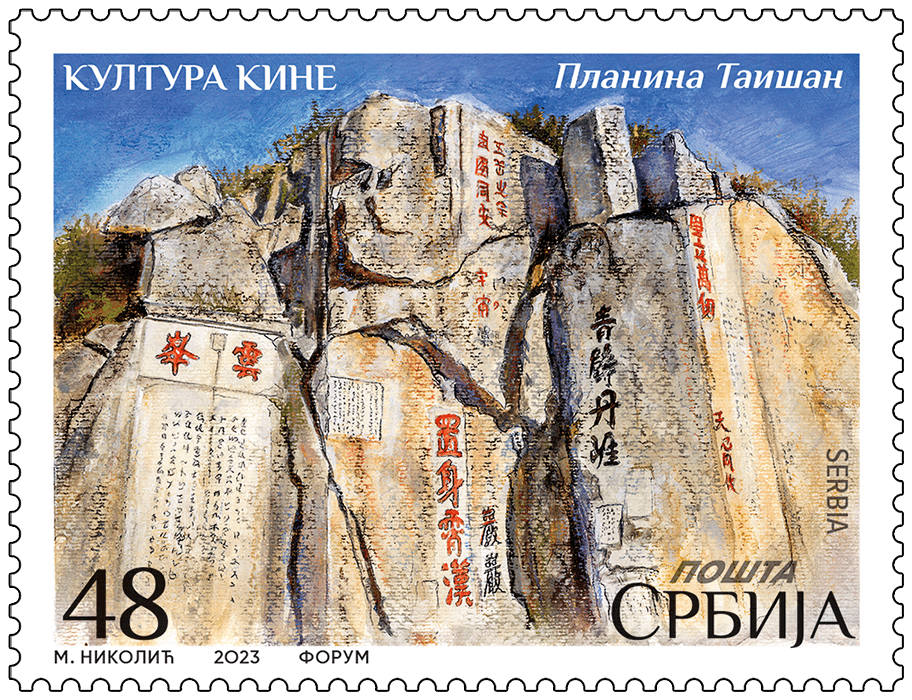
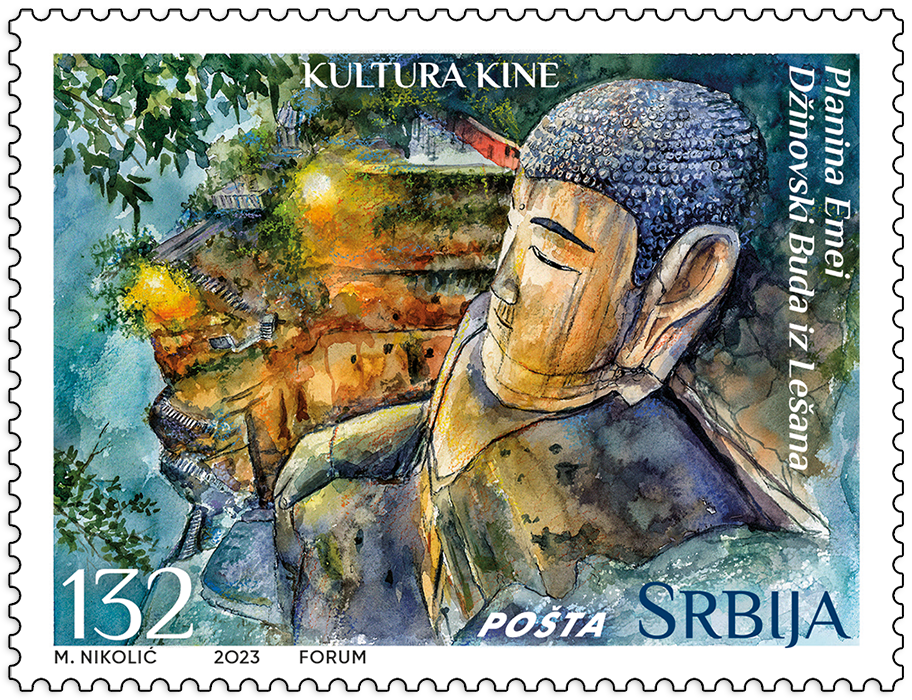
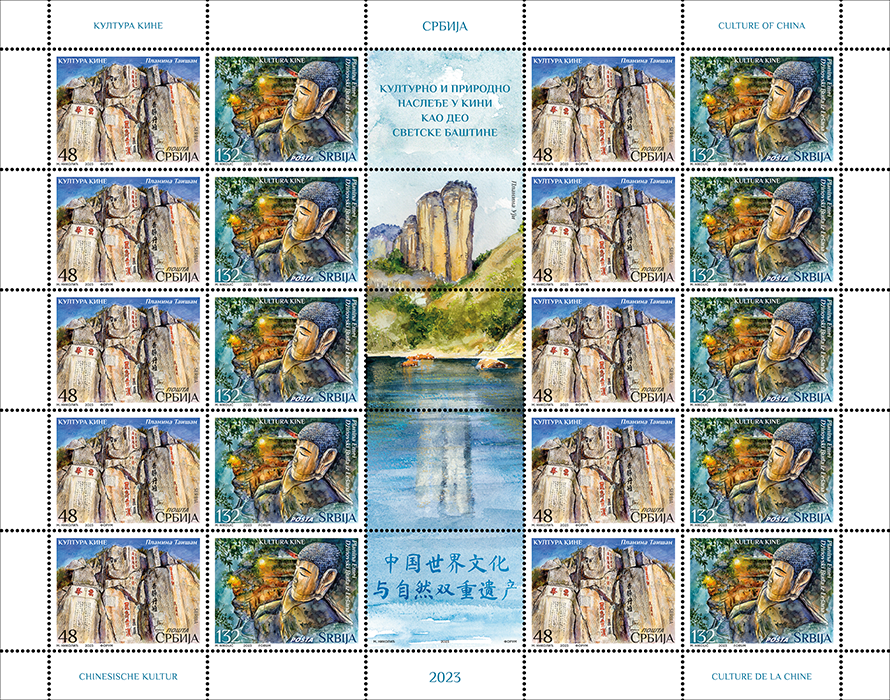
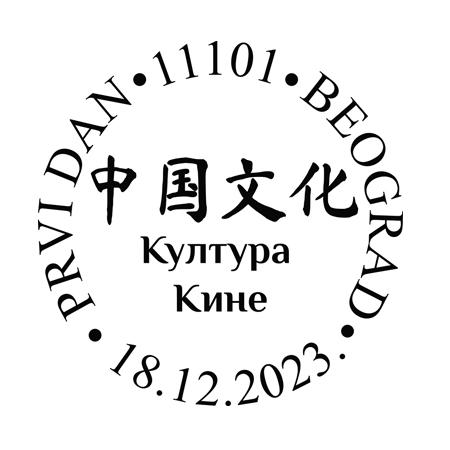
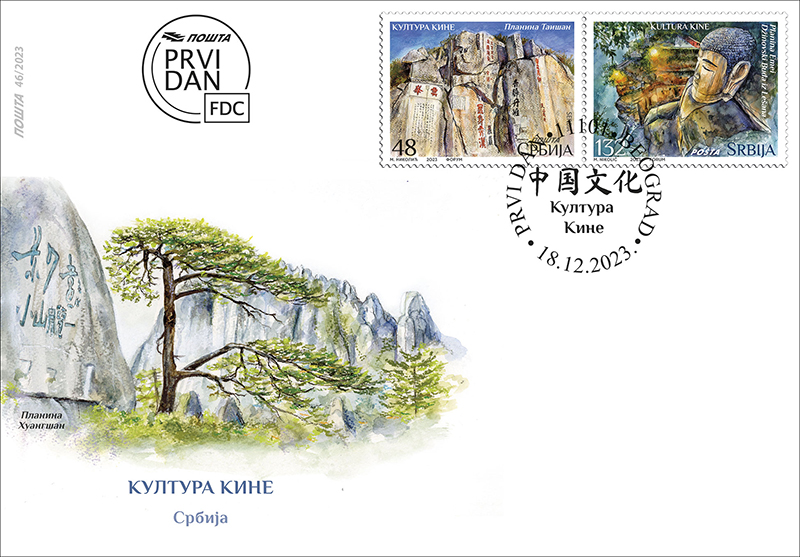
The culture of China, one of the most ancient civilizations in the world, is a significant part of the civilization heritage of humankind.
The strategic partnership between Serbia and China strengthens mutual understanding and friendship between the two peoples and enables exchanges and innovations in the art field, which enriches and contributes to the dialogue of civilization between East and West.
World Mixed Heritage contains elements of both natural and cultural significance for humanity, and these are those places on the planet that represent the perfect combination of the natural environment and the work of human hands.
Mount Taishan is the head of China’s five greatest mountains. It is the symbol of the nation’s survival and prosperity and the spiritual home of the Chinese nation.
Mount Huangshan is praised as “The Most Extraordinary Mountain on Earth” and “The Ocean of the Pines and the River of the Clouds”.
Mount Emei has a history of more than 2,000 years and is praised as “The Wonderland on Earth”.
Mount Wuyi is a famous mountain for three religions, rich in endemic flora and fauna.
These four “Renowned Mountains of China” have been on the UNESCO World Heritage List since 1987, 1990, 1996, and 1999 respectively.
Expert collaboration: China Cultural Center in Belgrade
Artistic realization: Miroslav Nikolić and Nadežda Skočajić, academic graphic artist
Каталошке информације
18. децембар 2023.
Artistic realization: Miroslav Nikolić and Nadežda Skočajić, academic graphic artist
1284. 48,00 дин (вишебојна) 25.000 1285. 132,00 дин (вишебојна) 25.000
Табак: 20
На коверту са жигом ПД (FDC)
Нацрт: 1284. Планина Таишан Нацрт: 1285. Планина Емеи; Џиновски буда из Лешана
Величина марака : 42 x 31,9 mm
Prominent Serbs

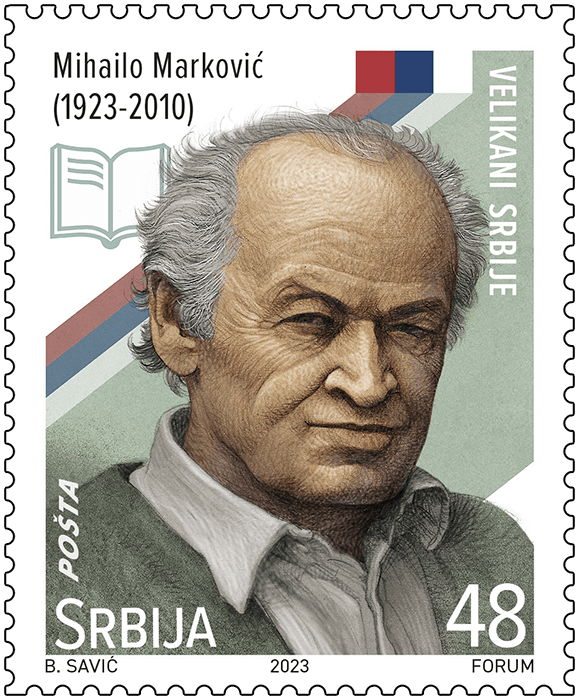
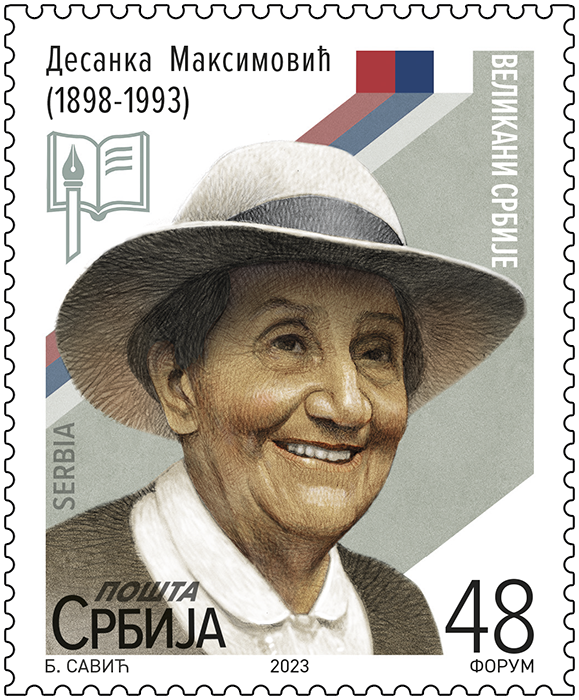
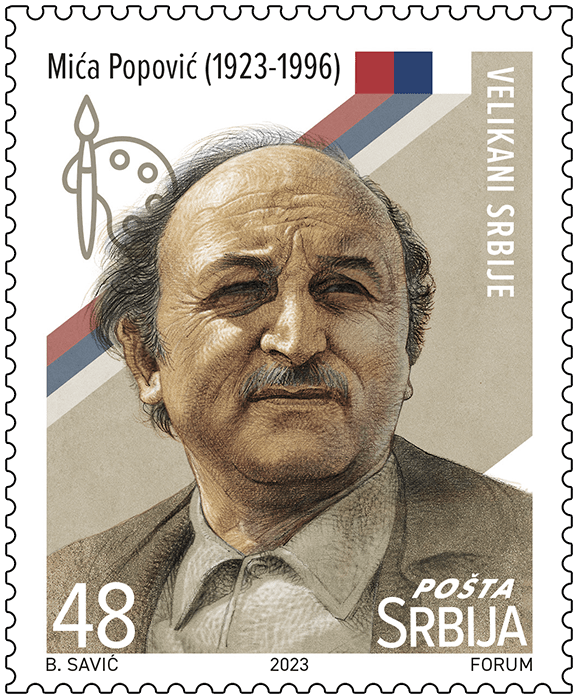
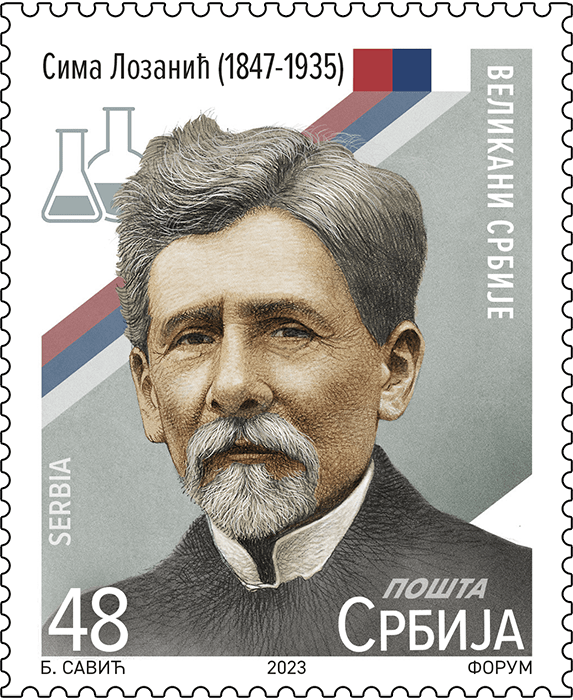
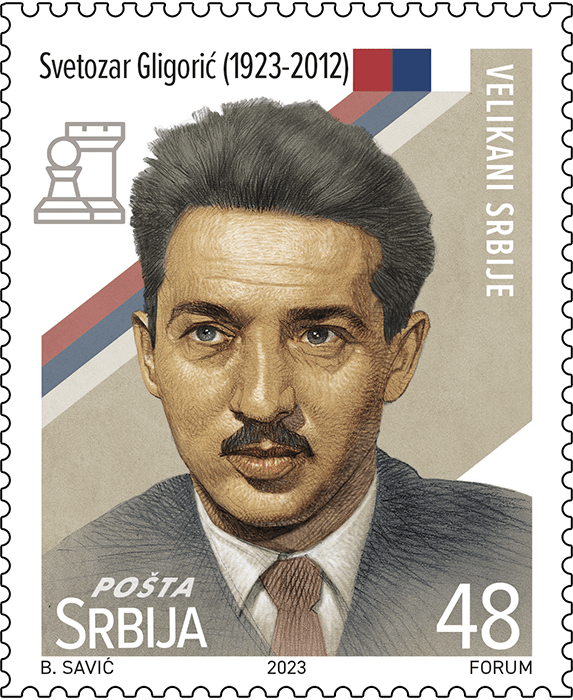

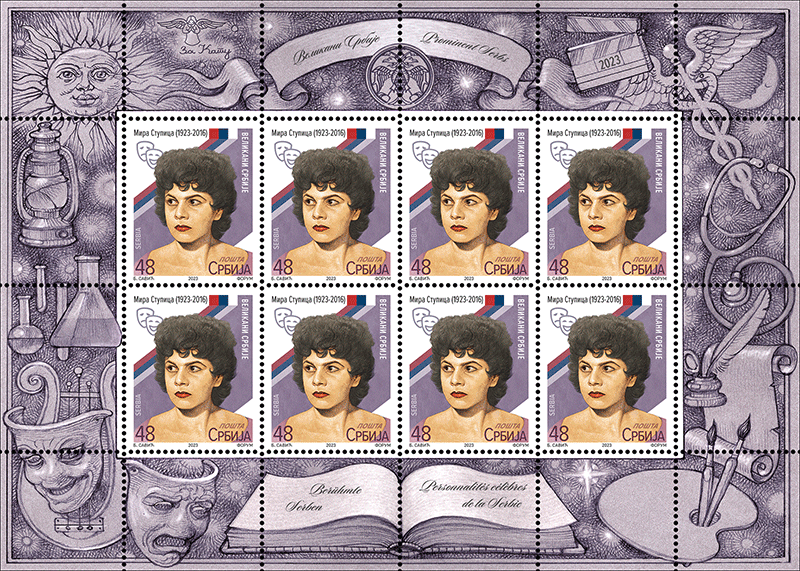
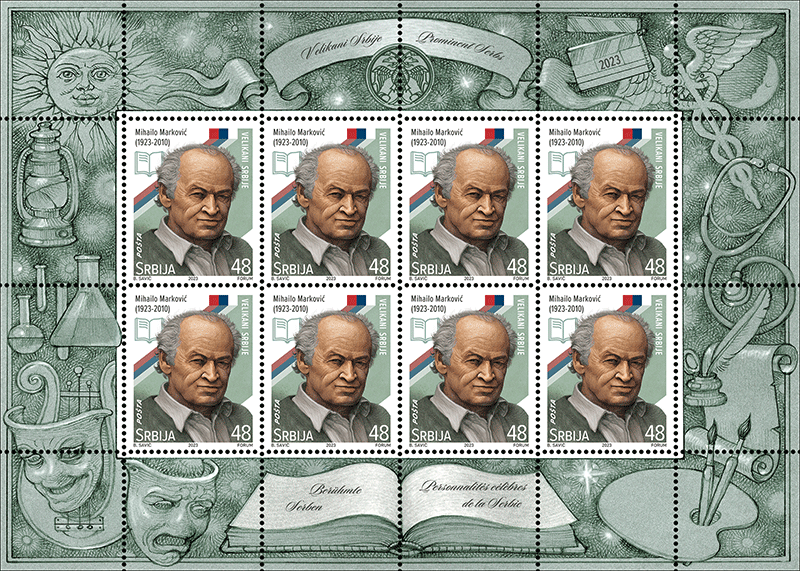
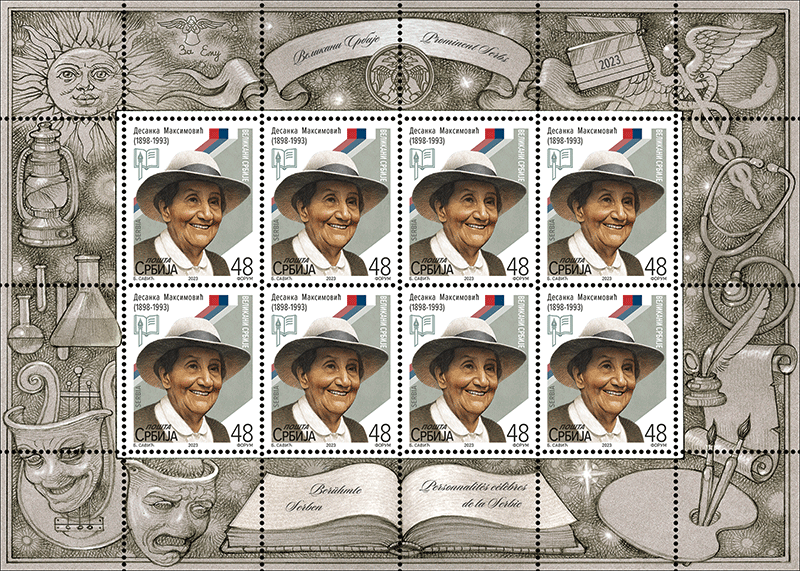
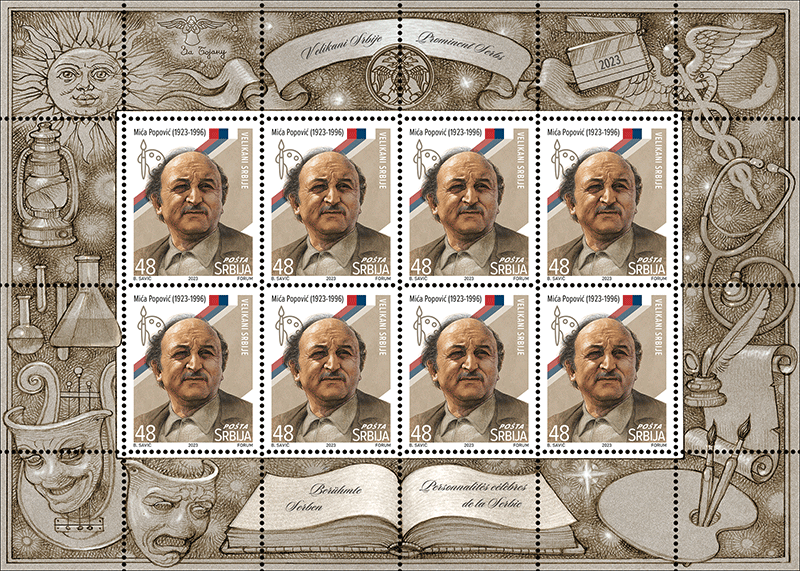
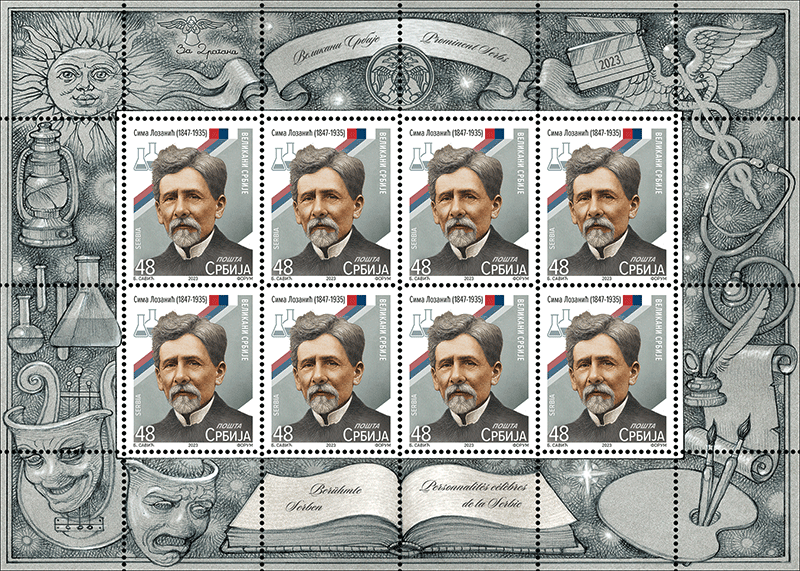
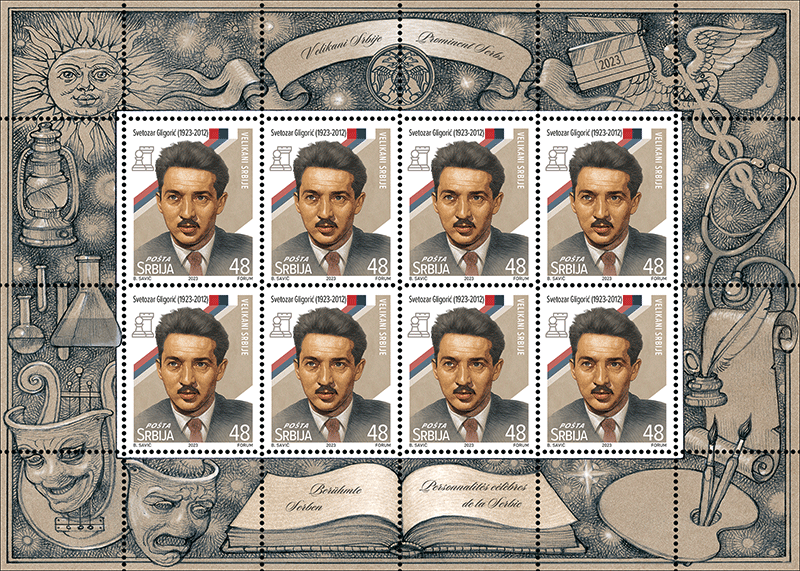
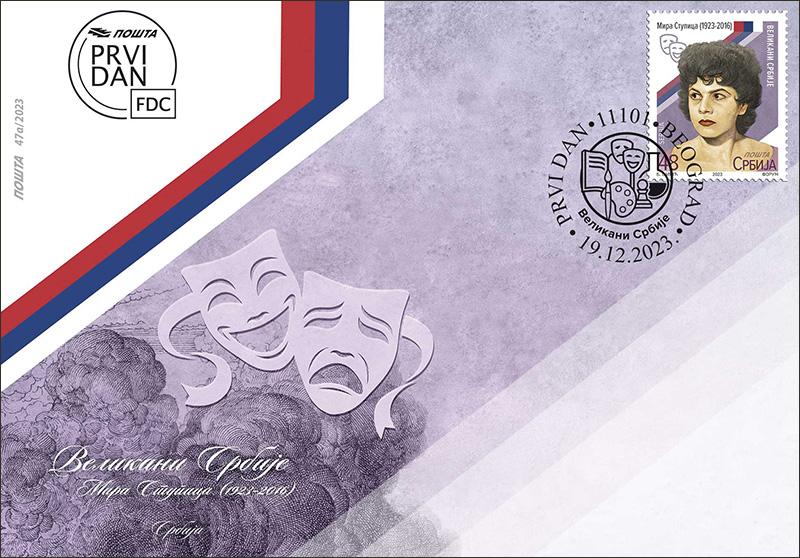
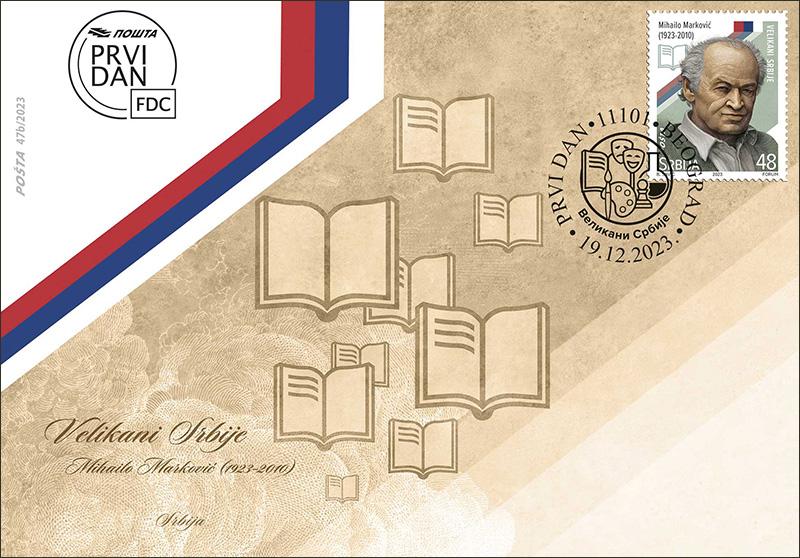
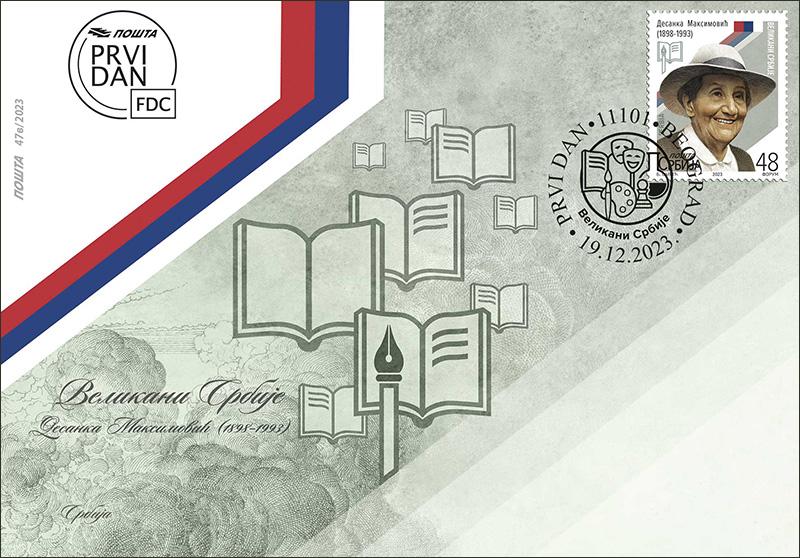
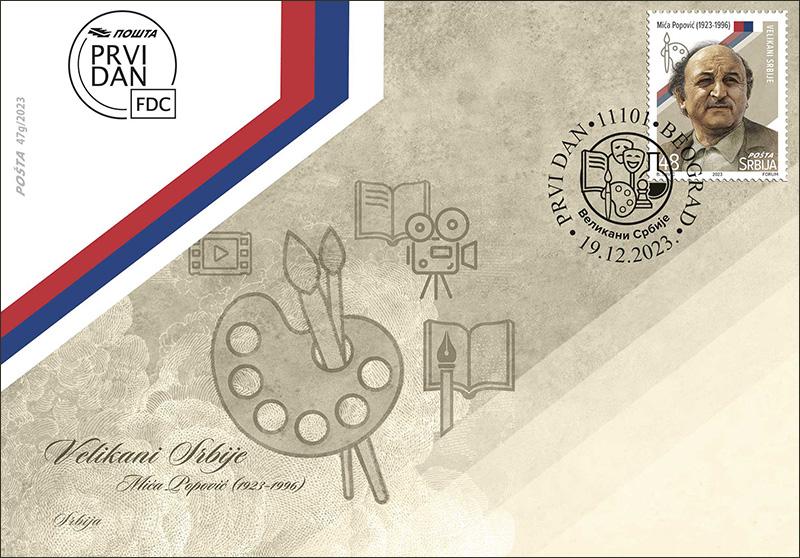
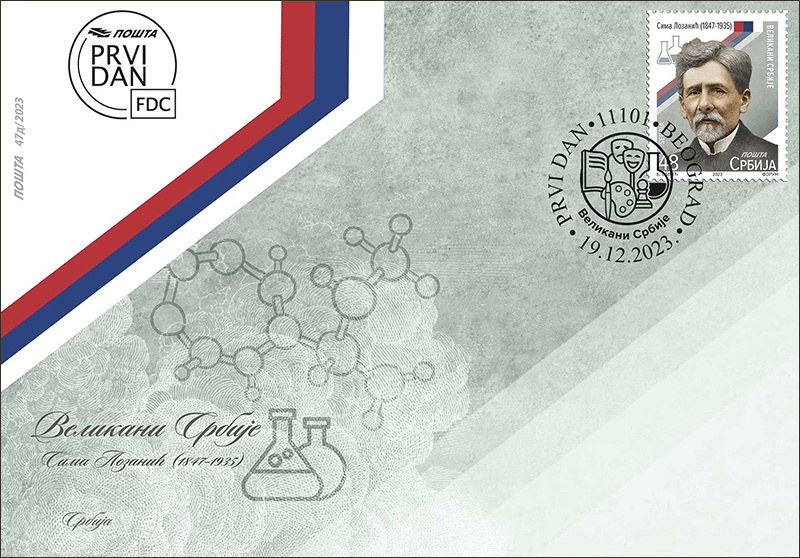
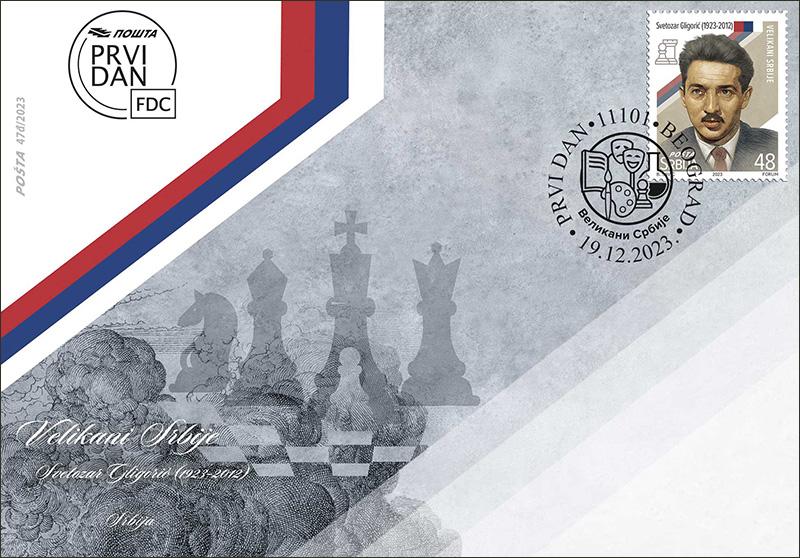
Mira Stupica
Miroslava Mira Stupica (Gnjilane, August 17, 1923 – Belgrade, August 19, 2016) was, according to many, the greatest Serbian actress, along with Milena Dravić, declared the actress of the 20th century. With the director and husband, the great Bojan Stupica, she built both the foundations and the peaks, not only of the theatrical life of these areas, but also of culture in the broadest and most complete sense of the word. Cheerful, energetic, most of all charming, and charismatic. Her laughter, as was told, tore even the stars apart. Talent too. And wisdom as well.
She played Petrunella, Mirandolina, Baroness Castelli, Gloria, Nastasya Filippovna, Sasha Negina, Grushenka, Madame Sans-Gêne, Princess Xenia, the greatest titles of domestic and international, classical and contemporary literature. At the guest performances of Dundo Maroje and Yegor Bulychov in Paris, the hosts, seeing what kind of actress she was, gave her Sarah Bernard's wardrobe, which only special ones have access to.
She is the winner of all the most important theater and film awards and recognitions. She was awarded the White Angel Medal "for exceptional personal achievement in the field of art." She published a book of memoirs, A Handful of Salt, in 2000. She snatched the actress Žanka Stokić from oblivion and, establishing an award with her name, brought her back to the stage of the National Theater and into the collective memory. She died in Belgrade on August 19, 2016.
Mihailo Marković
Mihailo Marković (Belgrade, February 24, 1923 – Belgrade, February 7, 2010) was the most significant Serbian philosopher of the 20th century. He was born in Belgrade where, in the beginning of the war, in 1941, he graduated from the Second Belgrade Gymnasium. He fought during the occupation on the side of the Partisans, and left the war with the rank of Captain of the YNA.
He graduated from the Faculty of Philosophy in 1950. He obtained the title of lecturer in the subject Logic in 1953. He received his doctorate in 1955 in Belgrade with the subject Formalism in Contemporary Logic, and in London in 1956 with the subject The Concept of Logic. He was elected an Assistant Professor at the Faculty of Philosophy in 1956, an Associate Professor in 1958, and obtained the title of Full Professor in 1963.
He was Dean of the Faculty of Philosophy in 1966/67. and Head of the Department for Logic and Methodology from 1962 to 1975. He was the Director of the Institute of Philosophy at the Faculty of Philosophy in Belgrade from 1967 to 1975. Due to his political views, he was suspended from the Faculty in 1975 and fired in 1981. After that, until his retirement in 1986, he was a scientific advisor at the Center for Philosophy and Social Theory of the Institute of Social Sciences in Belgrade. He was one of the founders of the Institute for Philosophy and Social Theory at the University of Belgrade. He was elected a corresponding member of the Serbian Academy of Sciences and Arts (SASA) in 1963, and a full member in 1983.
He published several works in the field of philosophy, some of which, such as Dialectical Theory of Meaning (1961) and Philosophical Foundations of Science (1981), belong to the world's philosophical heritage. He collaborated on the largest world encyclopedia of philosophy published by the McMillan publishing house from New York in 1969, as one of the most important Serbian philosophers and logicians of the 20th century with a Marxist-Humanist orientation. On several occasions, he was a visiting Professor of Philosophy at eminent universities in the United States of America. He died in Belgrade on February 7, 2010.
Desanka Maksimović
Desanka Maksimović (Rabrovica near Valjevo, May 16, 1898 – Belgrade, February 11, 1993) was a prominent Serbian poet, prose writer and essayist whose work covers various themes, which have lyrical and emotional expressiveness in common.
A poet, professor of literature and member of the Serbian Academy of Sciences and Arts, Desanka was engaged in poetry, storytelling, writing for children, and occasionally translating, mostly poetry, from Russian, Slovenian, Bulgarian and French.
Desanka's poetry often explores the themes of love, suffering, the passage of time, but also patriotic feelings, and her works reflect deep emotionality and introspection, while at the same time showing the subtle beauty of words. "Prayer for love", "There is a poem", "Tremble", "Bloody fairy tale", are just some of the most frequently spoken verses of Desanka Maksimović, which even today, 125 years after the birth of the famous poetess, have their devotees and loyal readers. Apart from poetry, Desanka Maksimović was also the author of several prose works, and her work "Manuscript of Father Sava" is a deeply emotional work that explores the theme of faith and moral dilemmas.
Desanka Maksimović received a large number of literary awards, among them Vuk (1974), Njegoš (1984), AVNOJ (AFCNLY) Award (1970), Seventh of July Award (1964), Zmaj Award (1958 and 1973), etc. She was also chosen for an honorary citizen of Valjevo, where a monument was erected to her during her lifetime, which was unveiled on October 27, 1990.
She died in Belgrade on February 11, 1993.
Mića Popović
Miodrag Mića Popović (Loznica, June 12, 1923 – Belgrade, December 22, 1996) was a Serbian painter and art critic. He was also involved in writing as well as film directing. He completed his elementary and secondary education in Belgrade. He participated in the final battles of the Second World War on the territory of Yugoslavia, and after demobilization, he enrolled the Academy of Fine Arts in the class of Professor Ivan Tabaković in 1946. With a group of like-minded colleagues, he left the Academy and went to Zadar in 1947, where they formed the first artistic commune in post-war Yugoslavia.
In terms of painting, he went through several phases, the most famous of which are "art informel" and "scene painting". The central place of Mića Popović's entire painting oeuvre, viewed retrospectively, in all phases, was the fateful feeling of the tragedy of existence – both individual and collective.
During his life, he had more than 20 solo exhibitions in Yugoslavia and Europe. He published dozens of essays, studies and reviews, directed seven feature films and wrote five screenplays. As a screenwriter and costume designer, he participated in ten plays in Belgrade theatres and theaters in Niš and Skopje.
He was elected a corresponding member of the Serbian Academy of Sciences and Arts in 1978, and a regular member in 1985. He died in Belgrade in 1996, leaving behind a memorial gallery, a legacy in Loznica.
Sima Lozanić
In 2023, the Serbian Academy of Sciences and Arts celebrates the Year of Academician Sima Lozanić (Belgrade, March 8, 1847 – Belgrade, July 7, 1935), one of our most important chemists, a distinguished politician and diplomat. He was a Professor and Rector of The Higher School, the first Rector in the history of the University of Belgrade, President of the Serbian Royal Academy, MP in London, Minister of National Economy and Foreign Affairs.
He completed his law studies at The Higher School in Belgrade (1868), and then spent the next four years studying chemistry in Zurich and Berlin. As a Professor at The Higher School and University in Belgrade, he opened Serbia's path to modern chemistry by introducing classes in several subjects of chemical sciences, he wrote programs and textbooks for them based on the most modern knowledge of science at the time. Through teaching programs, textbooks and other activities, he founded modern chemical terminology in Serbian science. When the University of Belgrade was founded in 1905, he was among the first eight full professors who then selected other university teachers.
During his scientific career, he published more than two hundred scientific publications. He is one of the founders of the Faculty of Agriculture, and as a prominent member of the then scientific community, he participated in the work of a large number of domestic and international scientific societies. His contribution to the discovery of Serbia's natural resources is also of great importance. In addition to intensive and fruitful scientific work, he was also involved in the analysis of soil, ores and minerals, as well as mineral and drinking water.
As a chemist, he left a permanent mark on our and world science, and with his pedagogical and political work, he made an immeasurable contribution to the development of Serbian education, economy and industry.
Svetozar Gligorić
Svetozar Gligorić (Belgrade, February 2, 1923 – Belgrade, August 14, 2012) Serbian chess grandmaster, journalist and publicist, started playing chess relatively late, at the age of 13. Just two years later, in 1938, he won the competition of the Belgrade Chess Club. Young Gligorić spent the war in the partisans, and after demobilization he returned to his pre-war love – chess, as an organizer of chess competitions. Working as a journalist, he devoted himself intensively to the revival of the chess organization in post-war Yugoslavia.
He played most of his career in CC Partizan, but due to circumstances he was one of the founders of the Red Star Sports Association. He won his first tournament at the championship of Yugoslavia, in 1947 and in the same year he won his first international tournament in Warsaw. He received the title of grandmaster in 1951. For the next 20 years, he was among the world's best chess players and a candidate for world champion. Thanks to him, Yugoslavia was considered the second chess superpower in the world, after the USSR. He won numerous international tournaments, the most important of which were the tournament in Warsaw (1947), Hastings (1951, 1956, 1959, 1961), Mar del Plata (1953), Stockholm (1954), Belgrade (1964) and Manila (1968), as well as the tournament in Lone Pine (1972 and 1979). Three times at international tournaments, he qualified for candidate matches in the world championship cycle. In the period from 1950 to 1982, he represented Yugoslavia 15 times at the Olympics, winning 12 medals (one gold, 6 silver and 5 bronze). He was a 12-time winner of first place at the championship of Yugoslavia.
Gligorić is also known for his journalistic career. He was a regular correspondent for Chess Review and Chess Life, and wrote a number of books on chess. The award-winning short documentary "Gligorić's Mar del Plata – The King's Indian Variant" was filmed about him. He died in Belgrade on August 14, 2012 at the age of 89.
Expert collaboration: ”Svetozar Marković” University Library, Belgrade
Artistic realization of the issue: Boban Savić MA, academic painter
Friends of Serbia
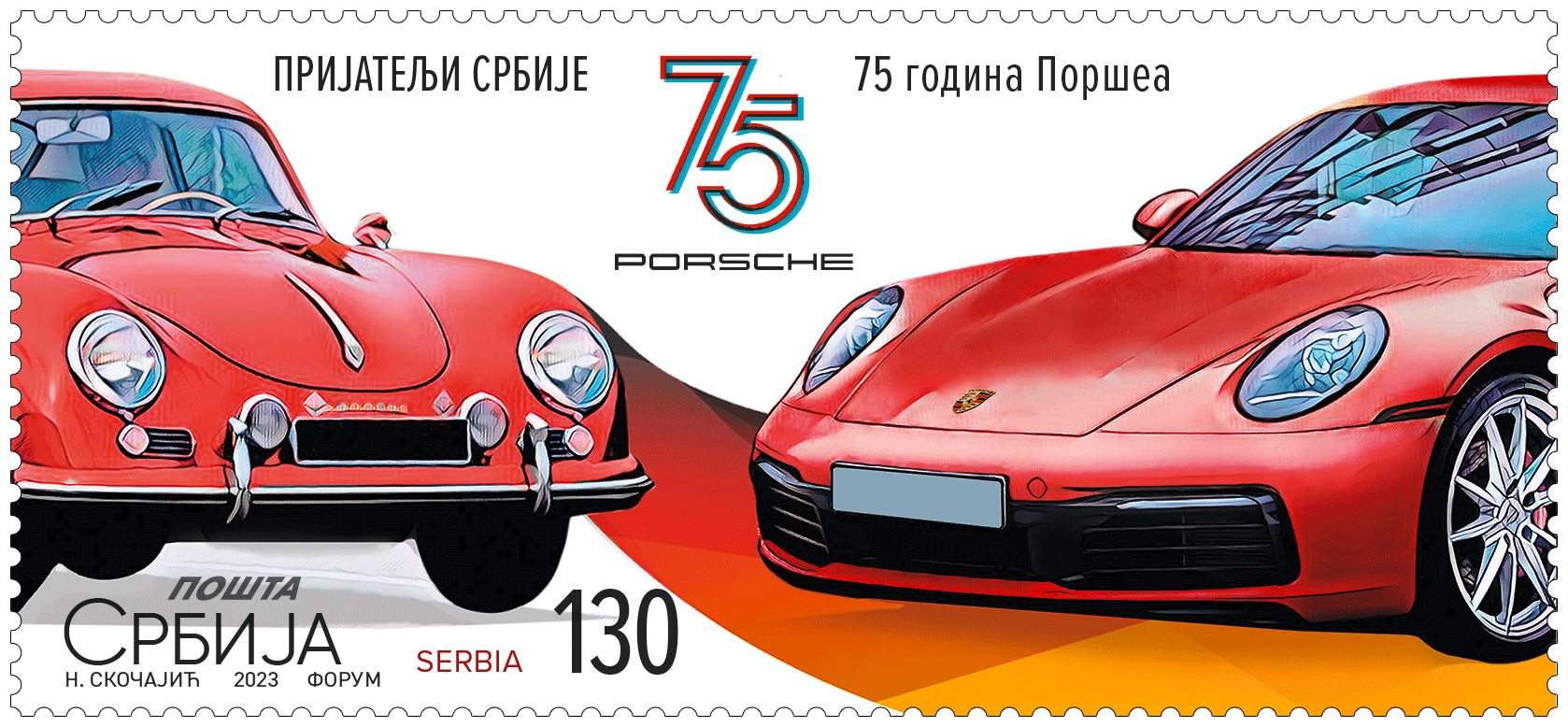
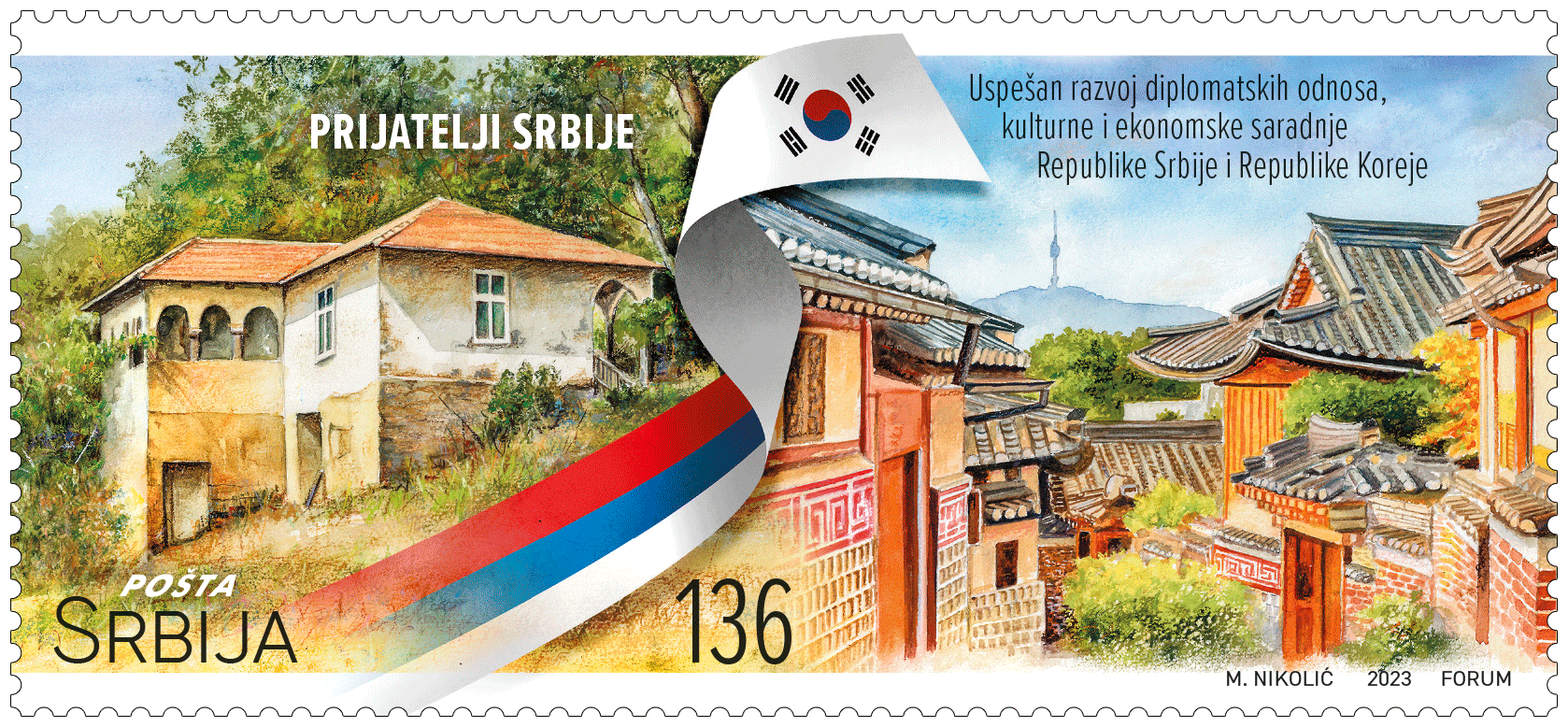
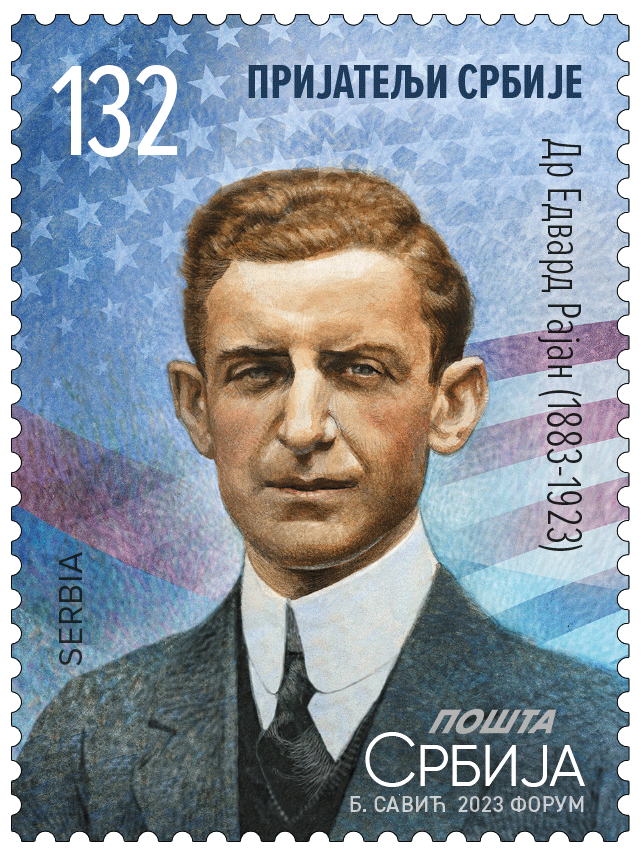
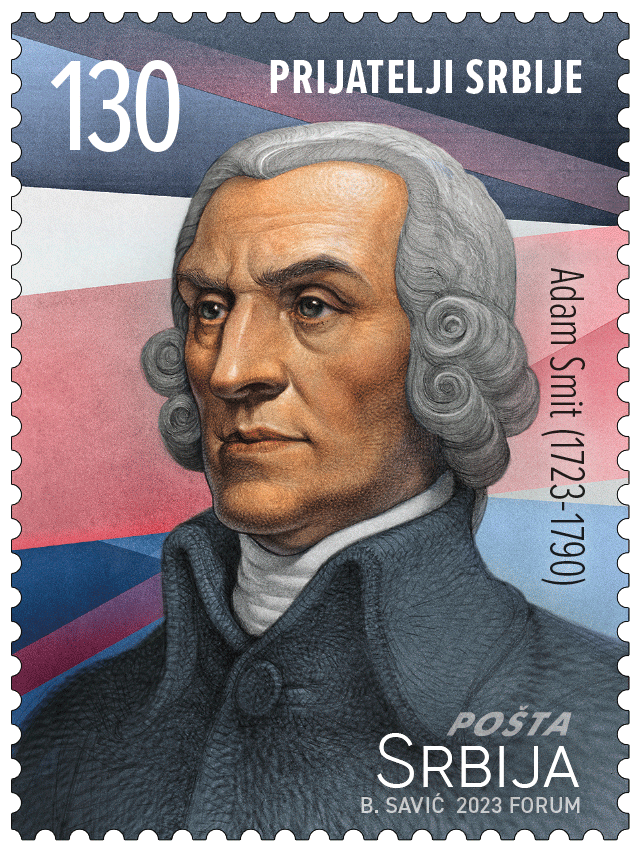
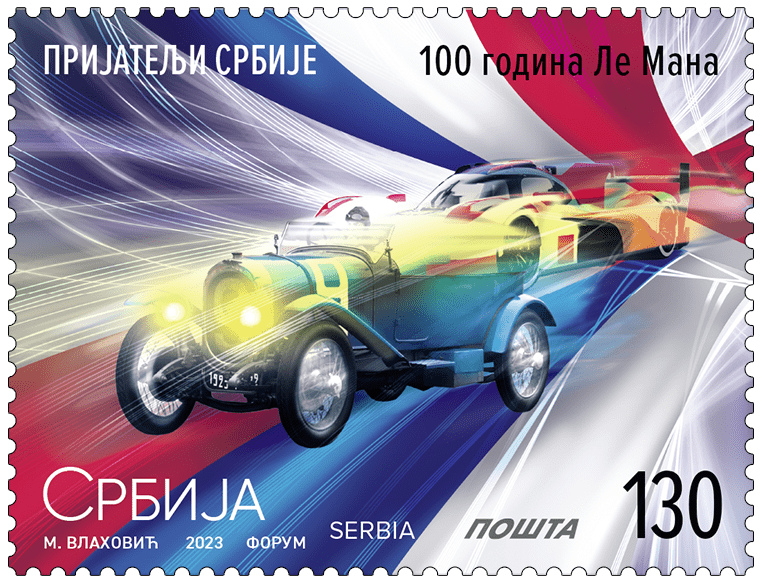
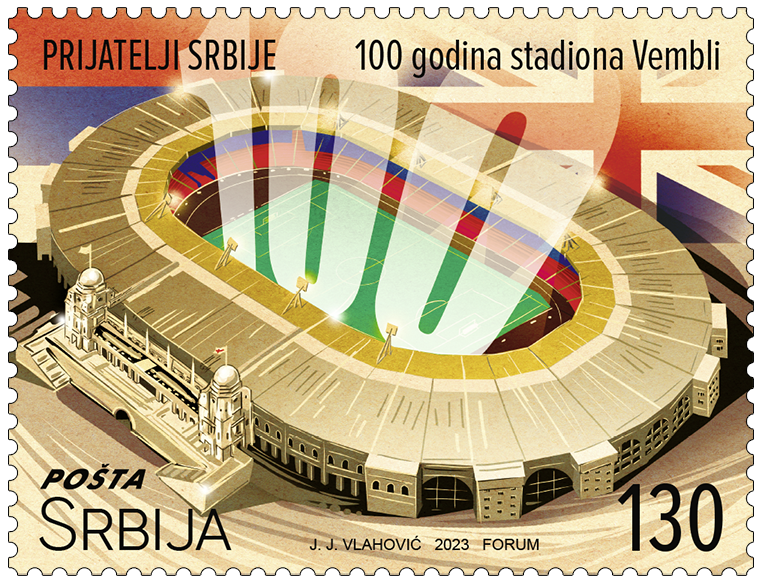
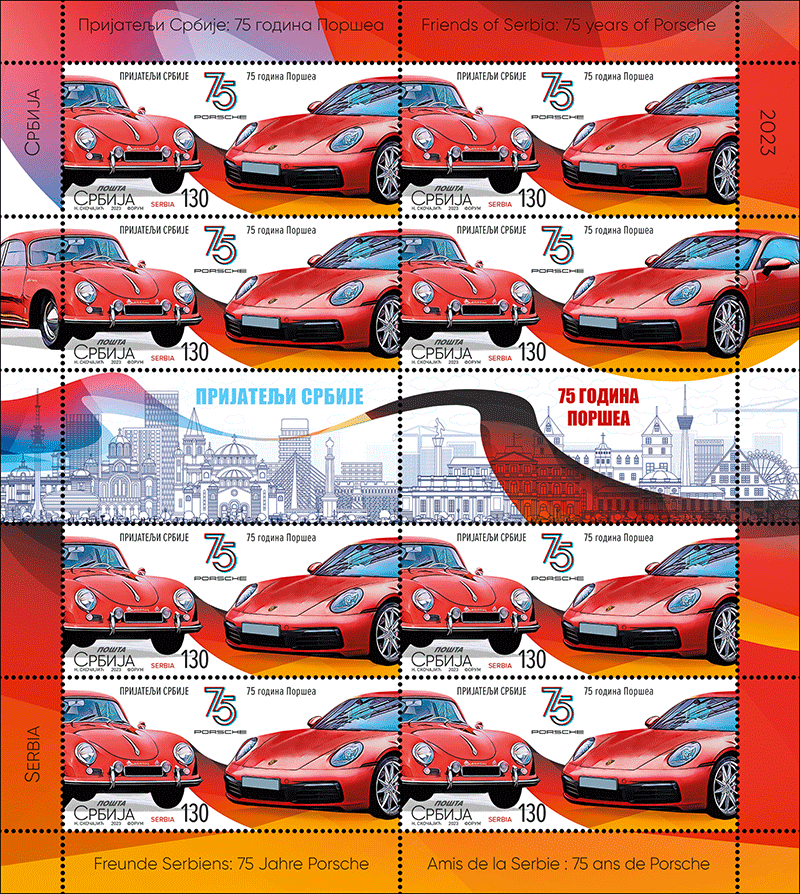
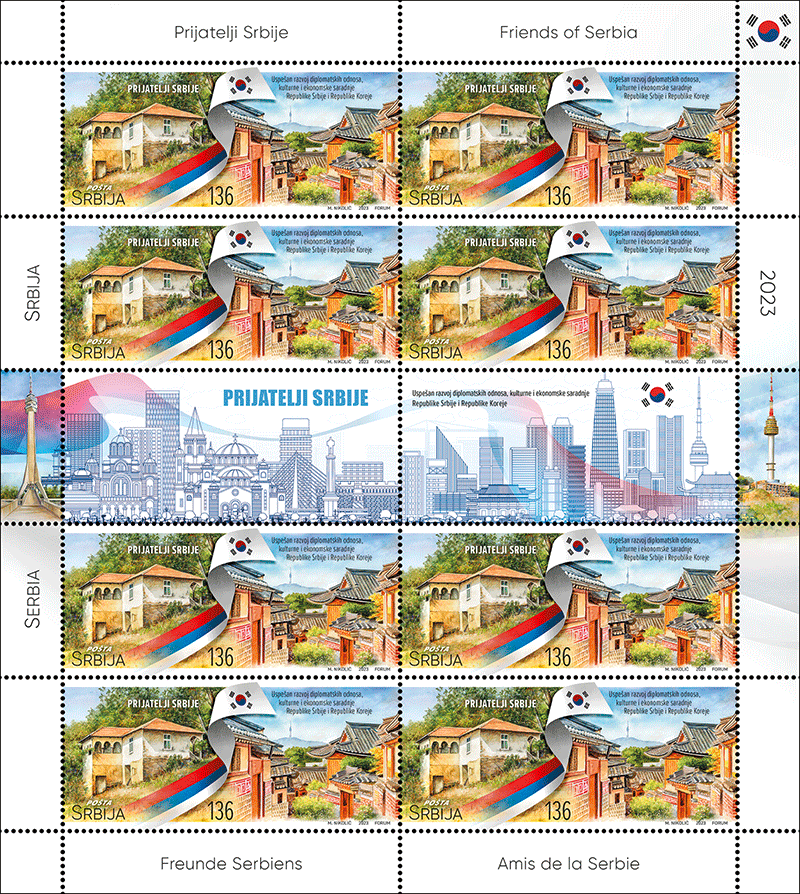
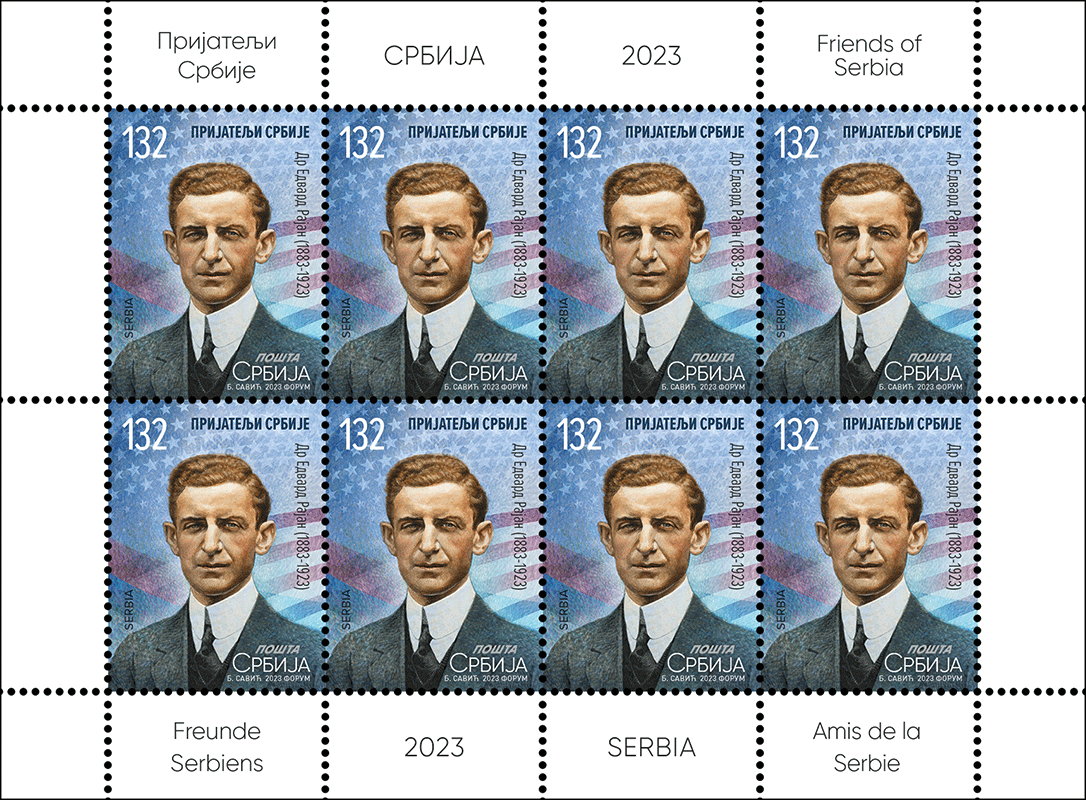
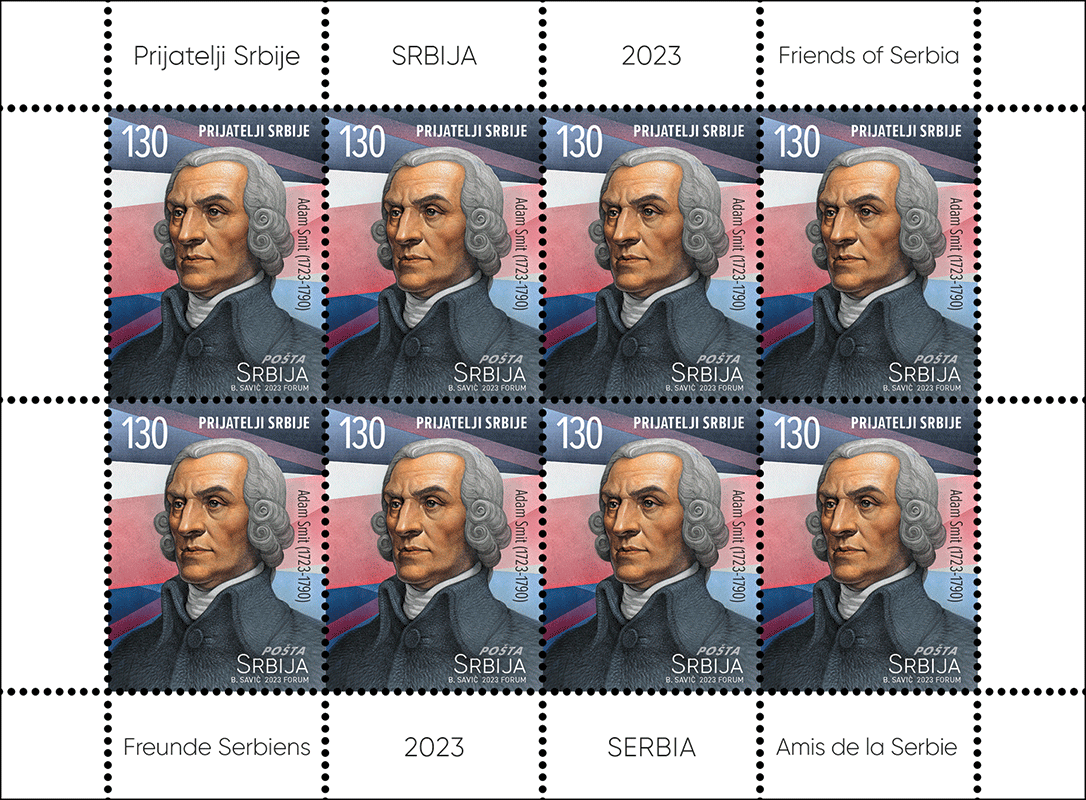
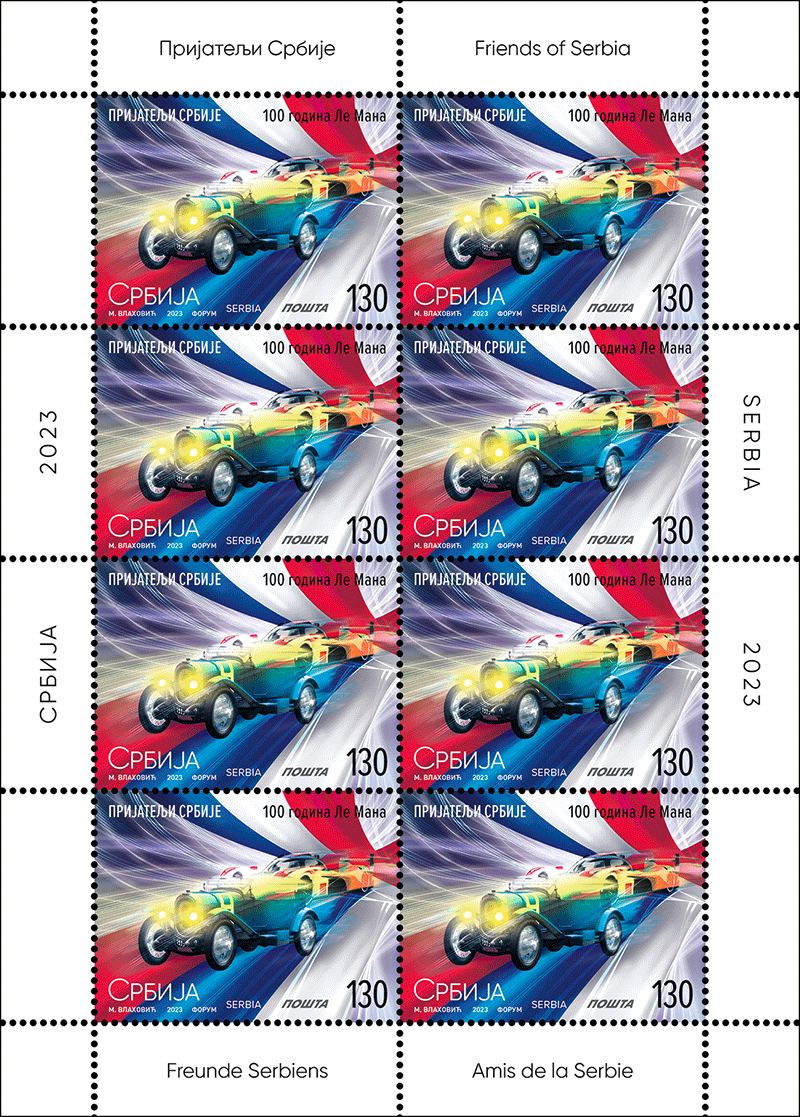
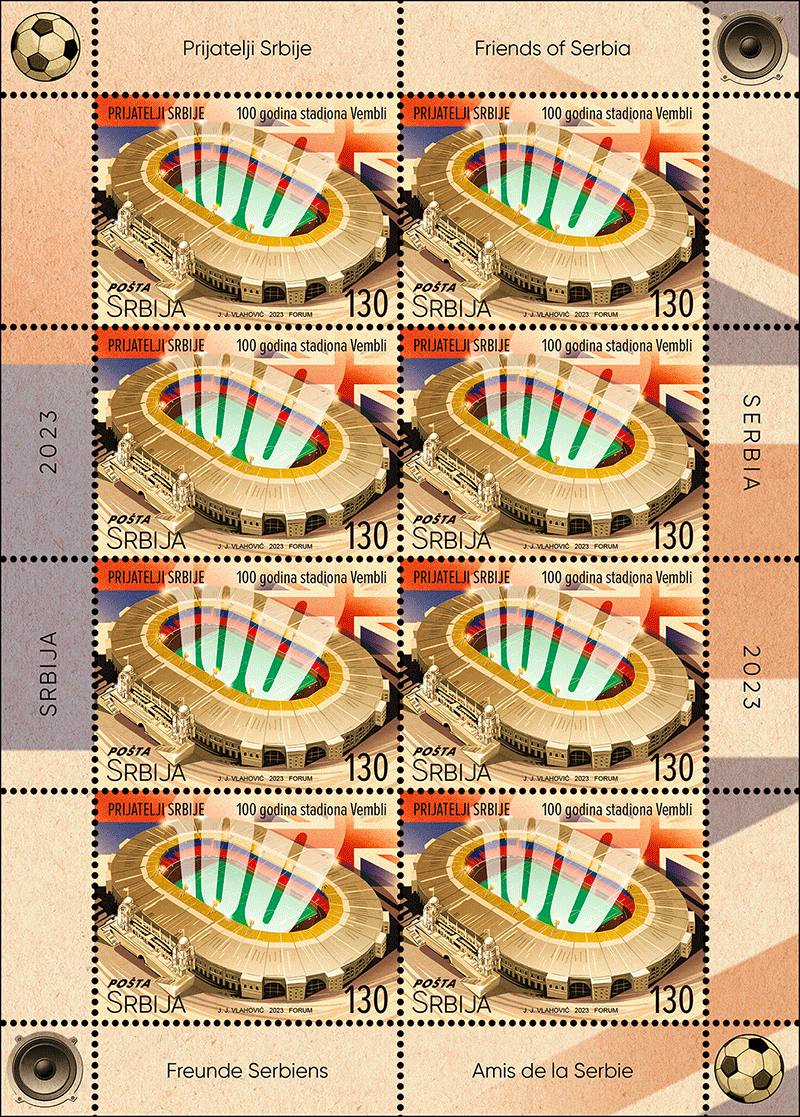
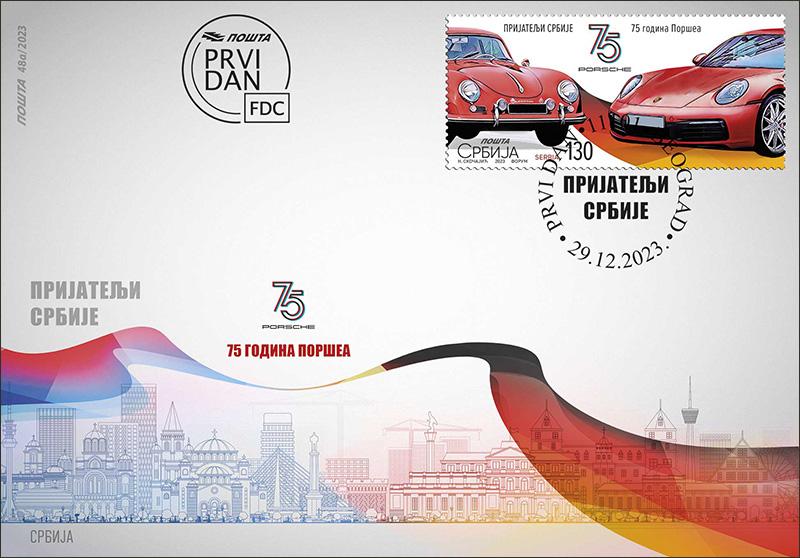
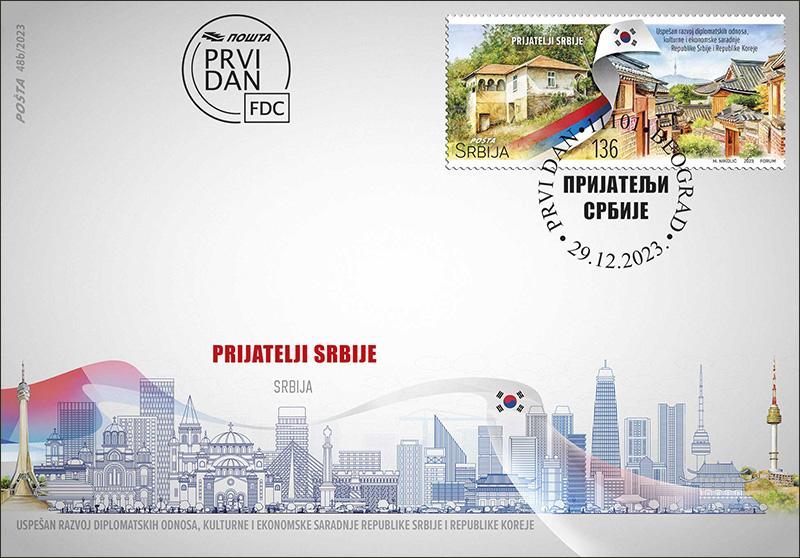

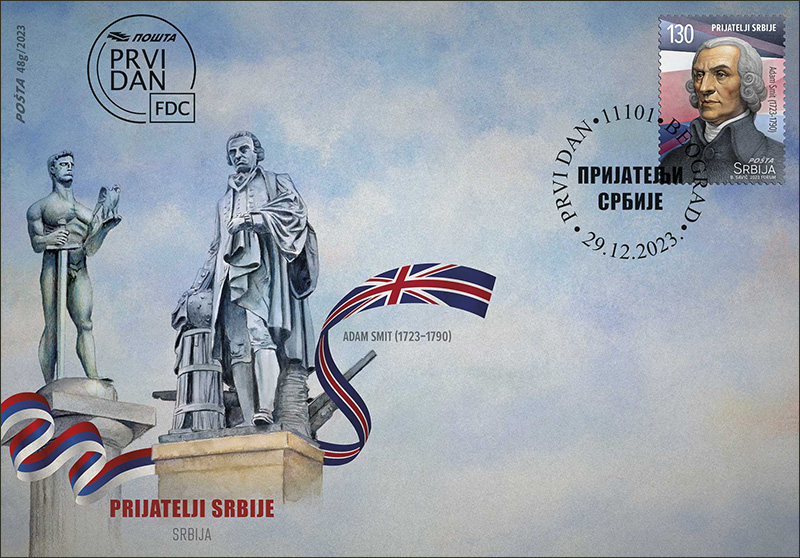
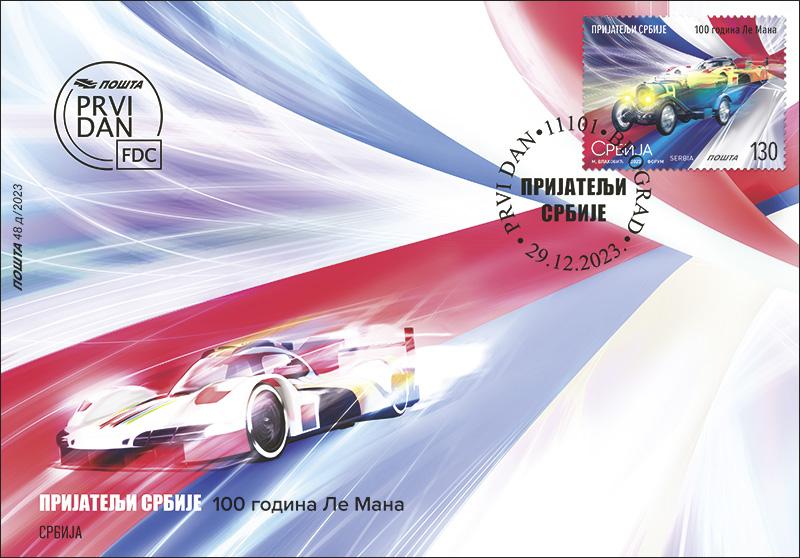


75 years of Porsche
With the desire to express the importance of the economic ties between Serbia and Germany, PE “Pošta Srbije” (Post of Serbia) issues a commemorative postage stamp on the occasion of the great jubilee of the German car manufacturer - 75 years of Porsche sports car. Synonymous with superior engineering, quality, luxury and reliability, the Porsche company best reflects the trust that customers of German companies' products and services have in Serbia and the reputation they enjoy in our country.
Postage stamp motif: Porsche 356 coupé, the first sports car of the Porsche company, constructed in 1948; Porsche 911 model 992, the company's latest sports car, in production since 2019; the company's original jubilee logo.
Motifs on the rands: the silhouette of Stuttgart, the headquarters of the Porsche company and the silhouette of Belgrade; the original logo of the Porsche company and the jubilee logo.
Expert collaboration: Porsche SCG d.o.o. and "Svetozar Marković" University Library, Belgrade.
Graphic realization: MA Nadežda Skočajić, Academic Graphic Artist
Successful development of diplomatic relations, cultural and economic cooperation between the Republic of Serbia and the Republic of Korea
Successful bilateral cooperation and good and friendly relations between the Republic of Serbia and the Republic of Korea have lasted since the establishment of diplomatic relations in 1990, and in recent years these relations have been characterized by the intensification of high-level political dialogue and improvement of overall cooperation, especially on the economic level.
From the beginning of the sixties of the last century until today, South Korea has experienced exceptional economic growth, which has placed this country in one of the 15 largest economies in the world, hence the economic cooperation between the Republic of Serbia and the Republic of Korea is growing, especially in the area of investments by South Korean companies in Serbia, which have had a significant upward trend in recent years.
Decades of fruitful economic and cultural cooperation and mutual assistance between the two countries during the coronavirus pandemic strengthened the foundations for the further expansion of bilateral relations between Serbia and South Korea, and trade, energy, eGovernment, waste management, agriculture, education, culture and tourism are just a few from areas in which the two countries have common interests.
The record volume of trade between the two countries that was achieved in previous years, the improvement of cooperation in the field of tourism by signing the Agreement on air transport between the two countries, and the improvement of cooperation in the field of culture, art and education, along with intensive political dialogue and mutual understanding, are a guarantee of stability and progress in the field of diplomatic relations between the Republic of Serbia and the Republic of Korea and in the following decades.
Expert collaboration: ”Svetozar Marković” University Library, Belgrade
Artistic realization: Miroslav Nikolić.
Dr. Edward Ryan (1883-1923)
Dr. Edward Ryan, an American physician of Irish origin (Scranton, Pennsylvania, 14 December, 1883 - 18 September, 1923, Tehran) was an extraordinary person who left an indelible mark on history, especially when it comes to his role during the First World War and helping the Serbs.
He gained a reputation as a fearless doctor, humanitarian and diplomat in the civil wars in Mexico and Russia, and especially in the Great War in Europe. During the First World War, Serbia faced severe challenges, including occupation and mass casualties. Dr. Ryan recognized the need for urgent medical assistance to the brave Serbian army and people and immediately went into action. With two surgeons and 12 nurses, on behalf of the American Red Cross, he arrived in half-destroyed Belgrade on 16 October, 1914, where he organized a hospital for the treatment of the wounded and civilians.
His devotion and dedication to medical care and saving lives was impressive. During the war, he operated on more than eight thousand people, he also fought typhus, saving tens of thousands of lives. Dr. Ryan and his colleagues worked under extremely difficult conditions, often without sufficient medical equipment and resources, but their dedication and commitment brought hope and relief to thousands of wounded soldiers. In addition to medical aid, Dr. Ryan informed the American public about the reality of the war in the Balkans with his authentic letters and reports, raising awareness among Americans about the suffering of the Serbs.
The Kingdom of Serbia decorated him with the Order of the White Eagle, the Republic of France presented him with the Legion of Honour, but he also received the decoration of Austria-Hungary because he took care of the Austro-Hungarian wounded when the Austro-Hungarian army retreated from Belgrade. Dr. Edward Ryan remains an unforgettable figure in Serbian history, a symbol of friendship and solidarity between the USA and Serbia in difficult times, and his selfless commitment to the rescue and treatment of Serbian soldiers during the First World War left a deep and lasting mark on the history of the two nations.
Expert collaboration: “Svetozar Marković” University Library, Belgrade.
Artistic realization: Boban Savić MA, academic painter.
Adam Smith (1723-1790)
Adam Smith (Kirkcaldy, June 16, 1723 - Edinburgh, July 17, 1790) was a Scottish economist, philosopher and ethicist whose contributions to economic theory left a deep and lasting impact on the development of modern economic ideas and systems. Smith was one of the most influential thinkers of the 18th century, and his most famous work, The Wealth of Nations, published in 1776, is a classic of economics and political economy literature.
Adam Smith was a prominent Scottish thinker whose works shaped our understanding of economic theory and practice. His idea of the invisible hand and advocacy of the free market remain key components of contemporary economic thought and political systems. In his Wealth of Nations, Smith developed key concepts that shaped the way we understand economics. One of those concepts is the "invisible hand". Namely, Smith argued that, although people often act for selfish reasons, the market directs them to serve the general interest with their actions. In other words, the market has the ability to self-organize and self-correct. Smith also promoted the idea that a free market, in which trade and competition are unimpeded, leads to economic efficiency and growth in wealth, and this idea is the basis of capitalism as an economic doctrine today.
In addition to his economic contributions, Smith also considered moral philosophy. In his earlier work "The Theory of Moral Feelings", he investigated the natural basis of moral feelings and the creation of moral values. He worked as a professor at the University of Glasgow and left a profound impact on many generations of economists and philosophers, and his ideas continue to be the subject of academic discussions and political debates around the world today.
Expert collaboration: “Svetozar Marković” University Library, Belgrade.
Artistic realization of the stamp: Boban Savić MA, academic painter. Artistic realization of the envelope: Miroslav Nikolić.
100 years of the "24 Hours of Le Mans" car race
The "24 Hours of Le Mans" race is one of the most prestigious car races in the world, and its rich history spanning a century began in 1923, precisely in Le Mans. The idea for the race came from journalists and promoters Charles Farroud and George Durand. The first race, in which 33 teams participated, was an opportunity for car manufacturers to test their vehicles in extreme conditions. The first Le Mans races were dominated by British and Italian teams and drivers - Bugattis, Bentleys, Alfa Romeos... After an interruption during the Second World War, the race was held again in 1949, attracting more and more visitors and teams from all over the world.
The golden era of the "24 Hours of Le Mans" was the period during the 1960s, when the epic sports battles between Ferrari and Ford were held, and this era will be remembered for four consecutive wins by Ford with the GT 40 model in the period 1966-1969. The 1970s and 1980s bring the dominance of Porsche with the 917 and 956/962 models, Audi's successful attempts to participate in endurance racing with cars powered by diesel fuel, the entry of Toyota, Peugeot and numerous other manufacturers into endurance racing...
Over the course of a century, many drivers became legends of this race, among them the most famous Jackie X, Phil Hill, Derek Bell, Frank Biella and the most successful in the history of this race ever - "Mr. Le Mans" - Tom Christensen with the greatest number of victories in history these races - a total of nine victories from the debut race in 1997 to the last triumph achieved in 2013.
Expert collaboration: “Svetozar Marković” University Library, Belgrade.
Artistic realisation: MA Marija Vlahovic, academic graphic artist.
100 years of Wembley Stadium
One of the most famous sports buildings in the world, Wembley Stadium in London, this year marks the centenary of its rich history, which it entered immediately after its opening in 1923 during the FA Cup final between Bolton Wanderers and West Ham United, better known as the "white horse final ". This match got its name from the white police horse Billy who, due to the huge number of spectators (estimated to be around 200,000) "cleared" the congested surroundings of the stadium and the stadium itself, so that King George V could attend the match.
Wembley Stadium has hosted four FIFA World Cups, in 1930, 1966, 1996 and 2018, and the 1966 final would also go down as the moment England won their first and only World Cup.
In addition to football, Wembley also hosted dog races before the Second World War, rugby union cup finals, boxing matches, motorcycle races, and history records that the first television broadcast of the FA Cup final from Wembley was in 1938.
The first post-war Olympic Games in 1948 were also held at Wembley, and the spotlights shone for the first time in 1955 on the football match between England and Spain, while in 1961 one of the most amazing competitions in the history of Wembley was held - the night ski jumping competition! On the centenary of the Football Association of England, in 1963, Wembley got a roof, and in 1969, the audience saw and heard musicians for the first time, at a concert by the group YES. Pope John Paul II celebrated mass at Wembley in 1982, and in 1985 Wembley was one of the hosts of the global music event - the Live Aid concert.
It entered the new millennium stadium after the last match played in 2000, so that the new Wembley Arena was officially opened in 2007 with a match between England and Germany. Today, Wembley is owned by the Football Association of England (FA), hosts the FA Cup final and is the home stadium of the England national football team.
Expert collaboration: “Svetozar Marković” University Library, Belgrade.
Artistic realization of the issue: MA Jakša Vlahović, academic graphic artist
Bata Živojinović – film art great
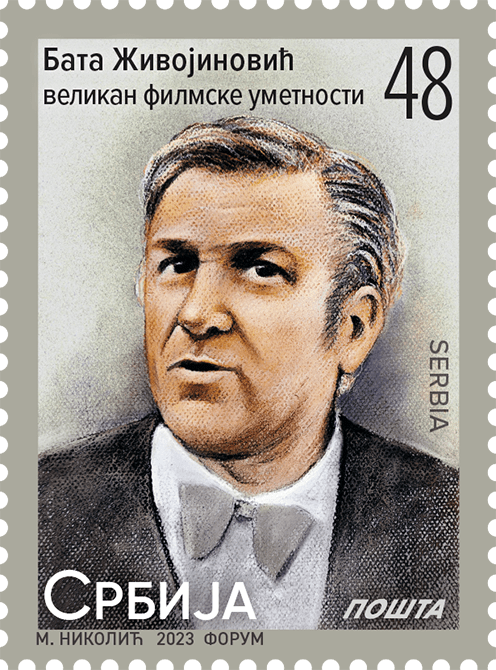
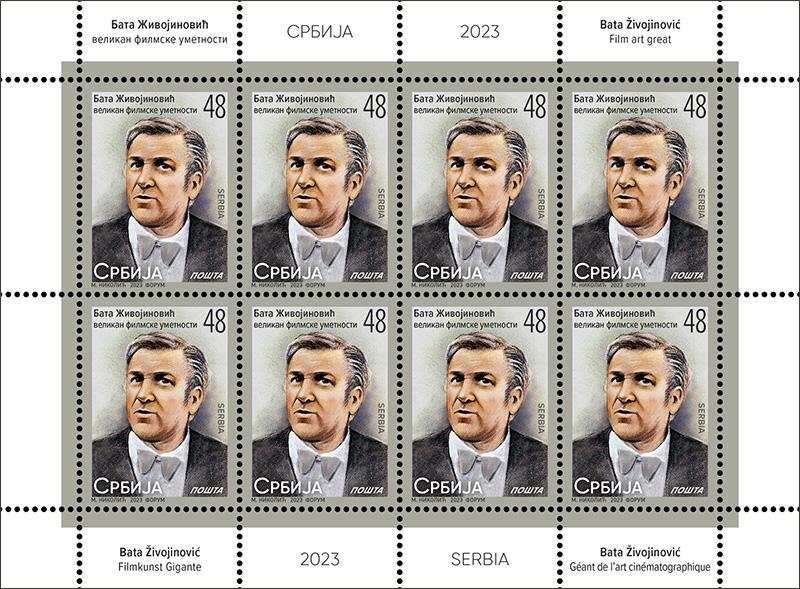
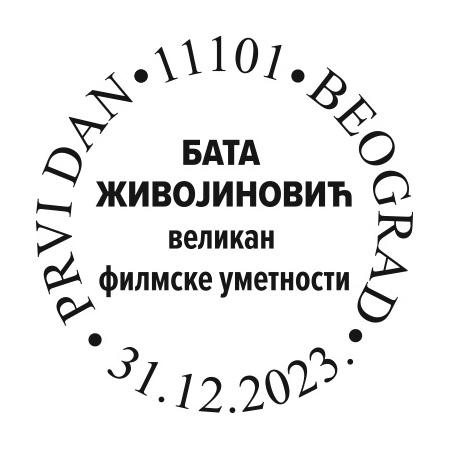
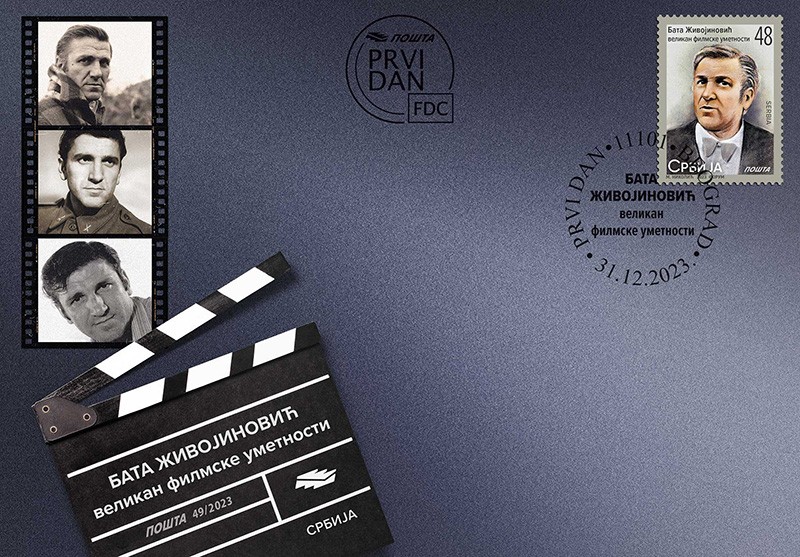
Velimir Bata Živojinović (Jagodina, June 5, 1933 – Belgrade, May 22, 2016) is a Serbian and Yugoslav actor, a superhero of the local acting scene, one of the cult actors from our region.
The protagonist of numerous film and television roles, since his debut on the big screen in 1955 in the film "Song from Kumbara", Bata Živojinović has been omnipresent in our homes and our lives. Viewers remembered and loved him the most for his numerous roles in partisan films, enjoyed his roles in television series, and many remember him as one of the main protagonists of the film black wave in our cinematography.
There are numerous films and series that he recorded, there are many main and episodic roles that he played, but in all of them he was - Bata.
Firm and honest, characterful in the roles of positive as well as negative characters, unwavering and direct both when he is wrong and when he is right, with his numerous leading roles and episodes he created the archetype of a man from these areas, a character with whom generations of people from these areas were growing up.
Between two calendar years - the outgoing one, in which we count five decades since the premiere of the movie "Sutjeska" and the upcoming one, in which we celebrate the 55th anniversary of the premiere of the movie "The Bridge" and half a century since the television premiere of the cult series "Walter Defends Sarajevo", we pay tribute with this stamp to Velimir Bata Živojinović, a giant of our acting scene and one of the main protagonists of our film lives.
Artistic realisation: Miroslav Nikolić
Каталошке информације
31. децембар 2023.
Artistic realisation: Miroslav Nikolić
1298. 48,00 дин (вишебојна) 25.000
Табак: 8
На коверту са жигом ПД (FDC)
Нацрт: 1298. портрет Велимира Бате Живојиновића
Величина марака : 26,1 x 35 mm